UNIT 1 THE PROBLEM OF A FARM BUSINESS AND THEIR SOLUTIONS
UNIT 2 THE PRINCIPLES OF FARM BUSINESS
UNIT 3 RISKS IN FARM A BUSINESS
UNIT 4 THE PROBLEMS OF AGRICULTURAL MARKETING AND THEIR SOLUTIONS
UNIT 5 SOIL EROSION
UNIT 6 SOIL NUTRIENTS
UNIT 7 IMPROVING SOIL FERTILITY
UNIT 8 INDIGENOUS FARM MACHINERY AND TECHNOLOGIES
UNIT 9 MODERN AGRICULTURAL TECHNOLOGIES
UNIT 10 THE IMPORTANCE OF FRUITS
UNIT 11 ENVIRONMENTAL CONDITIONS AND LAND PREPARATION FOR FRUIT PRODUCTION
UNIT 12 FRUIT PROPAGATION
UNIT 13 THE ESTABLISHMENT OF AN ORCHARD
UNIT 14 FERTILIZER APPLICATION, WEEDING AND PRUNING OF FRUIT TREES
UNIT 15 PEST AND DISEASE MANAGEMENT IN FRUIT TREES
UNIT 16 HARVESTING FRUITS
UNIT 17 THE IMPORTANCE AND TYPES OF FISH SUITABLE FOR FARMING
UNIT 18 POND CONSTRUCTION
UNIT 19 STOCKING AND FEEDING FISH
UNIT 20 PARASITES AND PREDATORS OF FISH
UNIT 21 POND MAINTENANCE
UNIT 22 FISH HARVESTING AND MARKETING
UNIT 23 THE IMPORTANCE AND BREEDS OF GOATS
UNIT 24 HOUSING AND FEEDING IN GOATS
UNIT 25 DISEASES AND PARASITES IN GOATS
UNIT 26 THE IMPORTANCE AND BREEDS OF CATTLE
UNIT 27 HOUSING AND FEEDING IN CATTLE
UNIT 28 DISEASES AND PARASITES IN CATTLE
UNIT 29 AGROFORESTRY PLOT ESTABLISHMENT
UNIT 30 AGROFORESTRY PLOT MANAGEMENT
REFERENCE
UNIT 1 THE PROBLEMS OF A FARM BUSINESS AND THEIR SOLUTIONS
THE PROBLEMS OF FARM BUSINESS
- what to produce
- how to produce
- when to sell
- where to sell
- how much to produce
- when to produce
SOME OF THE SOLUTIONS TO FARM BUSINESS PROBLEMS
- What to produce
- The farmer should produce where the market is readily available
- The farmer should produce where the roads are near and passable
- The farmer should produce where the climatic conditions are favourable
- How to produce
- the farmer should aim at using methods or technologies that are cheaper and yet profitable
- When to sell
- farmers should sell their commodities when the price is high
- When to produce
- farmers should produce throughout the year by using irrigation during the dry season
- farmers should produce when the commodities are scarce for a higher price
UNIT 2 THE PRINCIPLES OF A FARM BUSINESS
In order to solve the problems of farm business such as what to produce, how to produce, when to produce, when to sell and where to sell, some principles of agricultural production can be applied.
These principles are:
- comparative advantage
- substitution of inputs
- demand and supply
- Comparative advantage
Farmers should engage in the enterprises which are best suited in their areas in order to produce more.
The production will be increased if farmers engage in those activities for which they have the greatest advantage over others.
The principle encourages farmers to specialize in enterprises that are suited in their areas. This principle is applied to solve the problems of what to produce and where to produce.
- Substitution of inputs
The principle of substitution of inputs guides the farmer in choosing the better inputs, resources, technology or method of production.
Farmers should substitute an input, resource, technology or method for another if it:
- reduces costs but produces the same level of production
- has the same cost but increases production
A farmer can decide to weed a maize garden by either spraying herbicides or hoeing out the weeds.
A farmer can also decide to improve soil fertility by either applying inorganic fertilizers or organic fertilizers.
This principle is applied to solve the problems of how to produce and how much to produce.
- Demand and supply
Demand is the quantity of a commodity required by buyers. Supply is the quality of a commodity available for sale.
The price of a commodity is determined by both demand and supply for it.
If the demand for a commodity is greater than the supply, the price will be high. If the supply of a commodity is greater than the demand, the price will be low.
The actual price of a commodity is determined when demand and supply are equal.
This principle is applied to solve the problems of what to produce, how much to produce, where to sell and when to sell.
UNIT 3 RISKS IN FARM BUSINESS
THE MEANING OF THE TERM 'RISKS' IN A FARM BUSINESS
Risks are unpredictable or unforeseeable occurrences that negatively affect agricultural production or profits.
RISKS ASSOCIATED WITH A FARM BUSINESS
- weather changes
- fire
- pests and diseases
- price changes
- floods
- policy changes
RISK MANAGEMENT
There are various ways of coping with risks in a farm business.
Some of them are as follows:
- insurance
- enterprise diversification
- market research
- contract production
- use of appropriate agricultural practices
UNIT 4 THE PROBLEMS OF AGRICULTURAL MARKETING AND THEIR SOLUTIONS
PROBLEMS OF AGRICULTURAL MARKETING
Some of the problems of marketing agricultural products are as follows:
- bulkiness of farm produce
- seasonality of produce
- perishability of products
Solutions to the problems of agricultural marketing
Problem |
Possible solutions |
Bulkiness of farm produce |
eggs in trays |
|
special trucks for cattle |
Seasonality of production |
better price |
Perishability of produce |
|
UNIT 5 SOIL FERTILITY
Meaning of the term 'soil fertility'
Soil fertility is the ability of a soil to supply adequate water, air and nutrients in proper balance for plant growth and development.
Characteristics of fertile and infertile soils
Characteristics |
Fertile soil |
Infertile soil |
Nutrient availability |
High |
Low |
Organic matter content |
High |
Low |
Soil texture |
Medium |
Too course or too fine |
Soil structure |
Crumb or granular |
Compact or course |
Soil depth |
Deep soils (especially top soil layer) |
Shallow soils |
Drainage |
Adequately well-drained |
Poorly drained |
Presence of micro-organism |
High |
Low |
Plant growth |
Rapid or vigorous |
Slow and stunted |
UNIT 6 SOIL NUTRIENTS
SOIL NUTRIENTS
Plants require different elements for normal growth and production.
Some of these are non-mineral elements supplied by air and water. The other mineral elements are obtained from the soil.
CLASSIFICATION OF NUTRIENTS
Nutrients can be classified into major and minor types.
MAJOR NUTRIENTS
These are nutrients required by the plants in large quantities.
These include: nitrogen, phosphorus, potassium, calcium, magnesium and sulphur.
MINOR NUTRIENTS
These are nutrients required by the plants in small quantities.
These are iron, boron, copper, manganese, chlorine, molybdenum and zinc. These are also called trace elements.
Functions of some of the major nutrients
Nutrients |
Functions |
phosphorus |
|
potassium |
|
potassium |
|
DEFICIENCY SIGNS OF MAJOR NUTRIENTS IN CROPS
This are signs that appear in plants when a nutrient is lacking. Such signs can be corrected by applying a fertilizer that contains the lacking nutrients.
Deficiency signs of some major nutrients
Nutrient |
Deficiency signs |
nitrogen |
|
phosphorus |
|
|
|
potassium |
|
UNIT 7 IMPROVING SOIL FERTILITY
WAYS OF IMPROVING SOIL FERTILITY
- Practising mixed cropping
Mixed cropping involves growing different crop in in the same field during the growing season.
For instance in the same garden the following crops may be planted together: maize, sorghum, beans, cassava and pigeon peas.
Soil fertility will be improved because a lot of organic matter is produced. This organic matter holds and binds fine soil particles which improves soil structure.
Some crops may fix nitrogen with increases nutrient content in the soil.
- Agroforestry
Trees are grown together with arable crops on the same piece of land.
This improves soil fertility in the following ways:
- leguminous trees fix nitrogen which is one of the of the major nutrients in the soil
- there is effective ground cover which reduces evaporation and soil erosion
- nutrients are recovered by deep rooted crops from subsoil to topsoil layer
- Application of mature
Different types of manure such as farm yard, compost and green mature can be applied to the soil. These improve nutrient content, drainage and soil structure.
- Practising crop rotation
This involves growing different types of crops on the same piece of land one after the other following a defined pattern.
If legumes are included, they fix nitrogen, soil erosion is reduced when cover crops such as pumpkins and dwarf beans are planted.
- Fallowing
This means leaving the land uncultivated for some time so that bush grows. This increases organic matter.
COMPOST MANURE
Compost refers to plant and organic wastes which has decomposed.
HOW TO MAKE COMPOST
- measure 1.5 to 2 m diameter on a clear ground
- fix a 2m stick in the centre of the circle
- heap a 30 cm thick layer of chopped organic matter
- add a 3-5 cm layer of chicken manure to encourage decomposition by bacteria
- add a layer of soil to a depth of 5-8 cm
- water adequately until it oozes out when the organic matter is squeezed.
- add wood ash to reduce acid
- repeat the layers 1.5 height is reached
- reduce the diameter of the heap as more layers are added. This will result in forming in a conical shape.
- turn the heap every 7 days or place several sticks close to the base of the stack and several others heights. These will serve as entry points for air. Air is required for effective bacterial work.
IMPOTANCE OF IMPROVING SOIL FERTILITY
- nutrients content of the soil is increased
- when more organic matter is added to the soil and when leguminous plants are included
- it improves aeration of soil
- the organic matter turns into humus upon decomposition. The spongy structure of the humus promotes circulation of air in the soil.
- it improves water holding capacity of soil
- organic matter is spongy hence holds water for a long time
- it supports plants growth.
- when soil fertility is improved crops can grow well
UNIT 8 INDIGENOUS FARM MACHINERY AND TECHNOLOGIES
TYPES OF INDIGENOUS FARM MACHINERY AND TECHNOLOGIES
Indigenous farm machinery and technologies are those that are local in origin.
There are different indigenous farm machinery and technologies. These include the following:
- planting frames
- querns
- leaf bag
- ash
- soot
- winnower
PLANTING FRAMES
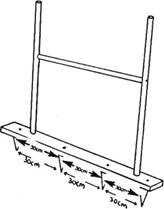
This is a plank or wood which has fixed sharp pegs positioned according to recommended spacing of a given crop.
QUERNS (MPHERO)
This is a pair of stones. One is large and the other is small. They have flat rough surfaces.
They are used for grinding grains.
The large stone could be about 60cm long and about 50cm wide.
The large stone is known as 'mother stone ' and the smaller one is known as 'daughter stone'
The grinding is achieved by placing the grains on the mother stone and sliding the daughter stone over the mother stone by forward and backward movements.
LEAF BAG (CHIKWATU)
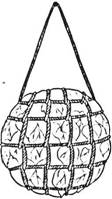
This is known as chikwatu.
It is an oval or around bag made by tying leaves together with strings.
ASH
Ash that collect after burning specific plants and trees such as amaranthus and baobab are also useful to the farmer.
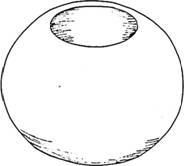
GOURD (CHIPANDA)
Large fruits of squash plants that are dried and used as containers
SOOT (MWAYE)
This refers to black powder left by smoke which accumulates above a fire place in a tradition kitchens.
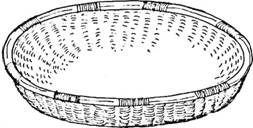
WINNOWER (LICHERO)
A flat basket made of bamboo
USES OF INDIGENOUS FARM MACHINERY AND TECHNOLOGIES
MACHINERY /TECHNOLOGY |
USES |
planting frames |
|
querns |
|
leaf bag |
|
gourds |
|
pesticides |
Ash
|
|
|
|
|
Soot
|
|
Tephrosia
|
UNIT 9 MODERN AGRICULTURAL TECHNOLOGIES
TYPES OF MODERN TECHNOLOGIES
There are many modern technologies that are used to increase agricultural production.
These includes:
- irrigation
- use of herbicides
- permaculture
- composting toilet(eco-san toilets)
IRRIGATION
This is the artificial application of water to crops when the rainfall is not adequate for the crop production.
This system helps to improve agricultural production in the following ways:
- crops can be grown throughout the year. This means farmers can harvest crops throughout the year, hence increased production.
- crops can be grown even when rain fails.
- it enables certain crops to grow in an area where they could not due to shortage of rainfall
USE OF HERBICIDES
These are chemicals that are applied in a garden to control weeds.
They help to improve agricultural production in the following ways:
- killing growing weeds
- preventing weed seeds from germinating
PERMACULTURE
Permaculture is a combination of two words, 'permanent' and 'culture'.
Permaculture aims to design sustainable systems such as building, transportation, agriculture, energy and water.
In agriculture, permaculture imitates nature where different plants and animals grow together and support each other.
Nature does not apply chemicals to improve soil fertility or kill insert pests, but allows everything to grow and produce in balance.
It also makes food available for every living thing throughout the year.
Permaculture encourages:
- growing of a variety of different species of plants and animals that are appropriate to a particular area and that support each other on the same piece of land
- improvement of soil fertility and structure through the use of organic matter and growing of plants that add nutrients to the soil as opposed to artificial chemical fertilizers that pollute the soil, water and air.
- use of natural predators to balance insect as opposed to artificial chemical pesticides or insecticides that harm people and surroundings
- mulching to suppress the growth of unwanted plants as opposed to use herbicides. Mulching also has a benefit of conserving soil and water and improving soil fertility and structure during decomposition
Permaculture involves designing the land in such a way that each plant or animal on the plot plays a role.
A combination of different species on a plot that support each other is called guild.
For example, a plot may have maize, climbing beans, onions, sweet potatoes and chickens.
The beans fix nitrogen that is used by the maize, sweet potatoes and the onions; the maize provides support to the climbing beans; the sweet potatoes cover the ground, protecting it from soil erosion and conserving moisture.
The potato tubers open up the soil for water and air that is used by the other crops including microorganisms; the onions repel harmful insects that attack plants on the plot (instead of onions, the farmer may decide to grow mpungabwi – also known as local basil – to repel insect pests).
The chickens eat insect pests, while droppings add fertility to the soil. As the chickens scratch the soil, they mix the topsoil with manure.
Permaculture as a technology improves agricultural productivity in the following ways.
- increases production since, from the same piece of land, there will be a variety of products that will be harvested at different times of the year.
- Reduces cost of buying inputs. The money saved can be used to buy other things.
- The farmer can continue producing since the production is not affected by the price of farm inputs such as fertilisers, herbicides or insecticides.
- Land will be used for production forever since there is no danger of soil exhaustion or pollution.
COMPOSTING OR TOILET
This toilet stores human faeces in a tank – unlike the ordinary toilet that leaves them to pollute underground water.
While being stored, the human faeces are decomposed into manure. There are several types of composting toilets.
Some of which are the Skyloo and the Arborloo.
SKYLOO TOILET
The toilet has a tank divided into two halves made by concrete slabs. It stores urine separate from the faecal matter.
This is because if the tank has too much fluids, it disturbs the decomposition and causes the organic matter in the tank to smell.
After each use of toilet, a handful of ash and three handfuls of soil are added. The ash prevents human faeces from producing bad smell while the soil supplies living organisms that decompose the faecal matter.
When one of the toilets is full, it is closed for six months to allow for decomposition to take place. Meanwhile the household starts using the other half.
The decomposed organic matter, which is now healthy compost is removed from the tank and applied to the soil in crop fields.
ADVANTAGES OF SKYLOO TOILET
- The Skyloo toilet does not pollute ground water which is a source of borehole water
- The Skyloo toilet saves space as one does not need to dig a new pit when one is full
- The Skyloo toilet does not produce smell and discourages flies that transmit diseases
- The Skyloo toilet improves agricultural productivity because what used to be wastes are now used to make organic fertilizer or manure that increases crop production
DISADVANTAGES OF SKYLOO TOILET
- The Skyloo toilet is too expensive to build
- The Skyloo toilet is difficult to separate urine from faeces
- Negative attitude of people to handle manure from human faecal matter
ARBORLOO TOILET
It is a shallow pit latrine with a moveable concrete slab and an outhouse on top. When the toilet is full, the slab is removed and put on another pit latrine.
The filled pit latrine is covered with soil to allow the faecal matter to decompose.
When the material is decomposed, the farmer plants a tree on top that will use the manure.
ADVANTAGES OF ARBORLOO TOILET
- The Arborloo toilet is cheaper
DISADVANTAGES OF ARBORLOO TOILET
- Arborloo toilet requires a lot of land
- Arborloo toilet is labour-intensive to dig pit latrines frequently
The arborloo toilet helps improve agricultural productivity because it makes use of manure that would be wasted underground.
This improves the production of fruits around the home.
UNIT 10 THE IMPORTANCE OF FRUITS
THE IMPORTANCE OF FRUITS
- Source of food
- Source of income
- Source of raw materials
- Source of employment
- Source of foreign exchange
- Source of medicine
CLASSIFICATION OF FRUITS
Fruits can be classified into indigenous and exotic
INDIGENOUS FRUITS
These are fruits which grow naturally in an area.
These include: matowo, maye, masawu, mateme, bwemba (tamarind), malambe (baobab).
EXOTIC FRUITS
These are fruits which were introduced into the country from other countries or areas.
These include mangoes, peaches, pineapples, oranges, strawberries, tangerines, avocado pears, guavas, bananas and pawpaws.
UNIT 11 ENVIRONMENTAL CONDITIONS AND LAND PREPARATION FOR FRUIT PRODUCTION
ENVIRONMENTAL CONDITIONS
FACTORS TO CONSIDER WHEN SELECTING SITE FOR FRUIT GROWING
- Type of soil
- Climate
- Water availability
- Land preparation
TYPE OF SOIL
Fruits require deep, fertile and well-drained soils.
CLIMATE
Some fruits grow well under hot conditions.
Such fruits include mangoes, bananas, pawpaws, guavas. Other fruits grow well in cool areas.
These include pineapples and avocado pears.
Fruits like peaches, apples and plums grow well in cold areas where the rainfall is well distributed throughout the year.
WATER AVAILABILITY
The site should be near a permanent water source for easy irrigation
LAND PREPARATION
Land preparation for fruit growing involves a number of activities such as:
- Clearing the land
- Measuring the distance between planting stations
- Digging planting holes 90cm long, 90cm wide and 90cm deep
- Filling planting holes with rich loam soil and manure
Land preparation should be done two months before the time of planting. Different fruit trees have different recommended spacing.
Spacing for different types of fruits
FRUITS |
SPACING |
Apples |
3m x 3m |
Avocado |
9m x 9m |
Bananas |
2m x 2m |
Citrus |
6m x 6m |
Mangoes |
9m x 9m |
Pawpaws |
3m x 3m |
Pineapples |
60cm x 30cm |
Peaches |
4m x 5m |
The main fruit growing areas in Malawi
FRUIT |
AREAS IN WHICH THEY ARE GROWN |
Mangoes |
Along the lakeshore and shire valley |
Pawpaws |
Along the lakeshore and shire valley |
Orange, grape, lime |
Along the lakeshore |
Tangerines |
Mwanza and Neno |
Guava |
Along the lakeshore |
Bananas |
Thyolo, Mulanje and Nkhatabay |
Avocado pears |
Thyolo, Mulanje, Zomba, Nkhatabay, Shire |
Granadillas |
Mwanza, Ntcheu and Zomba |
Strawberries |
Zomba |
Apples, peaches, plums |
Shire Highlands, Kirk Range, Ntchisi Hills, Phoka Hills |
Pineapples |
Mulanje, Thyolo, Ntchisi, Phoka, Songwe, |
UNIT 12 METHODS OF PROPAGATING FRUITS
Meaning of the term 'fruit propagation'
Fruit propagation is the process of producing new shoots or plants to be used as planting materials.
Fruit trees can be raised using seeds or vegetative parts such as suckers, buds, runners and cuttings.
METHODS OF SEED PROPAGATION
- Seed propagation
- Grafting
- Budding
- Use of stem cuttings
- Use of suckers
SEED PROPAGATION
Seed propagation is easy, cheap and quick but the resulting trees take a long time to start bearing fruits.
Seeds can be sown in pots, polythene pots and nursery beds.
GRAFTING
A shoot is cut and tied to a stem of a related plant so that the joined parts grow as one plant.
This is done in fruits such as oranges, mangoes, avocado pears, apples and peaches.
Procedure for grafting
- Select a young tree to be used as stem (root stock) to graft on
- Select a shoot from a similar fruit tree with the desired characteristics. This shoot must be of the same size as the root stock.
- Cut the chosen stems in a slanting manner so that the two stems fit well
- Join the shoot to the root stock
- Tie the two stems together using strips of plastic
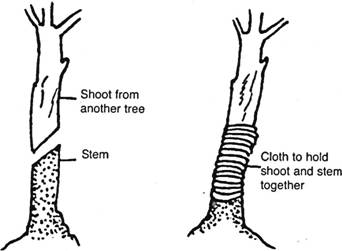
Note: Any other shoot coming from the root stock should be removed.
BUDDING
A mature bud is attached to the stem of a related fruit stem. This is done in fruits such as oranges, lemons and mangoes.
Procedure followed when budding
- Choose a stem on which to join a bud
- Make a T-slit on the stem
- Cut off a mature bud from a desired variety of fruit
- Fit the bud into the T-slit of the stem
- Tie the bud on the stem using plastic strips


Note: Remove all shoots from the stem to which the bud has been attached so that most of the nutrients are used by the new bud.
USE OF STEM CUTTINGS
Stems are cut and planted in pots, packets or nursery beds to raise new plants for fruit trees like granadilla, grapes, mulberries and strawberry.
The procedure for propagating using stem cuttings is as follows:
- Choose mature plants
- Select healthy branches
- Make cuttings of 15 to 20 centimetres long with 4 nodes or buds
- Plant the cuttings in polythene pots, packets and nursery bed
USE OF SUCKERS
Suckers are used as planting materials in fruits such as bananas, plantains, pineapples.
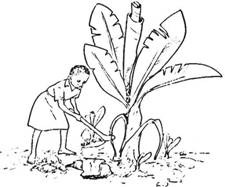
The procedure to be followed in the use of suckers
- Choose healthy suckers
- Uproot the suckers with enough roots in readiness for planting
UNIT 13 THE ESTABLISHMENT OF AN ORCHARD
TRANSPLANTING FRUIT TREE SEEDLINGS
When fruit seedlings are ready, they should be transplanted in the field.
During transplanting, the steps below should be followed:
- Dig a small hole in the middle of the planting hole
- Dig out the seedlings together with soil around the roots if seedlings are raised in a nursery bed
- Place the seedlings in the middle of the planting hole
- Remove the polythene tube
- Cover the seedlings with soil up to collar mark
- Press the soil around the plant firmly
- Mulch the seedlings
Fruit trees should be planted with the first rains.
Trees can be watered if planted in the dry season or when the rains are erratic.
UNIT 14 WEEDING, FERTILIZER APPLICATION AND PRUNING FRUIT TREES
WEEDING
WAYS OF WEEDING FRUITS
- Uprooting where the weeds are growing close to young trees
- Light hoeing when trees are young and weeds are not growing close to the trees
- Slashing when fruit trees are well-established
FERTILIZER APPLICATION
The rate of fertilizer application to fruit trees in gram per year per tree
Age of tree (year) |
CAN |
Triple superphosphate |
Muriate of potash |
1 |
100 |
20 |
125 |
2 |
200 |
40 |
250 |
3 |
300 |
60 |
375 |
4 |
400 |
80 |
375 |
5 |
500 |
100 |
625 |
6 |
600 |
120 |
750 |
7 |
700 |
140 |
875 |
8 |
800 |
160 |
1000 |
9 |
900 |
180 |
1125 |
10 |
1000 |
200 |
1250 |
11 |
1100 |
220 |
1500 |
12 |
1200 |
240 |
1625 |
13 |
1300 |
260 |
1750 |
14 |
1400 |
280 |
1875 |
15 |
1500 |
300 |
2000 |
16 |
1600 |
320 |
2000 |
PRUNING
Fruit trees should be pruned.
This improves the yield and quality of fruits since nutrients are not wasted by unproductive branches. When pruning, dead, broken, rubbing and diseased branches should be removed.
The steps to follow when pruning fruit trees
- Identify the dead, broken, rubbing and diseased branches
- Cut the branches starting from the bottom going upwards using sharp tools such as pangas, saws and axes
UNIT 15 PEST AND DISEASE CONTROL IN FRUIT TREES
COMMON FRUIT PESTS AND DISEASES AND THEIR CONTROL
Common fruit pests and their control
Name |
Fruit attacked |
Signs/damage |
Control |
False coding moth |
Citrus, avocado pears |
Makes holes in the skin of the fruit |
sugar and water |
White fly |
Citrus fruits |
Sucks juice from fruits |
wasps that destroy the larvae of white flies |
Aphid |
All fruits |
Sucks juice from leaves |
Carbaryl or malathion |
Mealy bug |
Citrus, pineapple, guavas |
Sucks sap from leaves, fruits and stems |
enemy for example ladybird beetle |
Fruit fly |
Mangoes, peaches, citrus fruits |
Premature ripening of fruits |
|
Common fruit diseases and their control
Name |
Fruit attacked |
Signs/damage |
Control |
Bacterial spot |
Mangoes |
Small yellow leaf spots that turn brown or black on |
Spraying with copper oxychloride |
Anthracnose |
Mangoes, pawpaws |
Small circular dark brown |
Spraying dithane M45, |
Rusts |
Peaches |
Brown spots surrounded by a yellow band on the |
Spray dithane M45 20g in 10 litres of water |
UNIT 16 HARVESTING FRUITS
Fruits must be harvested at the right time and in the right way to avoid losses which occur when the fruits are harvested too early or too late.
When harvesting fruits, use appropriate methods to reduce bruising, cracking and breaking of fruits.
Signs of maturity and methods of harvesting different fruits
Fruits |
Signs |
Methods of harvesting |
Citrus |
Rind changes to either orange, yellow |
Pick fruits by pulling individual fruits |
Mango |
Colour of fruit skin changes to either purple, yellow or orange depending on |
Pluck fruits by hand and put them in a harvesting basket or bag |
Pawpaw |
Colour of fruit skin changes to yellow |
|
Banana |
Fruits become plump and round and some turn yellow. |
Cut the bunch stalk carefully and fell the stem |
Pineapples |
Fruits turn yellow. |
Cut the fruit at the base of the stalk |
Avocado |
Seed shakes inside the fruit |
Pluck the fruits using hands |
Guava |
Colour of fruits change to yellow and |
Pick the fruit of the plant by hand |
Strawberry |
Fruits turn red |
Pick fruits carefully with stalk attached |
UNIT 17 THE IMPORTANCE AND TYPES OF FISH SUITABLE FOR FARMING
THE MEANING OF THE TERM 'FISH FARMING'
Fish farming is the practice of raising fish in ponds.
THE IMPORTANCE OF FISH FARMING
- Source of food
- Source of income
- It makes good use of the land
- It supplements fish caught in rivers and lakes
- Source of raw materials
CHARACTERISTICS OF FISH SPECIES SUITABLE FOR FARMING
- Must grow fast to search a harvestable size within a short period of time
- Must be able to feed on locally available feeds
- Must reproduce under pond conditions
- Must have eggs, fries and fingerlings which can survive under pond conditions
- Must have acceptable taste and flavour to consumers
- Must be easy to handle when harvesting
- Must be resistant to parasites and diseases
Some fish species suitable for farming:
- Makumba
- Mphende
- Mlamba
- Chambo
- Chilunguni
- Makakana
CHARACTERISTICS OF SOME FISH SPECIES THAT ARE SUITABLE FOR FARMING
Makumba
- Short reproduction cycles
- Adapts to a wide range of environmental conditions
- Makes its nests in shallow waters
- Breeds easily in ponds
- Takes a wide variety of food items
Chambo
- Favours fresh water
- Favours high lands
- Salinity tolerance
- Slow growth and maturity rates
- Favours large ponds
- Low survival rate
- Has its own breeding season
Mlamba
- Grows faster
- Resistant to handling stress
- Salinity tolerance
- Can withstand poor water quality
- Can withstand overcrowding
- It feeds on both plants and animals
Chilunguni
- Adapts to all water bodies in Malawi
- Tolerates wide range of temperatures
- Survives in salty water
- Feeds on green plants
Mphende
- Takes a wide variety of food items
- It has a wide range of feeds
- Adapts to a wide range of environmental conditions
- Favours low land to high land areas
The characteristics of fish types suitable for farming include:
- quick multiplication
- survival under pond conditions
- disease resistant.
- Water supply
- Soil type
- Slope of the land
- Nearness to school, home or market
- Slashers
- Hoes
- Pangas
- Axes
- Tape measure
- Shovels
- Hammer
- Ropes
- Squares
- Watering cans
- Wheelbarrow
- Buckets
- Bricks
- Cement
- River sand
- Quarry stones
- The pond needs to be of medium size because large are difficult to manage and small ponds are not profitable
- The deepest end of the pond should be about 1.5 metres and the shallow end about 1 metre deep. This depth allows the growth of water plants such as plankton and algae as sunlight is able to reach the bottom
- The pond should have an inlet and outlet in addition to the overflow pipe
- The pond needs to be sited considering the direction of the prevailing winds of the area. This helps to prevent the action of water waves in the pond which erode the walls of the pond.
- Select site
- Clear the land and level the area
- Measure the area with tape measure or rope
- Mark out the area with pegs
- Remove 30cm of fertile top soil and heap it aside. This soil is used to cover the pond walls to encourage the growth of grass to cover the pond walls
- The subsoil dug should be used to strengthen the walls. The walls should be strong enough so that they do not lose water
- Fix the inlet and outlet pipes at each end of the pond when it is being constructed
- Cover each end of the inlet and outlet pipes with a screen to prevent entry of foreign fish into the pond and passing out of fish from the pond
- The bottom of the pond should be plastered with lime to control parasites
- Fill and drain the pond at least twice before stocking. This helps to check whether the walls of the pond have holes or not
- Ensure the water in the container with fingerlings is at the same temperature as the water in the pond
- Mix the water from the pond into a container with fingerlings carefully to make the temperature in the container the same as that of the fish pond.
- Slowly put the container of fingerlings into the pond to let them swim out of the container into the pond
- Large amount of uneaten food float
- Foul-looking black or green water
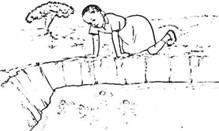
Fish swimming to the surface of water gasping for fresh air- round worms
- tape worms
- flukes
- They reduce the growth rate of fish by absorbing the digested food
- They cause losses in fish farming enterprise
- Remove the fish and drain the pond when the parasites are identified
- After draining, apply lime to the pond to kill the parasites
- Expose the drained pond to the sun to kill the parasites
- Grey herons
- King fisher
- Monitor lizards (ng’azi)
- Otters (katumbu)
- Otters and birds cause loss of up to 75% of fish in a pond. Otters usually feed at night
- Some predators act as intermediate hosts of fish parasites
- Predators destroy fries, eggs in ponds and food reserves
- Setting otter traps as they generally follow the same track, as they feed t night
- Scaring them away as in the case of herons and kingfisher
- Destroying their nests, that is, nets for herons and kingfisher
- Fencing the pond appropriately
- Maintain the water level in the pond by ensuring that the inlet, outlet and overflow pipes are functioning properly
- Check for cracks in the walls, the inlet and outlet
- Fill the cracks
- Re-build all damaged walls
- Repair all damaged drains
- Remove the excess soil from the pond to prevent the pond from becoming shallow and unsuitable for fish
- Repair the fence where necessary to keep out predators
- Keep short grass around the pond by slashing or raising dykes
- Plant new grass on the walls whenever necessary to prevent erosion of the walls
-
HARVESTING FISH
Fish must be harvested when they are ready. It takes 5 to 8 months for fish to mature.
This depends on the type of feed and fish species.METHODS OF HARVESTING FISH
- Use of a seine net
- Use of hook-and-line
- Draining water from a pond
PROCESSING FISH
Fish is processed to preserve and improve its quality.METHODS OF PROCESSING FISH
- Sun-drying
- Smoking
- Salting
- Freezing
MARKETING FISH
Fish must be graded before pricing.Grading involves sorting according to types, size and quality.
When selling the fish at the farm, it is important to advertise before harvesting so that people can come to buy the fish.
UNIT 23 THE IMPORTANCE AND BREEDS OF GOATS
THE IMPORTANCE OF GOATS
- Source of food in form of meat and milk
- Source of manure
- Source of income
- Source of raw materials
- Source of hides
- Source of social obligations
- Source of payment for dowry
- Source of payment for legal penalties in the communities
BREEDS OF GOATS
There are many breeds of goats. They are kept for different functions.
Breeds of goats and their functions
BreedFunction
Malawian goat
Meat
Boer goat
Somali goat
Anglo-Nubian goat
Milk
Toggenburg goat
Saanen goat
Angora goat
Mohair (wool)
Gaddi goat
Kamori goat
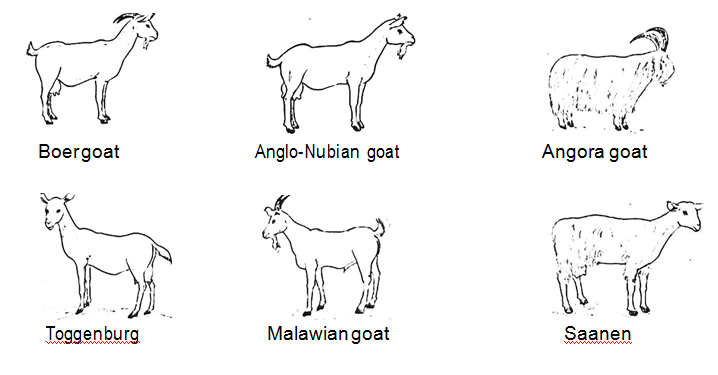
CHARACTERISTICS OF GOATS SUITABLE FOR BREEDING
- Large in size
- High milk production
- High mohair production
- Well adapted to local conditions
METHODS OF IMPROVING LOCAL GOATS
- Selection
- Crossbreeding
- Outbreeding
UNIT 24 HOUSING AND FEEDING IN GOATS
HOUSING GOATS
CHARACTERISTICS OF A GOOD GOAT HOUSE
- It should be easy to clean
- The roof should not leak
- Each goat should have enough space
- The house should be well ventilated
TYPES OF GOAT HOUSES
- Unraised pole and thatch goat house
- Raised pole and thatch goat house
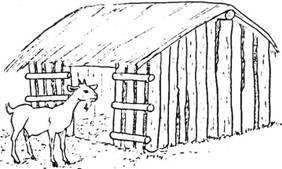
UNRAISED POLE AND THATCH GOAT HOUSE
It is made with poles which are fixed in the ground. The ground forms the floor of the house.RAISED POLE AND THATCH GOAT HOUSE
The raised pole-and-thatch goat house is constructed on a raised platform. The floor of the house is 1 metre or 1.5 metres above the ground.
It should have spaces big enough to allow droppings to fall down.This house is similar to the unraised house except that it is constructed on a raised platform.
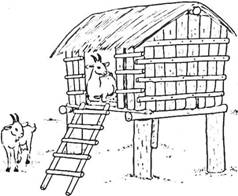
FEEDING OF GOATS
Goats must be fed on a balanced diet for them to produce more milk, meat and mohair.A variety of feed stuffs for goats include grass, leaves of trees, shrubs, sweet potato vines, sugarcane tops and maize bran.
FEEDING HABITS OF GOATS
- Grazing
- Browsing
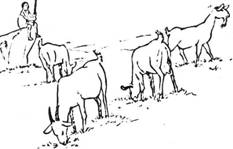
Grazing is the feeding on pasture land.Browsing is the feeding on shrubs and tender leaves of trees.

Goats like climbing trees to feed on tender leaves.
UNIT 25 DISEASES AND PARASITES IN GOATS
DISEASES OF GOATS
Diseases of goats, their signs or symptoms and control
DiseaseCause
Signs/symptoms
Control
Anthrax
Bacteria
- High fever and depression
- Swelling of the stomach
- Blood comes through the anus, nose and mouth after death
- Death after 1 to 2 days
- Mouth and eye become purple or dark
- Treating with antibiotics
- Vaccinate annually
- Burying the dead animal deep in the soil
- Not cutting any part of the dead animal
Foot and mouth disease
Virus
- High fever
- Blisters on the mouth and feet
- Saliva comes out of the mouth
- Lameness as a result of the blisters on the mouth and feet
- Severe loss of body weight
- Dullness
- Vaccination
- Restricting livestock movement
- Burning and burying the dead animal
- Quarantine
Pneumonia
Bacteria and virus
- Quick and short breathing
- Fever
- Coughing
- Providing enough ventilation in the house
- Keeping the house
clean, dry and warm
PARASITES OF GOATS
There are internal and external parasites of goats.EXTERNAL PARASITES
These are parasites which are found outside the body of the host.These include:
- Ticks
- Lice
- Fleas
- Mites

External parasites of goats, their effect and control
Lice- Sucking blood
- Skin irritation
- Anaemia
- Breaking the skin which allows entry of bacteria and protozoa
- Sanitation in the house
- Dipping or spraying goats
- Avoid overcrowding in the house
Fleas
- Sucking blood
- Skin irritation
- Anaemia
- Breaking the skin which allows entry of bacteria and protozoa
- Dipping or spraying goats
- Avoiding overcrowding in the house
- Spraying chemicals or insecticides in the house to kill fleas
Ticks
- Sucking blood
- Transmitting diseases like heartwater
- Skin irritation
- Anaemia
- Reducing the skin quality
- Breaking the skin which allows entry of bacteria and protozoa
- Dipping or spraying the goats with acaricides
- Hand picking and destroying ticks
Mites
- Sucking blood
- Skin irritation
- Breaking the skin which allows entry of bacteria and protozoa
- Applying chemicals or drugs on the skin
- General hygiene of the goat house
- Spraying the animals with chemicals
INTERNAL PARASITES
These are the parasites which feed while inside the body of the animal.These include:
- Roundworms
- Tapeworms
- Liver flukes
They are usually found in lungs, liver and intestines
Some internal parasites of goats
ParasiteEffect or damage
Control
Roundworms
- Feeding on digested food
- Blocking the intestines
- Stunted growth
- Deforming using piperazine and phenothiazine
- Keeping the house clean and dry
Tapeworms
- Damaging the liver by causing cysts
- Stunted growth
- Causing diarrhoea
- Feeding on the digested food in the intestines
- Use of drugs such as piperazine and phenothiazine
- Keeping the house clean and dry
Liver fluke
- Causing damage in liver tissues
- Sucking blood
- Anaemia
- Blocking the bile duct
- Killing the snails which host the worms either physically or using drugs such as copper sulphate
- Avoiding grazing goats in dambo pastures and stream banks
during wet season
UNIT 26 THE IMPORTANCE AND BREEDS OF CATTLE
THE IMPORTANCE OF CATTLE
- Source of food
- Source of income
- Source of employment
- Source of manure
- Source of power
- Source of raw materials
Raw materials and their end products
Raw materialsEnd products
Milk
Yoghurt, cheese, butter
Meat
Sausages, polony, minced meat
Hoofs and horns
Buttons, glue
Blood
Animal feed
Hides
Shoes, wallets, belts, bags
BREEDS OF CATTLE
The breeds of cattle can be grouped into two main types based on function.These are
- dairy type
- beef type.
DAIRY TYPE
These are breeds of cattle which produce large quantities of milk. Examples are: Fresian, Jersey, Arshire, Guernsey and Jamaica hope.BEEF TYPE
These are the breeds of cattle which grow fast and produce a lot of meat.Examples include: Brahman, Hereford, Charolais, Malawi Zebu, Boron and Africander.
THE CHARACTERISTICS OF CATTLE SUITABLE FOR BEEF PRODUCTION
- Growing fast and maturing early
- Rectangular
- Short legs which are well spaced apart
- Small udder
- Body well filled with muscle
THE CHARACTERISTICS OF CATTLE SUITABLE FOR DAIRY PRODUCTION
- Udder which carries little muscle (lean)
- Thin large body
- Large belly
- Wide and well-set hind quarters
- Triangular or wedge shaped body
THE CHARACTERISTICS OF THE MALAWIAN ZEBU
- High resistance to diseases
- Low milk production
- Low meat production
- Ability to walk long distances
- Small size
- Adaptable to local feeds
- Low growth rate
- Withstand hot weather
METHODS USED FOR CATTLE IMPROVEMENT
- Introduction
- Selection
- Cross breeding
- Out breeding
INTRODUCTION
Good breeds are brought into the country from other countries.At local level, bulls and cows with desirable characteristics are brought into khola from other areas for breeding purposes.
SELECTION
The farmers select the animals with desirable characteristics for breeding. The remaining animals are culled.CROSS BREEDING
This refers to the mating of animals of different breeds. The animals are cross-bred for a particular reason.
For example, a Malawi Zebu can be cross-bred with Fresian to improve milk production.OUT BREEDING
This is the mating of animals that are not closely related but belonging to the same breed.The animals selected for out-breeding must have the desirable characteristics such as high milk production and resistance to diseases.
UNIT 27 HOUSING AND FEEDING IN CATTLE
TYPES OF CATTLE HOUSES
- Pole and thatch house
- Barbed wire house
- Brick house
POLE AND THATCH CATTLE HOUSE
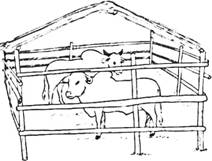
This is a type of house constructed using poles and thatched with grass.
Beddings are placed on the floor to absorb urine and dung.BARBED WIRE HOUSE
This type of house is made by using poles and barbed wire. The house usually is not thatched.
It is built on a high ground to allow rainwater to drain away.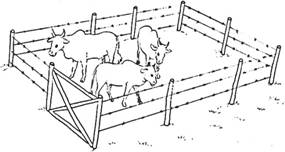
In order to protect cattle from rains, construct a shade at one end of the house.BRICK HOUSE
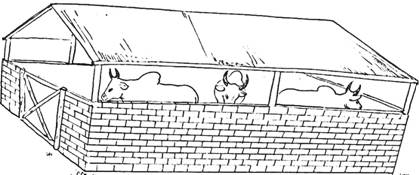
This is a type of house constructed using bricks and is roofed with iron sheets or grass.
The floor can be cemented.
-
The floor can be cemented.
Beddings are put on the floor to absorb urine and moisture from the dung.
THE CHARACTERISTICS OF A GOOD CATTLE HOUSE
- Strong enough to protect animals from predators
- Well thatched or roofed to protect cattle from rains
- Large enough for animals to have free movement and space for lying down
- Dry floor to make animals comfortable
- Well ventilated to ensure fresh air is always available
CLASSIFICATION OF CATTLE FEED
The feeds for cattle can be classified into two main groups: concentrates and roughagesCONCENTRATES
These are feeds with low fibre content and are high in nutrient content.Such feeds include maize bran (madeya), maize meal, (mgaiwa), meat meal, cotton seed cake, groundnut cake and meat-and-born meal.
ROUGHAGES
These are feeds with high fibre content.These include maize stalks, millet stalks, sorghum stalks, green grass, groundnuts haulm and rice straw.
UNIT 28 DISEASES AND PARASITES IN CATTLE
THE EFFECTS OF DISEASES AND PARASITES OF CATTLE
- Failure to eat
- Low milk production
- Low meat production
- Poor growth
- Poor fertility
- Irritation
- Poor quality meat
- Poor quality products such as meat, milk and hides
- Death of animals
Diseases of cattle, signs or symptoms and their control
Name of diseaseCause
Signs/symptoms
Control
Foot and mouth diseases
Virus
- High fever
- Sores on feet and in the mouth
- Excessive salivation
- Lameness
- Regular vaccination
- Restricting movement
- Quarantine
East coast fever
Protozoa
- High fever
- Rapid breathing
- Swollen lymph nodes
- Diarrhoea
- Regular dipping to control ticks
- Vaccination
Tuberculosis
Bacteria
- Coughing
- Loss of weight
- Changes in body temperature
- Vaccination
- Killing and bury infected animals
Sleeping sickness (trypanosomiasis)
Protozoa
- Sleeping sickness
- Loss of weight
- Controlling tsetse flies
- Vaccination
THE PARASITES OF CATTLE
Parasites can be found inside the body of the animal while others are found on the body of the animal.Parasites of cattle, damage caused and their control
Parasite
Damage caused
Control
Lice
- Sucking blood
- Causing skin irritation
- Dusting with chemicals
- Spraying with chemicals
- dipping
Liver fluke
- Damaging liver
- Using up food in the intestines
- Blocking bile duct
- Not grazing animals in dambos during rainy season
- Deworming
- Killing snails physically or using chemicals such as copper
sulphate
Tapeworm
- Using up digested food
- Blocking the digestive system
- Deworming with piperazine or
phenothiazine
Roundworm
- Blocking intestines
- Using up food
- Deworming
- Avoiding contamination of food with dung
Ticks
- Sucking blood
- Transmitting diseases
- Causing irritation
- Dipping or spraying
- Rotational grazing
- Hand picking
UNIT 29 AGROFORESTRY PLOT ESTABLISHMENT
An agroforestry plot needs proper establishment to obtain good results.
The activities involved when establishing an agroforestry plot include designing, digging planting holes and planting the selected tree seedlings or seeds.
FACTORS TO CONSIDER WHEN DESIGNING AN AGROFORESTRY PLOT
- Type of trees and crops to be grown together
- Spacing
- Size of the plot
- Size of the plot
CULTURAL PRACTICES FOLLOWED WHEN ESTABLISHING AGROFORESTRY PLOT
- Digging planting holes
- Planting
- Planting large seeds
- Planting stem cuttings
UNIT 30 AGROFORESTRY PLOT MANAGEMENT
Agroforestry plot needs to be well managed in order to get maximum yields from both the trees and arable crops.
Management of an agroforestry plot involves weeding, pest control and harvesting.WEEDING
Weeding is done at the same time that the arable crops are being weeded.It is also done during land preparation for arable crops when the trees are young.
PEST CONTROL
Pests include goats, cattle and termites.
Some pests, the damage they cause and ways of controlling them
PestDamage
Control
Goats
Eat bark and leaves of trees
- Fencing
- Scaring them away
Termites
Cut stems and roots of newly planted trees
- Inter-planting with garlic
- Planting termite resistant tree species
HARVESTING
Trees in agroforestry plot are harvested by pruning.REASONS FOR PRUNING
- To minimize shading the companion crop
- To provide green leaf manure and mulch to improve soil fertility
- To supply fuel wood
- To provide high quality fodder
Pruning in a newly established agroforestry plot starts at the beginning of the second season. Another pruning may be done soon after harvesting the companion crop such as maize.
For improving soil fertility, the fresh prunings are distributed along the ridges of the companion crop. Dry branches are used as fuel.
Leaves and tender branches are used as fodder for goats and other livestock.REFERENCE
MIE (2008) Standard 8 Agriculture Teacher’s Guide. Domasi; MIE.
UNIT 18 POND CONSTRUCTION
FACTORS TO CONSIDER WHEN CHOOSING A SITE FOR A FISH POND
MATERIALS FOR THE CONSTRUCTION OF A FISH POND
PLANNING A FISH POND
First the site must be surveyed to find out the presence of water supply and the type of soil available. Second the pond should be designed.
Third construct the pond
Principles for designing a pond
STEPS TO FOLLOW WHEN CONSTRUCTING A FISH POND
UNIT 19 STOCKING AND FEEDING FISH
STOCKING A FISH POND
Stocking means putting live fish into a pond.
Farmers usually stock ponds with fingerlings or fries.
Fingerlings are young fish ranging from 5 to 10 centimetres in size. These weigh about 10 to 20 grammes while fries are newly-hatched fish.
The best time to stock ponds is during the cool weather because few fingerlings die.
PROCEDURE FOLLOWED WHEN STOCKING A POND
FEEDING THE FISH IN A POND
Fish in a pond should be fed properly.
Naturally fish can survive on water plants such as algae and plankton.
The growth of algae and plankton can be improved by applying organic and inorganic fertilizers such as DAP and 23:21:0+4S.
Farmers can give supplementary feeds to fish in ponds such as maize bran, wheat bran, brewery wastes, chopped vegetables and molasses.
The feeds need to be given to fish twice or three times a day.
It is important to feed fish in a pond at the same time and place each day for the fish to get used to when and where to get the feed.
AMOUNT OF FEED FOR FISH IN A POND
Farmers should always give fish the correct amount of feed to avoid overfeeding. Fish must be fed at the rate of 5% of body weight daily.
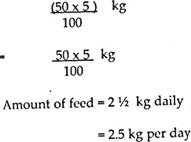
For instance, if all fish in a pond weigh 50kg, the daily amount of fed feed will be as follows:
SIGNS OF OVERFEEDING FISH IN A POND
UNIT 20 PARASITES AND PREDATORS OF FISH
Fish do not usually suffer from diseases even though there are a number of diseases of fish. However, parasites and predators attack them.
Examples of parasites of fish include:

Liver fluke Flukes are usually found in the gills, under the scales or on the fins of the fish.
Roundworms are found in the stomach while tapeworms are found in the intestines of fish.
EFFECTS OF FISH PARASITES
CONTROL MEASURES OF FISH PARASITES
PREDATORS OF FISH

THE MEANING OF PREDATOR
A predator is an animal that kills and eats another animal.
Predators cause losses in fish.
Birds are the most destructive predators of fish.
EFFECTS OF FISH PREDATORS
CONTROL MEASURES OF FISH PREDATORS
UNIT 21 POND MAINTENANCE
MAINTENANCE OF A FISH POND
Ponds should be maintained after harvesting fish and before re-stocking them.
WAYS OF MAINTAINING A FISH POND
UNIT 22 HARVESTING AND MARKETING FISH
UNIT 1 THE PROPHETS
UNIT 2 JESUS’ TRIUMPHANT ENTRY INTO JERUSALEM
UNIT 3 HUMAN RIGHTS
UNIT 4 THE ARREST AND TRIALS OF JESUS
UNIT 5 FORGIVENESS
UNIT 6 WORK AND LEISURE
UNIT 7 THE ROLES OF THE PROPHETS
UNIT 8 THE CRUCIFIXION AND RESURRECTION OF JESUS
UNIT 9 REASONS FOR FORGIVENESS
REFERENCES
UNIT 1 THE PROPHETS
A prophet is a messenger of God.
FOUR MAIN PROPHETS SENT TO THE ISRAELITES
- Isaiah
- Jeremiah
- Amos
- Micah
IMPORTANCE OF PROPHETS (THE DUTIES OF THE PROPHETS)
- They remind people to be faithful
- They condemn people against their sins
- They warn people about God’s punishment
- They foretell the future
- They preach the word of God
HOW THE MESSAGES OF PROPHETS WERE CARRIED OUT
- Through sermons
- Through their behaviours
- Through their written words
THE MESSAGE OF ISAIAH (Isaiah 3:16-26)
Isaiah warned the Israelites that if they continued to rebel, God would punish them.
Isaiah’s message was important because he was protecting them from God’s punishment.
THE MISSION OF JEREMIAH (Jeremiah 1:1-19; 2:9-13; 4:1-4)
Jeremiah’s mission was to warn the people of Jerusalem against idol worshipping. Jeremiah told them to repent and come back to God.
Jeremiah’s message was important because it teaches about reverence, love and protection of each other.
THE MESSAGE OF AMOS (Amos 2:6-8; 8:4-14; 9:1-4)
The mission of Amos was to preach the word of God to the people of the northern kingdom of Israel. His message was against injustice, corruption, insecurity and oppression of the poor.
Amos’ message is important because it teaches about love, empathy, patience, mercy and justice.
THE MESSAGE OF MICAH (Micah 2:1-13; 3:1-12; 7:1-7)
The mission of Micah was to warn the people of Judah against planning and doing evil.
His message was that God would punish them because of their injustice, corruption and oppression of the poor.
Micah’s message is important because it teaches about justice, love and humility.
HOW GOD RULED THROUGH ISAIAH (Isaiah 1:2-31; 3:16-26)
Isaiah, son of Amoz, was one of the prophets that God chose to guide the Israelites.
God showed and revealed the message to Isaiah through a vision concerning Judah and Jerusalem during the time when Uzziah, Jotham, Ahaz and Hezekiah were kings of Judah.
Isaiah warned the people of the two cities that God would punish them if they did not change from evil doing.
HOW GOD RULED THROUGH JEREMIAH (Jeremiah 1:1-19; 2:9-13; 4:1-4)
Jeremiah was the son of Hilkiah, one of the priests of the town of Anathoth.
The Lord spoke to Jeremiah when Josiah and his son Jehoiakim were kings of Judah.
He also spoke to him many times when Zedekiah son of Josiah was in his eleventh year of reign as king of Judah.
God guided Jeremiah by giving him words to speak to the people.
He was given authority over nations and kingdoms, to uproot and pull down, destroy and overthrow and to build and to plant.
God was with him throughout his mission.
HOW GOD RULED THROUGH AMOS (Amos 2:6-8; 8:4-14; 9:1-4)
God chose Amos, one of the shepherds from Tekoa to guide Israelites.
This was when Uzziah was king of Judah and Jeroboam, son Jehoash, was king of Israel. God appointed Amos to guide the people of Israel against the oppression of the poor. He told them about God’s judgement that He would destroy them because of their sins.
HOW GOD RULED THROUGH MICAH (Micah 2:1-13; 3:1-12; 7:1-7)
Micah of Moresheth had a vision about a downfall of Samaria and Jerusalem. God chose him when Jotham, Ahaz and Hezekiah were kings of Judah.
He was given responsibility to warn the people of Samaria and Jerusalem not to plan and do evil against others.
He guided them against the oppression of the poor and denounced the leaders of Israel for their corrupt practices.
UNIT 2 JESUS’ TRIUMPHANT ENTRY INTO JERUSALEM
Triumphant entry means visiting a place as an honourable person. OCCASIONS WHEN HONOURABLE PEOPLE VISIT A PLACE
- Political gatherings
- Wedding ceremonies
- Funeral ceremonies
- Chief’s installation ceremonies
- Tribal gatherings
- Inauguration ceremonies
HOW PEOPLE REACT WHEN THEY ARE VISITED BY AN HONOURABLE PERSON
- By singing
- By dancing
- By ululating
- By eating special food
- By giving them souvenir gifts
HOW JESUS ENTERED JERUSALEM (Matthew 21:1-17; Mark 11:1-9; Luke 19:28-48; John 12:12-19)
On the first day of the Passion Week, Jesus entered the holy city of Jerusalem in a humble manner while riding on a donkey.
People spread their clothes and branches of trees on the road. They did this while singing in praise of God.
His entry into Jerusalem testified that he was the Messiah.
THE CLEANSING OF THE TEMPLE DURING THE PASSION WEEK (Matthew 21:12-17; Mark 11:15-19; Luke 19:45-48)
When Jesus entered the temple, He found people trading and exchanging money. Angrily, He drove them out and overturned their tables as a way of cleansing the temple.
The chief priests and other religious leaders felt offended and were angered by His actions. As a result, they plotted to kill Him.
UNIT 3 HUMAN RIGHTS
THE VALUE OF LIFE (Genesis 2:7; 4:14-15; Exodus 2:1-5; 20:13)
The value of life is that it makes every person a living being as created by God and that has the right to be alive and live freely.
The Bible teaches that killing through abortion or any other means is a sin. It does not recommend capital punishment.
People violate the right to life through abortion and capital punishment. They may also violate the right to life through abuse of power.
Christians should observe the value of life and promote good behaviour such as peace, unity, tolerance, love, justice, fairness and equality in society.
THE ABUSE OF POWER (Exodus 1:15-21; John 7:24; Romans 12:19)
Abuse of power is when a person uses his or her position for personal gains.
Or Abuse of power is using one’s position for personal gains.
This happens when a person holding a position is exercising his or her powers negatively against the demands of the law.
Power is usually abused through corrupt practices and unfair judgement.
It is important to fight against corruption by reporting all cases of abuse of power to the responsible authorities.
The Bible teaches people to make the right judgement.
Therefore, Christians should fight against corruption by spreading the spirit of love, tolerance and observing human rights.
UNIT 4 THE ARREST AND TRIALS OF JESUS
Arrest means taking and keeping somebody prisoner with the authority of the law.
Or
Arrest is to take and keep somebody prisoner with the authority of the law.
A trial is a process of finding out whether a person accused of a crime is guilty or innocent.
Or
Trial is a formal examination of evidence in a court of law to prove a suspect guilty or innocent.
THE ARREST OF JESUS (Matthew 26:47-56; Luke 22:47-53)
At the Passover feast, Jesus told His disciples about His arrest leading to His death. He revealed that one of the disciples would betray Him.
After the Passover feast, Jesus went with His disciples to Gethsemane to pray. After that, He took three of His disciples and went further.
Jesus left the three on one place and went a step further to pray alone.
Soon after praying for the third time, Judas, one of the disciples came with chief priests, officers of the temple guards and elders to arrest Jesus.
Judas identified Jesus with a kiss and the armed men arrested Jesus.
THE TRIALS OF JESUS (Matthew 27:11-26; Luke 22:66-71; 23:1-25)
There were many accusations made against Jesus.
ACCUSATIONS MADE AGAINST JESUS
- He was accused of refusing to pay tax
- He was accused of calling Himself a king
- He was accused of stirring up the people all over Judea by His teachings
When Jesus was arrested, two kings tried Him in Jerusalem.
Pilate asked Jesus questions and found Him not guilty of any offence. Pilate then sent Jesus to Herod for another trial.
Herod asked Jesus many questions but Jesus did not answer them.
Herod also found nothing wrong in Jesus but ridiculed, mocked and sent Him back to Pilate.
Pilate then called the chief priests, rulers and the people and told them that Jesus did not commit any offence to deserve the death sentence.
The people insisted that Jesus should be crucified and Barabbas be released. Then Pilate handed over Jesus to the people and released Barabbas.
UNIT 5 FORGIVENESS
MEANING OF THE TERM 'FORGIVENESS'
Forgiveness is the act of not taking into account other people's wrongs.
WHY DO PEOPLE ASK GOD FOR FORGIVENESS (Genesis 50:2-21; Isaiah 38:1-5; Luke 15:11-31; Luke 23:39-
43; Acts 7:60; 2 Timothy 4:16)
- To create good relationships
- To restore good relationships
SITUATIONS THAT REQUIRE FORGIVENESS
- Fighting
- Stealing
- Killing
- Insulting others
UNIT 6 WORK AND LEISURE WORK
Work is an activity in which the effort of the body and mind produces something or gains a result. Every person is expected to do some work to live a productive life.
The amount of work people do varies with age, health, attitudes and responsibility.
LEISURE
Leisure is the time when one is free from work or duties of any kind.
During leisure time people do many activities such as chatting with family members and friends, reading story books and newspapers, fishing, sewing, playing games and other sporting activities, swimming, visiting relatives, visiting friends and visiting the sick.
IMPORTANCE OF WORK
- It provides them with basic needs
- It provides them with body exercises
- It protects one from effects of laziness
- It earns them respect and favour from others
IMPORTANCE OF LEISURE TIME
- It allows people to relax
- It allows people to rest
- It allows to do their hobbies
BIBLE TEACHINGS ON WORK AND LEISURE (Genesis 2:1-3; 2 Kings 5:20-27; Proverbs 12:24; Proverbs 24:30-34; Proverbs 10:4; Matthew 25:26; Thessalonians 3:6-15; 1 Timothy 5:13)
The Bible teaches about the importance of work and condemns laziness because laziness brings poverty.
God is not pleased with laziness because God was the first one to work by creating the universe and everything in it.
God valued leisure time by resting on the seventh day after the creation of the universe. God made Adam and Eve as God's co-workers.
Jesus worked as a carpenter. Paul worked as a tent maker
Simon Peter worked as a fisherman
Paul also taught that lazy people must not eat because work was ordained by God.
Parents, guardians and teachers should teach their children and learners to be hard workers at school and home.
However, they should be guarded against over-working, child abuse and child labour.
PROBLEMS THAT CAN BE FACED BY IDLE OR LAZY PEOPLE
- Poverty
- Drug and substance abuse
- Prostitution
- Theft
- Violence
- Discrimination
WHAT MAKES GOD THE FIRST WORKER
- God was the first one to work by creating the universe and everything in it
UNIT 7 THE ROLES OF THE PROPHETS
Meaning of the term ‘role’
A role is a part taken by someone in life or in any activity.
Meaning of the term ‘prophets’
Prophets were messengers of God.
ROLES OF THE PROPHETS (Isaiah 1:2-31; 3:16-26; Jeremiah 1:4-19; Jeremiah 4:1-4; Amos 2:6-8; Amos
8:4-14; Amos 9:1-4; Micah 2:1-13; Micah 3:1-12; Micah 7:1-7)
- Carrying messages from God to people
- Preaching God's message to the people
- Guiding kings and God's people in difficult circumstances
- Anointing leaders
- Condemning the evil
- Prophesying or foretelling the future events
- Acting as a bridge between God and people
- Acting as a bridge between God and leaders
PROPHETIC ROLES OF CHRISTIANS (Romans 12:1-21; 1 Corinthians 12:4-6, 28-31)
- Preaching
- Prophesying
- Baptising
- Guiding
- Counselling
- Praying for the sick
- Teaching the word of God
- Administering the church
HOW GOD RULES THROUGH CHRISTIANS (Matthew 28:19-20)
God rules the world through different Christian missions.
These missions are fulfilled through:
- Praying for those in bondage
- Relief provision
- Mediating
- Counselling
- Preaching the word of God
- Praying for peace
UNIT 8 THE CRUCIFIXION AND RESURRECTION OF JESUS
The meanings of the terms 'crucifixion' and 'resurrection'.
Crucifixion
Crucifixion is the death of Jesus on the cross.
Resurrection
Resurrection is the state of coming back to life.
THE CRUCIFIXION OF JESUS (Matthew 27:32-66; Mark 15:12-32; Luke 23:26-55; John 19:16-79)
Jesus died a painful and cruel death.
The Jews crucified Jesus because they thought Jesus was blasphemous. Jesus was mocked, whipped and spat at.
He was wounded, tired and failed to carry the cross.
Instead, Simon of Cyrene carried the cross for Jesus to Golgotha. After crucifying Jesus, they shared Jesus' garments by casting lots.
They then put an inscription on Jesus' cross which read, "This is Jesus the King of Kings".
Jesus was mocked by soldiers, passers-by and one of the two robbers who were also crucified together with Jesus.
Thereafter, there was darkness all over the land for three hours, and later on, Jesus cried and died.
Soon after his death, a curtain of the temple was torn in two parts, the earth shook, rocks were split, tombs were opened and bodies of the saints were raised and seen walking in the city of Jerusalem.
Those who were watching over Jesus at the cross were filled with awe and believed that Jesus was the son of God.
Joseph of Arimathea went to Pontius Pilate and asked for the body of Jesus and laid it in his own new tomb.
When Joseph was doing all these, Mary Magdalene and Mary the mother of Joseph were there.
EVENTS THAT HAPPENED WHEN JESUS WAS ON THE CROSS
- curtain of the temple was torn in two parts
- the earth shook
- rocks were split
- tombs were opened
- bodies of the saints were raised
THE RESURRECTION OF JESUS (Matthew 28:1-20; Luke 24:1-12, 43; John 20:1-20)
Jesus resurrected after three days.
The women were the first to visit the tomb.
They found that the stone was rolled away and did not find the body of Jesus. Two angels told them that Jesus had risen.
After his resurrection Jesus appeared to Mary Magdalene. Later, Jesus appeared to two men who were going to Emmaus.
He appeared again to his disciples who were gathered in the upper room and they were frightened thinking that they had seen a spirit.
Jesus told them to look at his hands and feet to believe that he had risen.
OCCASIONS JESUS APPEARED TO DIFFERENT PEOPLE AFTER HIS RESURRECTION
- Jesus appeared to Mary Magdalene
- Jesus appeared to two men who were going to Emmaus
- Jesus appeared to his disciples
UNIT 9 REASONS FOR FORGIVENESS
People offend each other and it is their responsibility to behave morally in order to live in harmony with others in communities.
Therefore it is important to forgive each other because it assists in restoring or creating a good relationship.
SITUATIONS WHERE PEOPLE ARE FORGIVEN (Genesis 50:15-21; Isaiah 38:1-5; Matthew 6:12; Luke
15:11-31; Corinthians 3:13)
The Bible has stories where people were forgiven. For example,
- The prodigal son was forgiven by his father after spending his money carelessly. He decided to go back to his father who forgave and accepted him.
- Hezekiah was forgiven by God by adding more years to his life when he was about to die.
- Joseph forgave his brothers while he was a governor in Egypt by assisting them with a place to live and food when there was famine in Canaan.
Today, people forgive each other whenever one pleads for forgiveness. Therefore, forgiveness is important in any society.
REFERENCE
MIE (2008) Bible Knowledge Learner’s Book for Standard 8, Domasi; MIE. MIE (2008) Bible Knowledge Teacher’s Guide for Standard 8, Domasi; MIE.
![]()
PARTS OF SPEECH
Parts of speech are categories of words . EIGHT PARTS OF SPEECH
- NOUNS
- PRONOUNS
- VERBS
- ADJECTIVES
- ADVERBS
- PREPOSITIONS
- CONJUCTIONS
- INTERJECTIONS
![]()
A noun is a word that names a person , a place , a thing or an idea .
Examples
- Name of a person: Mary ,Tikondane , Julius , Joseph, Joshua
- Name of a place: Mpalapata , Lilongwe , Mzuzu , Blantyre
- Name of a thing: stone , book , tree
- Name of an idea : love ,respect ,pride
FIVE CLASSES OF NOUNS

- COUNTABLE NOUNS
- are names of tangibles things that you can see or touch and things you can count.
Types of countable nouns
- Collective nouns
- Common nouns
- Proper nouns .
- COLLECTIVE NOUNS
Collective noun name a group of people ,or things . Examples :
- Juliet is carrying a heavy bundleof grass.
- His classwill knock off late .
- Mr. Phiri has a big flockof animals
- The armyhas come .
- A swarmof locust destroyed the crops .
- This is my herdof cattle .
- The audiencelistened to the singer
- James is carrying a bunchof keys.
- COMMON NOUNS
- A common noun is used to name any common object . Examples :
- Busheskeep a lot of snakes
- Mineralsare not commonly found here .
- Churcheshave multiplied greatly in Malawi.
- PROPER NOUNS
A proper noun is the special name given to a particular person or thing .
- Proper nouns always begin with capital letters Examples
- Malawiis a peaceful country.
- Marthais pounding maize .
- I am going to Malawi Institute of Education
- Jane was born on Wednesday
- It is always cold in June
- UNCOUNTABLE NOUNS
- are names of things you cannot count Examples of uncountable nouns
- This tube is made of glass
- Paper is white
- CONCRETE NOUNS
- are names of objects that are tangible Examples :
- A bird is in the tree
- Give me a stone
- ABSTRACT NOUNS
- are names of qualities ,ideas ,characteristics ,states or actions of things . Examples :
- Health is better than wealth
- We must conquer poverty and ignorance
- He was treated with kindness
- The soldiers fought with courage
- A lot of people are afraid of death
- I do not need your help
- He lost his dignity after he was caught stealing
- There was some truth in the matter
- Unity is strength
![]()
- A pronoun is a word that is used instead of a noun .
- A pronoun is a word that replace a noun in a sentence. List of pronouns :
- I
- He
- She
- Him
- It
- Us
Types of pronouns
- Personal pronouns
- We
- They
- Them
- You
- mine
- yours
- his
- ours
- me
- its
- These pronouns stand for the persons or things referred to in a conversation Examples :
- you
- he
- we
- Possessive pronouns
- him
- her
- theirs
- are pronouns that show ownership and possession Examples :
- This house is mine .
- The dog is hers .
- This book is yours .
- The car is ours .
- These hoes are theirs .
- Demonstrative pronouns
- is a pronoun that points out and identifies
The words this ,that ,these and those point out things. Examples :
- This is a good book .
- These are good books
- That is the house in which we live .
- As these already been sold ,may I have those ,please ?
- Reflexive pronouns
- shows that the action expressed by the verb passes back to the subject . Examples :
- She hurt herself
- He cut himself with his knife
- We taught ourselves to read
- They nearly killed themselves
- Relative pronouns
- A relative pronoun points to a word or phrase which comes immediately before the pronoun .
Examples :
- The bus which brought us here has broken down
- The football jersey that I wore last year is now too small for me .
- Dziko is pupil upon whom one can depend
- Emphatic pronouns
- Emphatic pronouns have the same form as reflexive pronouns but used in a different way .
- Emphatic pronouns call attention to or emphasize the words with which they are used
Examples
- I myself saw him do it .
- You yourself will have to pay for the damage done
- Father himself built the house .
- Timve himself decided to do the job
- Mrs. Phiri herself saved the child
- Interrogative pronouns
- are used when questions are asked . Examples:
- What is your name ?
- What is the time ?
- What did you say?
- Who went to Blantyre ?
- Who told you ?
- Whom are you going to meet ?
- Whose is this coat?
- Which of those books do you want ?
- Distributive Pronouns
- are used to refer to individual or separate members of a group or class. Example :
- Either of the cars is good enough for our purpose .
- Each of the boys was given a present .
- Each of these is acceptable .
- Neither of these is right . 3.VERBS
- is a doing word in a sentence
- is a word that shows action Examples:
- The boy went home .
- The boy is going home
- Timve was fishing
- The girls are going home
- The men rushed straight to their offices .
- Mr. Maseko is walking up the hill.
- I am going home now.
- Mr. Sekani angrily knocked the bucket over Auxiliary verbs
- are those which help other verbs to form their tense ,voice and mood Examples :
- I am going home
- The boys were playing football
- The rat was killed by the cat
- May God bless you.
- Will you come with me
- Timve cant swim
- Dziko did see the snake .
- Mabvuto is carrying a basket
- Mr. Phiri has just killed a snake
- She was present
- They were present
- ADJECTIVES
- Are words that make the meaning of other words more exact by describing or limiting them.
- An adjective qualifies a noun EXAMPLES :
- The young boy could see his reflection in the clear water
- The greedy dog ate all the meat.
- Beautiful flowers grew in the garden .
- Thick clouds could be seen in the sky
- Mabvuto is a fat little girl
- The proud bird sat on the top branch of the tree
- My father met a strange person yesterday .
Types of adjective
- Descriptive adjectives
- indicate the quality or state of a thing Examples :
- The river is not deep.
- Zalimba is a brave boy
- That is a short girl
- Blantyre is a large city
- Tamanda is an intelligent pupil
- Mrs. Zimba is a beautiful woman
- My father is a poor man.
- Possessive adjectives
- are used to indicate to whom an object belongs Examples
- Its legs are dirty
- Their shirts are clean
- Is that your home ?
- His uncle is a businessman.
- They have lost their books
- Her books are on the floor
- Interrogative adjectives
- are adjectives which ask questions
- These adjectives ask which or what object meant . Examples :
- Which pencil do you want ?
- What time is it ?
- Which bicycle did you see?
- What name shall we give the baby?
- Which bus goes to Ndirande ?
- Which boy will win the prize?
- Demonstrative adjectives
- are used to indicate which objects is pointed at . Examples :
- This book is old
- That book is new
- These hoes are ours.
- This reason is not acceptable here.
- Those bananas are green .
- What is that girls name?
- Numeral adjectives
- are adjectives which indicate exactly how many things there are or what order they are .
Examples:
- There are six girls in this classroom .
- Twenty players were selected for the game .
- Tsala drank three cups of water
- September is the ninth month of the year.
- Indefinite adjectives
- indicate a number of things without stating exactly what the number is . Examples :
- All dogs are to be vaccinated this week
- Several people were invited this week .
- Some girls took part in the competition
- Distributive adjectives
- show that things are taken separately . Examples :
- Each pupil received a copy of the book.
- Timve was told to take the medicine every two hours .
- The chairman did not support either side
- Quantitative adjectives
- show how much of an object is meant . Examples ;
- My father hasnt got much money .
- Has she got any meant ?
- Saturday is a half day holiday in Malawi.
- I have got some bread in the house
- The hungry man ate a whole loaf of bread .
- Proper adjectives
- A proper adjective is either an adjective formed from a proper noun .
- Proper adjective begins with a capital letter. Examples :
- Mr. Kamwendo bought a French car.
- Japaneseradios are becoming popular.
- Malawian women like to wear their traditional dress .
- The race was won by Scottish runner.
![]()
- An adverb is a word which modifies verb ,an adjectives ,or another adverb.
- Adverbs adds to the meaning of a verb ,an adjective ,or another adverb . Examples:
- Mabvuto washed the plates yesterday .
- Takondwa walked slowly .
- The shirt is very clean .
- Kondwani is very intelligent .
- Timve did this job very quickly .
- The child ate his food greedily.
- Mr. Zimba is arriving tomorrow .
- She is going home today TYPES OF ADVERBS
- Adverbs of manner
- these adverbs describe how the action of the verb takes place
- Most of these adverbs end in ly Examples:
- Christina writes neatly.
- The old woman walked slowly .
- The man drove recklessly.
- Please drive slowly.
- The boxer fought bravely .
- Adverbs of degree
- indicate the extent or degree of any quality when they modify adjectives or adverbs , or adverbs ,or the degree of action of a verb.
Examples :
- The tea is too hot to drink .
- Tinyade is a very clever girl
- She walked so slowly that she was left behind
- This sum is rather difficult .
- These shoes are too big for me .
- He reads quite fluently
- Interrogative adverbs
- are used to introduce questions . Examples :
- How did you come here ?
- Why did you leave me ?
- When are you going to Lingadzi ?
- Where are you sending him?
- Relative adverbs
- are used to introduce adverbial clauses Examples :
- They ask me why was late .
- We shall eat where the food is good .
- When you saw me I was ill.
- I saw them when I was in Mangochi.
- Adverbs of time Examples :
- indicate when the action of a verb takes place. Examples :
- Please ,write me a letter soon .
- Mr. Phiri went home yesterday.
- Our examinations start tomorrow .
- Can I see you now ?
- Call me early , I want to see the sunrise .
- Adverbs of frequency
- indicate the frequency with which the auction of the verb takes place .
- They answer the question how often? Examples :
- She goes home frequently .
- I often meet him .
- I have never met.
- Adverb of place
- indicate where the action of the verb takes place .
- They answer the question where Examples:
- She slept here.
- They slept there .
- They have decided to settle here.
- Has he come to live here?
- The pupils have gone back .
- Mr. Phiri went abroad.
- PREPOSITIONS
- it shows the relationship between the noun or the pronoun Examples :
- The dog ran into the house .
- I walked through the gate .
- They are in the house .
- Maliro is sitting under the tree.
- This chapter is about prepositions .
- She got a letter from them
- They ran up the hill
- She walked down the road
- Mwayi was born in Blantyre Commonly used prepositions
- above
- across
- behind
- far
- down
- after
- among
- at
Proper use of prepositions
- wait for ……
- divide among (many)
- agree with
- ashamed of
- walk into
- different from
- full of
- filled with
- angry with
- below
- beside
- between
- through
- off
- up
- near
- with
- on
- from
- in
- into
- of
- under
- over
- by
- correspond with (someone)
- correspond to (something)
- look after ( something ,someone)
- look at ( something
- to reply to
- differ from
- to differ from ,with
- complain of ,about
- familiar with
- suffer from
- lend to
- to borrow from 7.CONJUCTIONS
- to depend on
- divide between (two persons)
- are words that joins words , phrases or clauses .
- is a word used to joins words or group of words Examples :
- Mary bought some tomatoes ,onions and some fruits.
- Dalo worked hard at school but she failed the test.
- The defeat left me feeling both sad and angry.
- While we were there ,we bought these flowers
- Neither Mary nor John knows the way.
COMMONLY USED CONJUCTIONS
- After
- although
- so that
- as if
- unless
- in case
- while
- in that
- whether
- Both.....and.....
- Either........ or........
- Neither ........nor........
- INTERJECTIONS
- An interjection is a word that is used to express a sudden strong feeling .
- Interjection shows surprise ,pleasure , pain ,confusion or some other emotion.
Examples :
- Hey ! You cant go in there .
- Oh! I left my notebook at home .
- Hurrah ! Our team won
- Alas! This is the end .
- Ouch !Its painful.
- Ha! You have given your money for nothing.
THE VERB II
![]()
- Active voice is when the subject is taking the action .
- Passive voice is when the subject is receiving the action .
Examples of active and passive voices
- Active voice :The snake watched the boy
Passive voice :The boy was watched by the snake
- Active voice :The cat killed a rat
Passive voice:The rat was killed by the cat
- Active voice : The boy opened the door
Passive voice : The door was opened by the boy
- Active voice : The snake watched the boy
Passive voice : The boy was watched by the snake
- Active voice : The dog killed the rat .
Passive voice :The dog was shot by the man
- Active voice :The child drank the milk .
Passive voice :The milk was drunk by the child
- Active voice : My sister wrote the letter .
Passive voice : The letter was written by my sister
- Active voice :The man shot the dog
Passive voice : The dog was shot by the man.
- Active voice : My uncle repaired the car
Passive voice : The car was repaired by my uncle
- Active voice : Takondwa ate the bread
Passive voice: The bread was eaten by Takondwa .
- Active voice : The watchman keeps the keys .
Passive voice: The keys was kept by the watchman
- Active voice : The chief will welcome the Minister
Passive voice : The Minister will be welcomed by the chief
- Active voice : The Minister will open the conference .
Passive voice : The conference will be opened by the Minister
|
|
|
|
|
|
|
|
|
|
|
|
|
|
|
Unit 11 Discrimination and prejudice in artistic performances
Unit 12 Movement and manipulative skills
Glossary
References
MOVEMENTS IN ARTWORK
Artistic creativity refers to having the power to use one's intelligence and imagination in artwork instead of merely copying from what is already there.
Or
Artistic creativity is using one's intelligence and imagination in artwork instead of simply copying what is already done.

IMPORTANCE OF ARTISTIC CREATIVITY
It helps one to produce or perform something that portrays beauty
ACTIVITIES THAT INVOLVE MOVEMENT
- Singing melodies
- Making a hoe handle
- Plaiting hair
- Making baskets
- Making mats
SOME BODY MOVEMENTS
- Stretching arms forward
- Stretching upward
- Stretching downwards
- Running on the spot
- Jumping
- Crawling
TEMPO
When movements are guided by music, the movements are guided by the tempo of the music.
IMPORTANCE OF TEMPO
- Source of unity
- Source of variety
- Provides music expression
- Helps to develop coordination
- Helps to develop a sense of concentration
WAYS OF ESTABLISHING A TEMPO
- By stamping feet
- By clapping hands
- By tapping an object
SOME ARTISTIC ACTIVITIES THAT CAN BE CONTROLLED BY TEMPO
- Drawing
- Painting
- Carving
- Weaving
ANIMALS AND MOVEMENTS
IMITATING THE MOVEMENTS OF CREATURES
- Imitating animals means moving in the same way that these animals move.
- Animals move different parts of their bodies.
- They crawl, hop, walk, run, glide or jump.
- When running from danger, movements may be fast than when looking for food or at peace.
- We need to be familiar with the animals in order to imitate effectively.
SOME FEATURES OF ANIMALS THAT MAKE MOVEMENTS
- Legs
- Trunks
- Wings
- Bellies
REASONS WHY PEOPLE AND ANIMALS MOVE AT DIFFERENT SPEEDS AND HEIGHTS
- Running away from danger
- Looking for food
- Looking for shelter
- Looking for mates
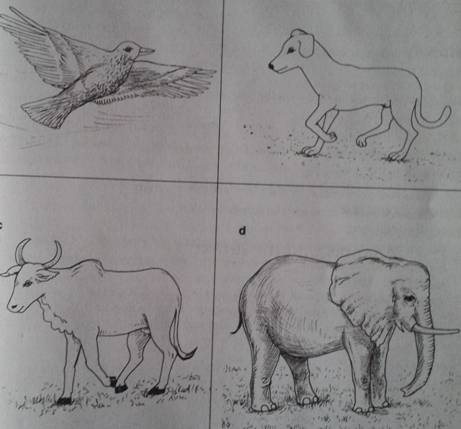
DRAWING CREATURES
Drawing the creatures involves presenting them in a diagrammatic form. In order to simplify the work, drawing should be done step-by-step.
Draw the general outline first and add details later to complete the drawing.
UNIT 2 LEADERSHIP ROLES TYPES OF LEADERS AND THEIR ROLES
A leader is a person who leads others to achieve the goals of an organisation or group.
TYPES OF LEADERS/LEADERSHIP STYLES
- Democratic
- Democratic leaders involve members of the community when making important decisions.
- A democratic leadership style is one where the majority rule.
- The leader takes no side
- Everyone's voice counts
- Autocratic
- Autocratic leaders give directives
- This is where only the leader's voice counts.
- This is also referred to as dictatorship, absolutism or despotism
- laissez faire
- Laissez faire leaders leave situations to chance.
- There is chaos
- Everyone does what they please
LEADERSHIP ROLES
- Settling disputes
- Settling marriage conflicts
- Mobilizing the members in carrying out development projects
- Providing guidance
- Supervising
- Monitoring
THE QUALITIES OF A GOOD LEADER
- Able to delegate tasks
- Accept criticisms
- Should lead by example
- Depends on people he/she works with
- Trusts the people he/she works with
- Knowing their strengths and weaknesses
- Flexible
- Aware of the interests of the followers
Importance of delegation is that it promotes the sense of collective responsibility
SOME OF SUCCESSES IN LEADERSHIP
- Mobilising the society to take part in development projects
- Resolving conflicts amicably
SOME OF CHALLENGES IN LEADERSHIP
- Resistance to change
- Conflict of interest among the subjects
The challenges can be avoided by exercising good leadership skills
SOME LEADERSHIP SKILLS
- Effective communication
- Providing motivation
- Problem solving
- Delegation
- Decision making
- Critical thinking
- Patience
- Open mindedness
Ways of expressing and communicating feelings, ideas and important messages are:
- use of language
- dances
- songs
- gestures
- stories
- drawings
- role plays
DANCES THAT EXPRESS AND COMMUNICATE MESSAGES
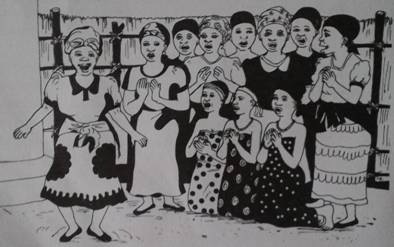
People dance at different occasions Some of the occasions are:
- Weddings
- Initiation ceremonies
- Funeral gatherings
- Chief’s installation ceremonies
- Political gatherings
Songs and dances help in communicating messages on cross-cutting issues.
SOME EXAMPLES OF CROSS=CUTTING ISSUES
- HIV and AIDS
- Gender
- Deforestation
- Human rights
- Democracy
Sometimes dances are just used for entertainment and healing.
For example, Vimbuza and Malombo are for healing while Mganda and Ingoma are for entertainment.
WALL CHARTS
Apart from dance, messages can be communicated through wall charts. Wall charts communicate messages verbally or non-verbally.
Wall charts can be made using decorative stitches or applique
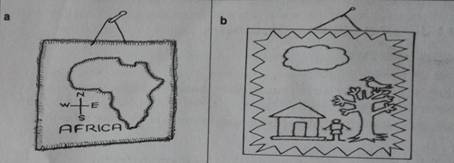
STORY TELLING PICTURES AND ROLE PLAYS
- Messages can also be conveyed through picture stories and role plays.
- A lot of cartoons use picture stories which may have words and other may have no words.
- Role playing is the dramatisation of a situation.
- Role playing is important in communicating messages because the issues are made realistic and more meaningful.
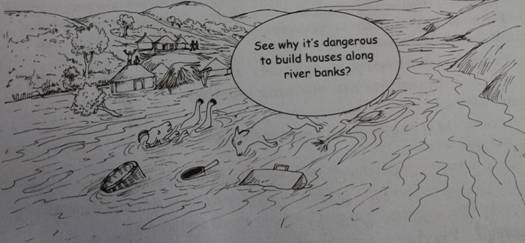
COLLABORATIVE SPORTS AND GAMES
There are various types of sports.
Some are individual sports while others are team sports.
The most common team or collaborative sports are: football, basketball and netball.
FOOTBALL
- Played by eleven players each side
- The game lasts for 90 minutes
- Forty five minutes each half
- Three officials
- One referee and two assistant referees
- The team that scores more goals wins the match
- The goal keeper is the only player who is allowed to use both hands and legs in the goal area
BASKETBALL
- Played by seven players each side
- Played in four quarters
- Each quarter lasts for fifteen minutes
- The team that accumulates more points wins the game
- Two umpires officiate the game
NETBALL
- Played by seven players each side
- Played in four quarters
- The team that scores more goals wins the match
- Two umpires officiate the game
- Each player not allowed to hold the ball for more than 3 seconds
- Players have specific playing areas
- Specific players shoot at goal
USES OF THE CARDS IN FOOTBALL
- Red card is to suspend a player for foul play
- Yellow card is to warn a player for foul play
THE USES OF SPORTS AND GAMES IN THE PAST
- For fun
- For enjoyment
- For unity
Artistic performances require body movements.
Some of these performances require personal and general space. Personal space is the space that your body uses.
Personal space is also called kinesphere
General space is the space where your body and other individuals occupy or use.

COMPONENTS OF GENERAL SPACE
- Levels
- Levels refers to how close to the floor or how far away from the floor one is as he/she moves
- Extensions
- Extensions describes the amount of space a movement pattern uses
- Floor pathways
- Floor pathways refers to how people move on the floor
- Air patterns
- Air patterns refers to aerial directions
FACTORS THAT DETERMINE PERSONAL AND GENERAL SPACE
- The space available for the activity to be done
- The number of people participating in the activity
- The nature of the activity to be done
- The body size(s) of the participant(s)
In addition, some performances may cover distances and other may not cover distances. Activities done may be physical of non-physical.
Examples of physical activities that may require distance are:
- running
- throwing
- Long jump
Non-physical activities that do not require distance include:
- stretching
- running on the same spot
- Sewing
- Aerobics
- carving
- drawing

IMPORTANCE OF HAVING PERSONAL SPACE
- To avoid colliding with others
- To perform freely
ARTISTIC ITEMS
TAKING BODY MEASUREMENTS
Garments and curios are some of the artistic items that meet the needs of the school and the community. To make a fitting garment, one needs to take appropriate body measurements.
Body measurements are taken using a tape measure.
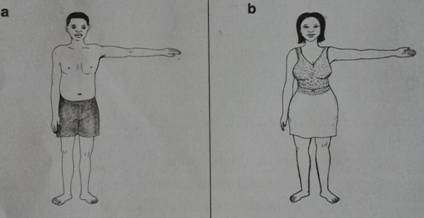
Before sewing garments, take the following body measurements:
- bust: measure around the fullest part of the body above the waist
- hip: measure around the fullest part of the body below the waist
- waistline:
- measure the waistline by tying a tape around yourself tightly and wiggling about a bit
- nape of the neck to waistline down the center back (for blouses and shirts)
- waistline to hem down center back with a friend's help (don't bend to look)
- waistline to ankle (this is useful for trousers and long dresses)
- shoulder length: measure from one shoulder to another
- sleeve length
CURIOS

THE MATERIALS AND TOOLS FOR MAKING CURIOS
- Wood
- Soapstone
- Adzes
- Knives
- Scrapes
- Gauges
- Chisels
- Mallets
- Rasps
- Saws
- Vices
THE PROCEDURE FOR CARVING CURIOS
- clean off the piece of wood to remove unwanted parts
- assess the size, length and shape of the wood to determine the item that can be carved
- design the items to carve
- carve the curios
REASONS FOR DECORATING CURIOS
- to make them attractive
- to sell fast
MARKETING CURIOS
- Advertising
- Making a display of finished products
- Organizing a showcase
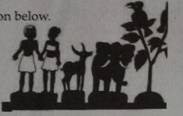
CULTURAL ACTIVITIES
There are many events which take place in the society that have cultural significance. Some of these events include:
- Initiation ceremonies
- Wedding ceremonies
- Installation of chiefs
- Political gatherings
- Funeral ceremonies
- Bridal send-offs
- Bridal showers
WAYS OF PRESERVING CULTURE
- Singing songs
- Dancing
- Story telling
COMPOSING SONGS ABOUT EVENTS OF CULTURAL SIGNIFICANCE
Singing songs and dancing are common ways of preserving one's culture Songs can be composed in different ways.
- In written music, rhythms are written first, followed by the melody and other necessities such as dynamics and tempo.
- In other forms of composition, one can compose a new tune and words
- Another way is using an already existing tune and improvise the words.
- Finally, one can also improvise a tune to already existing words.
NB: Composing requires a lot of creativity.
Improvisation refers to the use of a resource as an alternative to something that is not readily available.
Or Improvisation is using one thing to replace what is not available.
IMPORTANCE OF IMPROVISATION
- It helps to overcome the problem of scarcity of resources
- One can design and use resources that suit the needs of the learners
- One can work with the learners in designing and making the resources
- It promotes creativity
- It promotes involvement of the learners
- It is cheap to produce
- It helps teachers and learners to be resourceful
RESOURCES THAT CAN BE IMPROVISED
- A razor blade for a pair of scissors when cutting fabric
- Sack cloth for a skin during Ingoma dance
LEARNING RESOURCES
Production of teaching and learning resources is an alternative to the use of realia.
Realia are objects that are used directly for teaching and learning in the original form such as people, stones and seeds.
Realia are appropriate because they give an exact impression of what is being seen or discussed. However, it is not always possible to use realia.
Some realia may be difficult to handle such as a living snake and living bees. A model, a picture or a drawing becomes a good alternative.
USE OF LOCALLY-AVAILABLE RESOURCES
Locally available resources are things that are found around us or in our environment. Teaching and learning using locally-available resources (TALULAR) goes beyond improvisation. This is so because not all resources can be improvised.
TALULAR includes people and non-material resources such as time, personal knowledge, skills, talents, experiences, culture, art, proverbs, songs, dances and language.
KEY AIMS OF TALULAR
- To assist in making teaching and learning more effective
- Introducing cost-effective classroom technologies
- Making the educational system more sustainable
Creativity and resourcefulness are useful attributes in the use of teaching and learning resources from the local environment.
Creativity means thinking of innovations or new ways of doing things to keep attracting or motivating the learners.
Resourcefulness means when ready-made resources are inadequate or scarce, you should use alternatives that work.
Furthermore, diversity in the use of resources allows you to organise a variety of activities for the learners.
IMPORTANCE OF RESOURCES IN TEACHING AND LEARNING
- Production of teaching and learning resources helps to overcome the limitations in the use of realia
- Resources create a lasting image in the learners
- Resources enhance interest in learners to pay attention when learning
- Learners see the size of the objects they are learning
- Learners see the shape of the objects they are learning
- Learners see the colour of the objects they are learning
- Learners see the weight of the objects they are learning
- Resources satisfy the senses of touch, smell, taste and sight as they handle the objects
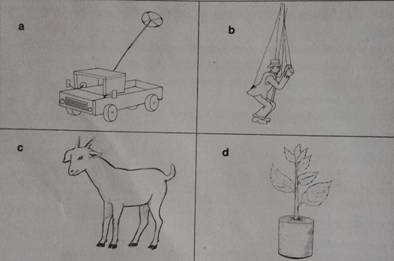
FACTORS TO CONSIDER WHEN PRODUCING RESOURCES
- Resources that are big enough for all to see
- Resources that are attractive
- Resources that are simple
- Resources that are accurate
- Resources that are clean
DISPLAYING RESOURCES
Display may be done on:
- Walls
- Tables
- Boards
- Floor
- suspending using strings when space is limited
NB: Resources should not be on display for too long in order to sustain the learners' interest.
STORAGE OF RESOURCES
Resources can be stored in:
- Cupboards
- Lockers
- Galleries
- Boxes
- Plastic bags
NB: Resources are stored in a safe place to sustain their use.
Teamwork is working together.
IMPORTANCE OF TEAMWORK
- Exchanging knowledge
- Exchanging skills
- Promotes unity
- Promotes cooperation
- Making work easier
There are different forms of artwork.
The artwork include drawn, woven and carved items.
CARVING
Carving is the removal of unwanted material from an object so as to come up with a desired shape. Carving can be done on wood or stone
MATERIAL FOR CARVING
- Bamboo
- Palm leaves
- Cane
- Adzes
- Knives
- Scrapes
- Gauges
- Chisels
- Mallets
- Rasps
- Saws
- Vices
- Cramps
When carving using a piece of wood, study it carefully so that you understand its grain and special qualities. In the process, one chooses the wood by considering its hardness, softness and thickness.
It is also important to check the type of wood to avoid using poisonous wood for making kitchen utensils. It is important to design one's work before cutting the wood.
This is to ensure perfection in the proportions and main shapes of the object you are intending to carve. Designing includes determining the right size, length and thickness of the carving.
VARIOUS TOOLS REQUIRED FOR CARVING
- Adzes
- mallets
- chisels
- knives
- rasps
- saws
- vices
USES OF DIFFERENT TOOLS
- The rasp is used for smoothening the surface of the carving.
- The vice is used for holding the wood
- Wood mallet is used for hitting the handle of the chisel or gauge to drive the blade into the wood.
- Glass paper is used for smoothening the carving.
- Sandpaper is used for smoothening the carving
- Saws are used for cutting the wood.
- Adzes are used for removing the unwanted parts of the wood.
- Cramps are used for holding the wood.
PRODUCTS FROM CARVING
- wooden spoons
- clubs
- cricket/baseball bats
- cooking sticks
- walking sticks/crutches
- salt shakers
- candle holders


WAYS OF DECORATING CARVINGS
- scorching
- engraving
- painting
WEAVING
Weaving is the interlocking of warps (vertical strips) and wefts (horizontal strips) to produce fabrics, mats, baskets and hats.
MATERIALS FOR WEAVING
- Bamboo
- Palm leaves
- Cane
- Reed
PRODUCTS FROM WEAVING
- Mats
- Baskets
- Hats
- Fabric
DRAWING
Drawing is a diagrammatic representation of an object.
MATERIALS FOR DRAWING
- Sheets of paper
- Fabric
- Sacks
- Pencils
- Ink pens
- Crayons
- Paints
FACTORS TO CONSIDER WHEN COSTING PRODUCTS/ITEMS
- Amount of materials used
- Time spent in making the item/product
- Attractiveness of the finished product
- Age group meant for the item
- Availability of the product
- Durability of the product
- Quality of the material
- Demand
- Cost of the materials, if bought
WAYS OF MARKETING VARIOUS ITEMS/PRODUCTS
The following are some of the ways of marketing products that have been drawn, woven, carved, modelled and so forth:
- Advertising
- Making a display of finished products
- Organizing a showcase
Different tribes have different values.
These cultural values differ depending on the location, rituals, festivals and ceremonies that these tribes practice.
The cultural values are depicted through things the tribes produce such as dances, carvings, woven items and pottery.
MULTICULTURAL DANCES
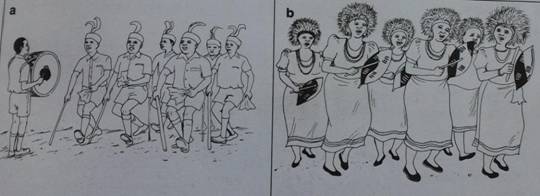
Multicultural dances are dances from different cultures. In Malawi, some of these dances are as follows:
MALIPENGA
- A dance for males.
- Malipenga is performed during weddings and mass rallies.
- Performed in Nkhatabay
- Mganda is a variant of Malipenga
- A Malipenga and Mganda group is known as boma
- Mganda is performed in Dedza, Ntchisi, Dowa and Lilongwe districts.
UYENI
- Performed by Ngoni women of Ntcheu.
- It is performed during installation of chiefs in Ntcheu district.
MASEWE
- Performed by boys among the Yao and the Lomwe.
- The dancers wear palm leaves or sisal fibre and rattles in ankles and wrists.
GULEWAMKULU
Performed by the Chewa and it is associated with the spirits of the dead. Gulewamkulu is performed during:
- Funeral ceremonies
- Initiation ceremonies
- Installation of chiefs
NGOMA
- Ngoma is the famous dance among Ngoni males of Ntcheu and Dedza districts.
- Dancers wear headgear, animal skins, and rattles worn on ankles and beads across the chest.
INGOMA
- Similar Ngoni dance performed in Mzimba and Mchinji districts in Malawi.
- Dancers wear headgear, animal skins, and rattles worn on ankles and beads across the chest.
ROLES OF WOMEN IN NGOMA/INGOMA DANCE
- Singing
- Clapping hands
- Ululating
VIMBUZA
- This is performed to activate a healer’s spiritual power (vimbuza) to cure his or her patients who are possessed with evil spirits.
- It is mostly performed in the northern part of Malawi among the Tumbuka, Tonga and Nkhonde people.
- Originally, only possessed persons performed the dance.
- This was normally done in the evenings.
- Nowadays, Vimbuza may be performed during the day as an entertainment by anyone who has skill.
MULTI-CULTURAL ARTISTIC ITEMS
Artistic items that are produced in different areas portray the characteristics of tribal ceremonies, beliefs and values.
People carve, model or weave what is needed in their communities.
For example, people in upland areas may carve mortars whereas people along the lakeshore may carve canoes.
MULTI-CULTURAL PERFORMANCES
Multicultural performances include dances, plays and songs. Plays help in conveying messages.
They are to entertain, educate and inform.
Plays involving urban people may have facts about the urban life, and plays involving rural people may have facts about rural life.
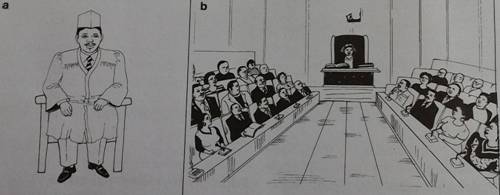
For actors to look real, they need to have proper costumes.

The costumes may be traditional or contemporary.
TEMPO AND DYNAMICS IN TRADITIONAL AND CONTEMPORARY MUSIC
Dynamics refers to the degree of loudness and softness of sound in a piece of music.
The most commonly used terms and symbols which represent dynamics in songs are:
PP (pianissimo) |
meaning |
singing very softly |
P (piano) |
meaning |
singing softly |
mp (mezzo piano) |
meaning |
singing moderately soft |
mf (mezzo forte) |
meaning |
singing moderately loud |
f (forte) |
meaning |
singing loudly |
ff (fortissimo) |
meaning |
singing very loudly |
fp (forte piano) |
meaning |
singing loud then get suddenly soft |
The following symbols are also important in dynamics

crescendo getting louder

decrescendo getting soft

fermata holding what one is singing for some time
Multicultural arts are activities from different cultures. Some songs and dances in African countries are similar.
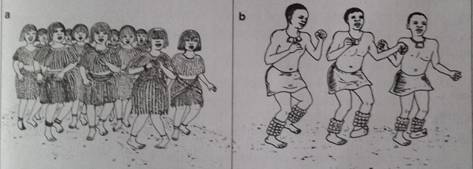
Malawi, Mozambique and Zambia have common musical instruments, dances and songs because some tribes are found in all the three countries.
The characteristics of the original songs and dances have changed because of different social environments.
PLAYS FROM AFRICAN STORIES
African stories are a rich source for creating plays for any purpose.
This is because the stories are rich in imparting customs, values and morals. In developing a play, from a story, you:
- Identify the theme of the story
- Develop a story line
- Identify characters in the story
- Develop scenes for the play based on the story
- Share roles to the actors and actresses
EXAMPLES OF THEMES IN STORIES
- Polygamy
- Land disputes
- Wife inheritance
- Leadership
Crafts include carvings, garments and fabrics.
DYES
- Dyes make things look bright and attractive.
- They also provide contrast and harmony in colours of fabrics and fibre.
- Dyes are either natural or artificial
- Natural dyes are made from plants.
- Artificial dyes are made from chemicals.
USES OF DYES
- Decorating fabrics
- Decorating fibre such as sisal, palm leaves, bwazi and luzi

ARTICLES THAT CAN BE MADE USING DYED FIBRE
- Hats
- Bags
- Mats
- Baskets
SOURCES OF NATURAL DYES
DYE |
SOURCE |
yellow dyes |
fruit, flowers and roots e.g., sunflower and curry |
orange dyes |
fruit, flowers and roots e.g. curry seeds in fruit |
red dyes |
leaves, flowers and tree bark e.g. mlombwa bark |
green dyes |
leaves e.g. tomato, pawpaw, and pumpkin leaves |
brown dyes |
charred nuts, brick powder and soils |
purple dyes |
fruit, flower and roots e.g. beetroot, sweet potato flowers |

TYPES OF DYES
- Cold water dyes
- These are dyes used in cold water
- Used for dyeing fabrics made from natural fibre such as cotton, silk, wool and linen
- Hot water dyes
- These dyes are suitable for natural fibre and not artificial or synthetic fibre.
- Salt, dye and the fibre or fabric are boiled together to fix the dye to the fabric or fibre.
- Usually, salt is used as a mordant to fix the dye.
- Other mordants are chrome, tin, copper sulphate, paraffin, cream of tartar and acetic acid
CHARACTERISTICS OF GOOD DYES
- Colours should not fade after repeated washing
- Colours should not fade in light
- Dyes should not discolour with body sweat
- Dyes should not come out when used with laundry materials such as bleaches
UNIT 10 CAREER DEVELOPMENT
Career development is a lifelong process of assisting an individual to explore his/her career aspirations, ambitions and interests.
Thereafter, the individual is assisted to choose a career he/she would like to pursue and prepare for. Local arts provide a wide range of opportunities for self-employment.
Careers in local arts such as crafts, pottery, weaving, music and wood carving are crucial in offering career opportunities and preserving the communities, cultures and identity.
One needs to explore career prospects that exist in the community.
this can be done through participation in career awareness activities such as career exhibiting, education tours, role modelling, career talks, career clubs, work session and occupation dissemination.
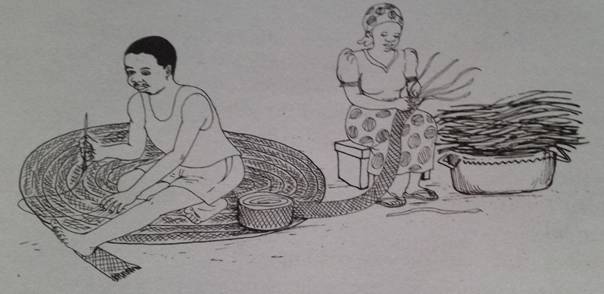
CAREER PATH DEVELOPMENT
Career path development is a lifelong process of assisting an individual to make informed choices and transitions in life.
It is a process of providing relevant career information and experiences to an individual.
One may have a career in formal employment (white collar) or informal employment (blue collar).
The way of providing career path development is by setting up a job shadowing experience to the learners.
Job shadowing is an unpaid experience where a learner follows a practitioner for a short period to learn about a particular occupation or industry.
THREE STAGES IN SETTING UP A JOB SHADOWING EXPERIENCE
- Pre-experience activities
- On-site activities
- Post-site activities
UNIT 11 DISCRIMINATION AND PREJUDICE IN ARTISTIC PERFORMANCES
There are many artistic performances that are done in our society.
These include;
- dances
- drama
- music
- sports.
When doing some of these performances, other sexes are not allowed to participate and this underrates their ability.
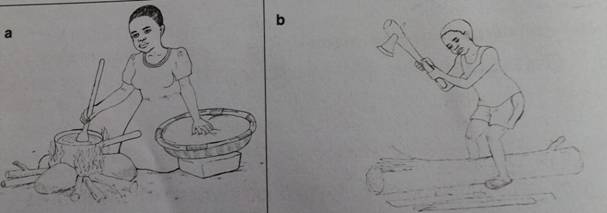
GENDER BIASES AND INEQUITY IN DANCES
Communities perform different traditional dances.
Some of these dances are gender specific for they are done by one sex only. These dances show gender bias as only one sex performs them.
Examples of these dances are Chimtali, masewe, uyeni and Malipenga. In some communities, dances are performed by both males and females. These dances promote gender equality as both sexes play similar roles. Such dances include tchopa, manganje and ngoma.
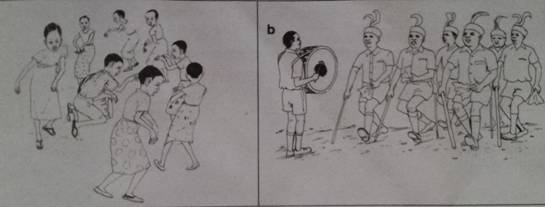
GENDER STEREOTYPED ART AND CRAFT ACTIVITIES
Some art and craft items are gender stereotyped.
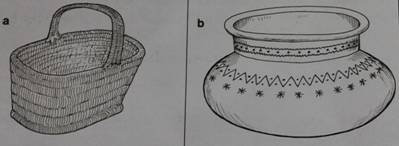
Stereotyping is referred to as having a fixed idea or image about a particular type of person or thing but which is not true in reality.
For example, crafts such as making hoe handles and mortars are associated with men, whereas sewing and knitting are associated with women.
Some of the stereotyped statements or roles still existing are;
- girls are good at pounding maize and caring the sick as compared to boys
- boys are better at mathematics than girls
PLAYS DEPICTING DISCRIMINATION AND PREJUDICE
Prejudice is the feeling of fear, hate and distrust of people who are different.
It is the intolerance or dislike for people of different or specific race, religion, culture, sex, background, colour of skin, eyes or hair, strangers or foreigners, without any reasonable facts.
Discrimination is showing bias or favouritism for specific people against the other.
Plays that tackle issues of prejudice and discrimination help to instill values in the community that will uplift the lives of those discriminated against.
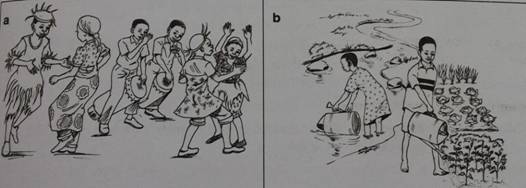
UNIT 12 MOVEMENT AND MANIPULATIVE SKILLS
Movement and manipulative skills in dances and other artistic performances require intelligence and imagination.
Movement is dynamic and spontaneous.
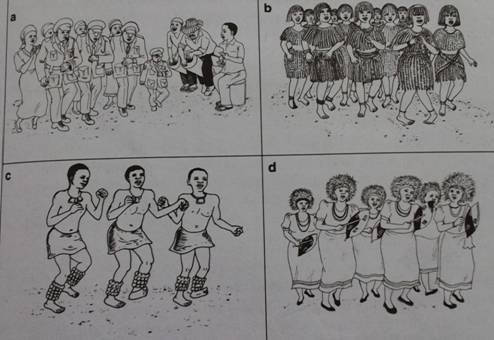
AFRICAN DANCING STYLES
In Africa, common dancing styles dwell on wriggling of the waist, stamping of the feet or shaking of the body trunk.
MANIPULATIVE SKILLS IN ARTISTIC ACTIVITIES
Manipulative skills in artistic activities help learners construct their knowledge by selectively using experiences around them.
The learners therefore should be actively involved in artistic activities which will help develop their manipulative skills.
These skills include throwing, catching, kicking, and striking in physical activities. Drawing, carving and modelling in art.
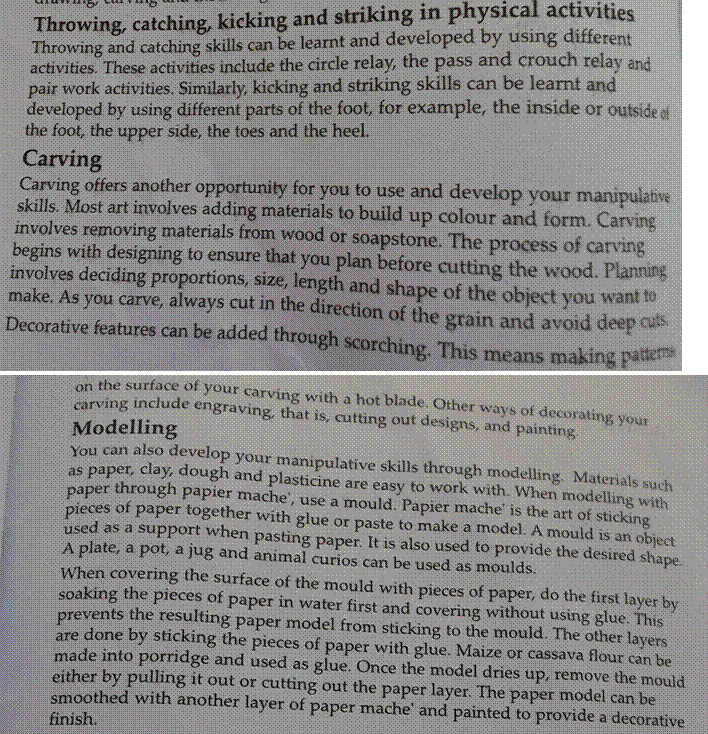
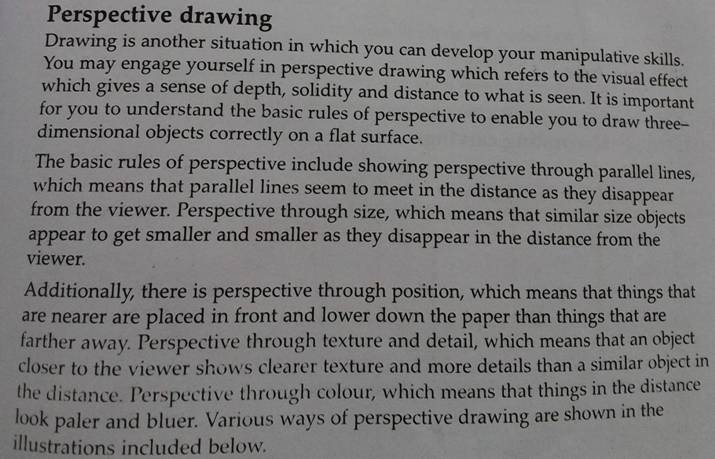
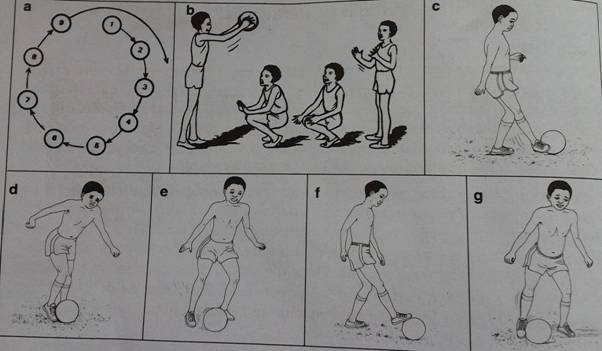
MODELLING THROUGH PAPIER MACHE
Modelling materials are usually soft and malleable. These include clay, dough, plasticine and paper.
These can be squeezed, pushed and pulled into shapes and extra pieces can be added.
When modelling with paper through papier mache, use a mould.
Papier mache is the art of sticking pieces of paper together with glue or paste to make a model. A mould is an object used as a support when pasting the pieces of paper.
It is also used to provide the desired shape.
A plate, a pot, a jug and animal curios can be used as moulds.
PERSIPECTIVE DRAWING
Perspective is the visual or optical effect which gives a sense of depth, solidity and distance to what is seen.
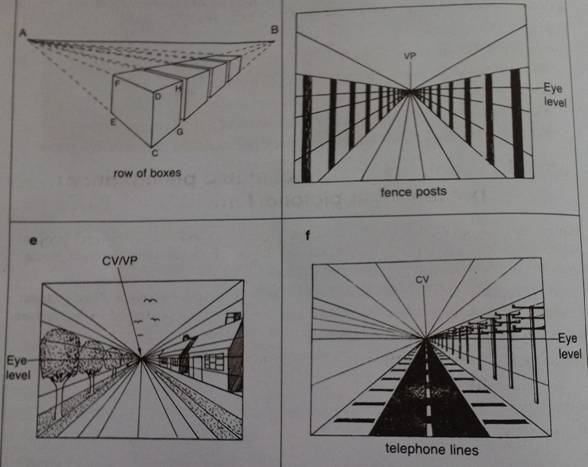
PROCEDURE FOR PERSIPECTIVE DRAWING
- Draw a rectangle which marks your drawing space.
- Then a line that passes through the middle across the rectangle is drawn.
- This line represents the horizon.
- This is the line where the sky seems to meet the earth.
- Mark the centre of vision (CV) or vanishing point (VP)
- And draw straight lines meeting at the centre of vision.
- These straight lines are used only as guides, hence, keep them faint.
- These lines indicate the proportion in which objects seem to reduce in size, height, detail and colour as they recede into the distance before they disappear from the observer at the vanishing point.
- After drawing the guideline, draw the objects intended to be drawn such as buildings, trees, boxes, people, animals, mountains, birds and roads.
- After completing all the details, the guide lines are erased.
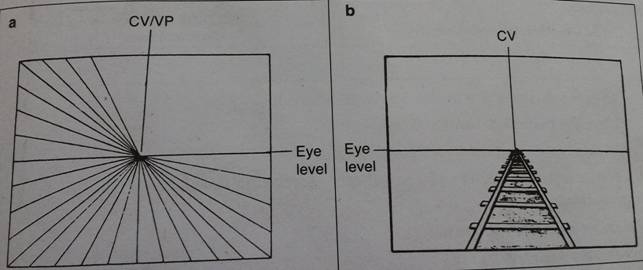
IDEALISED IMAGES OF ARTISTIC PERFORMANCES PRESENTED IN PICTORIAL FORM
There are many things that people imagine about. One example is heaven.
People have stories, imaginations and pictures of heaven. This is an example of an idealised image.
Great inventions come from imagination.
One way of turning ideas and images into real-life situations is through mimicking. Mimicking involves copying or imitating something and presenting it in a funny way. Imitation in mimicking can be in a form of voice or actions.
ENJOYMENT IN PERFORMING ARTISTIC ACTIVITIES
An expression of enjoyment comes in many different ways. These include:
- singing
- eating
- drinking
- visiting new places
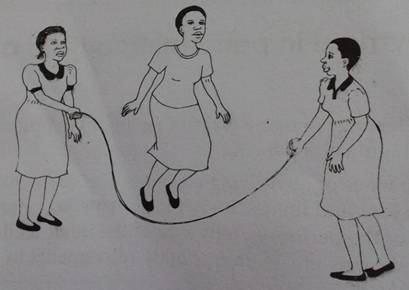
meeting friends
In performances people express their happiness and enjoyment through body expressions
HOW THE AUDIENCE CAN SHOW ENJOYMENT OF THE PERFORMANCE
- By jubilating
- By ululating
- By imitating
- By clapping hands
GLOSSARY
Cream of tartar = potassium hydrogen tartrate, an acidic crystalline compound used in baking powder. Curio (curios plural) a rare, unusual or intriguing object.
Dye (noun) colouring materials Fabric (noun) manufactured cloth
Grain (noun) the texture of wood, stone, etc.
Grain (uncountable noun) the pattern of lines seen or felt in wood, or layers of rock, coal, etc.
Guided drawing = it is the drawing in which learners are shown how to develop a drawing from basic structure
Mordant (noun) a substance that combines with a dye or stain thereby fixes it in a material. Plasticine (noun) a soft modelling material, used especially by children.
Scorching means making patterns on the surface by burning slightly with a hot blade
Tartar (noun) a deposit of impure potassium hydrogen tartrate formed during fermentation of wine. Tartrate (noun) a salt or ester of tartaric acid.
The whole = it is the general outline of the object or animal you want to draw and details are added later
REFERENCES
MIE (2008), Expressive Arts Teacher’s Guide for Standard 8 MIE (2008), Expressive Arts Learners’ Book for Standard 8 Concise Oxford English Dictionary, Eleventh Edition
Primary Expressive Arts, Questions and Answers Pamphlet compiled by H. Mlinde. MIE (2008), Sc
UNIT 1 SCIENTIFIC INVESTIGATIONS
UNIT 2 THE HUMAN CIRCULATORY SYSTEM
UNIT 3 THE HUMAN BREATHING SYSTEM
UNIT 4 IMPROVING THE NUTRITIONAL VALUE OF FOOD
UNIT 5 MEALS FOR INVALIDS, CONVALESCENTS, VEGETARIANS AND ELDERLY PEOPLE
UNIT 6 IMPROVING A TRADITIONAL KITCHEN
UNIT 7 IMPROVING THE QUALITY OF PRODUCTS
UNIT 8 FOOD PROCESSING
UNIT 9 REPRODUCTION IN HUMAN BEINGS
UNIT 10 SOLUTIONS AND MIXTURES
UNIT 11 METHODS OF COOKING
UNIT 12 TECHNOLOGIES FOR CONSERVING THE ENVIRONMENT
UNIT 13 ELECTRICITY AND ELECTRIC CIRCUITS
UNIT 14 FAMILY SIZE INCOME AND FOOD SUPPLY
UNIT 15 LAUNDERING CLOTHES AND BED LINEN
UNIT 16 HIV AND AIDS
REFERENCES
UNIT 1 SCIENTIFIC INVESTIGATIONS
Scientific investigation is the process in which a scientist designs and carries out experiments to obtain information
PLANNING A SCIENTIFIC INVESTIGATION
There are a number of things that are involved when planning a scientific investigation. Planning a scientific investigation involves the following things:
- Identifying the problem
- Stating the problem in the form of a question
- Predicting the possible solution to a problem
- Identifying what to observe or measure (variables)
- Identifying and collecting the resources that would be required to carry out the investigation.
- Deciding the steps to be followed in the process of collecting data
CONDUCTING A SCIENTIFIC INVESTIGATION
Once the investigation has been planned, it is then carried out.
This is when the hypotheses are tested by carrying out experiments.
Also, the variables to be investigated are deliberately changed while keeping the other variables constant.
This is what is meant by controlling and manipulating variables.
The variables that are changed are observed and recorded as the investigation is being conducted. The purpose of carrying out an investigation is to collect data through observation.
If one is not satisfied with the data collected, it is necessary to repeat the procedures.
When the data has been collected, it should be organised in such a way that it is meaningful. The data may be presented in the form of tables.
The procedures of organising data are referred to as data analysis. One of the ways of analysing data is the use of graphs.
After the data has been analysed, there is need to interpret it.
This may involve determining the relationship between variables using the analysed data.
The determination of the relationships between variables include:
- looking for patterns of data in a table
- interpreting the shapes of graph lines
Once the data has been analysed and interpreted, a conclusion can be drawn based on the results of the investigation.
The conclusion then becomes the solution to the problem investigated.
Conducting a scientific investigation involves:
- carrying out the investigation according to what has been planned
- collecting data and presenting it in a meaningful way
- analysing the data that have been collected
- interpreting the analysed data
- drawing a conclusion based on the results of the investigation
- writing a report of the investigation
REPORTING THE FINDINGS OF A SCIENTIFIC INVESTIGATION
After the scientific investigation has been completed, it is important to write a report.
The report can include:
- Topic of the investigation
- An introduction
- The methodology (methods used to conduct the investigation)
- The results (findings)
- The discussion of the results
- The conclusion
The possible solution to the problem is called a hypothesis.
Examples of the questions that can be investigated in science and technology:
- why does a fresh egg sink and a rotten one float on water?
- what is the speed of sound in air?
- what are the factors that affect the speed of sound in air?
- how different is the life cycle of grasshopper from that of a housefly?
- how can a particular variety of maize be improved in terms of yields?
- how is the pitch of sound affected by different sizes of bottles?
- which is the most effective biological control of aphids?
- how can the components of a given mixture be separated?
Variables are factors that would affect the results in the investigation. Variables is anything that can change.
THE PURPOSE OF WRITING A REPORT AFTER CONDUCTING A SCIENTIFIC INVESTIGATION
- to communicate the findings of the investigation to those who did not take part in the investigation.
- It acts as a record of what was done
- It gives people the opportunity to learn the findings, ask questions and comment on the investigation.
UNIT 2 THE HUMAN CIRCULATORY SYSTEM
The main parts of human circulatory system and their function
PARTS |
FUNCTION |
The Heart |
It pumps blood around the body |
The Arteries |
They carry blood away from the heart |
The Veins |
They carry blood to the heart |
The Capillaries |
They connect the arteries to the veins |
THE HUMAN CIRCULATORY SYSTEM
- Blood comes into the heart from all parts of the body through Posterior and Anterior vena cava and from the lungs through the Pulmonary vein.
- The blood goes out of the heart through the aorta to all parts of the body and through the pulmonary artery to the lungs.
- When blood comes from different parts of the body it is dark red in colour because it contains less oxygen and more waste products such as carbon dioxide and urea.
- The heart then pumps the blood to the lungs through the pulmonary artery.
- In the lungs, carbon dioxide is excreted while oxygen is added to the blood making it look bright red.
- The blood then goes back to the heart through the pulmonary vein where it is pumped to all parts of the body.

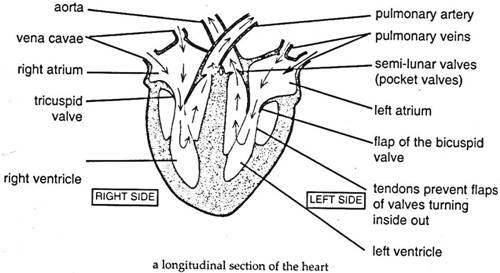
When the blood is circulating throughout the body, some of the following things happen:
- excretion of waste products such as urea from the kidneys
- diffusion of digested food particles around the intestines from where they are transported to the liver
It is the liver regulates or controls how much food should be transported by the blood. The liver also stores excess food.
COMPOSITION OF BLOOD
Blood is composed of:
- Plasma which is the liquid part of the blood
- Red blood cells which transport oxygen
- White blood cells which defend the body against disease causing organisms
- Platelets which help in the process of blood clotting.
BLEEDING
Bleeding is the process whereby blood oozes from the body.
CAUSES OF BLEEDING
- High blood pressure rapturing blood vessels especially in the nostrils
- Disease
- Tissue damage (injury)
EFFECTS OF EXCESSIVE BLOOD LOSS FROM THE BODY
- Anaemia
- Death
WAYS OF CONTROLLING BLEEDING
- Applying direct pressure on the injured part of the body
- Raising the injured part so as to reduce the amount of blood flowing to it.
- Clotting of blood (this is done naturally by the body)
Where there has been excessive loss of blood, a person may be given blood from other people through a process called blood transfusion.
This is why it is important that people should donate blood to hospitals so as to save the lives of others in cases of emergency.
UNIT 3 THE HUMAN BREATHING SYSTEM
Breathing is a process through which air is pushed in and out of the lungs.
The air which enters the body contains a lot of oxygen which later diffuses into the blood stream through the lungs.
The air which goes out of the body contains a lot of carbon dioxide which has diffused from the blood into the lungs.
For breathing to take place, there are several parts and structures that are involved. For example, nostrils, windpipe (trachea), lungs, ribs, and the diaphragm.
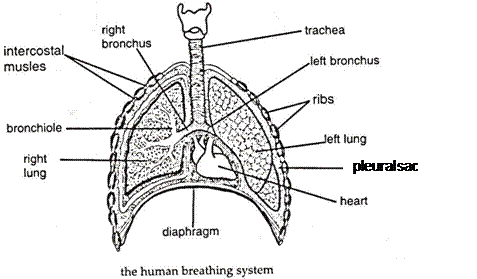
BREATHING MECHANISM
The breathing mechanism works in two phases which are Inspiration and Expiration.
INSPIRATION
This is a process of breathing in air and is also referred to as inhalation.
During inspiration, the diaphragm contracts and becomes flat, the ribs move up and out due to the contraction of the external intercostal muscles.
Due to the movement of the ribs, the volume of the thorax (chest cavity) increases.
Air pressure inside the chest cavity decreases thereby making it lower than the atmospheric pressure.
This causes the air to rush into the lungs
EXPIRATION
This is a process of breathing out air and is also referred to as exhalation.
During expiration, the diaphragm relaxes and moves upwards into the thorax, forming a dome shape.
The ribs move down and inwards due to the relaxation of the external intercostal muscles Due to the inward movement of the ribs, the volume of the thorax decreases.
The air pressure inside the chest cavity therefore increases, making it higher than the atmospheric pressure.
This forces air out of the lungs.
When the air enters through the nose (nostrils), it passes through the trachea (windpipe), then through the bronchus, then into the lungs through the bronchioles.
Finally, it goes to air sacs or alveoli where the exchange of oxygen and carbon dioxide takes place.
PROBLEMS AND CARE FOR THE HUMAN BREATHING SYSTEM
Problems that can affect breathing system are:
- Smoking
- Air pollution
- Diseases
- Suffocation
- Smothering
WAYS OF CARING FOR THE HUMAN BREATHING SYSTEM
- Avoid Smoking
- Tobacco smoking is dangerous to the breathing system
- It can lead to diseases such as lung cancer, asthma, bronchitis and tuberculosis
- Tobacco also contains a dangerous chemical known as nicotine
- Smoking other substances such as Indian hemp and traditional medicines can lead to the same effects. So smoking is hazardous to health and must be avoided.
- Avoid air pollution
- Being in a places where air is heavily polluted can lead to problems that can affect the breathing system.
- It is important to avoid areas where the air is polluted.
- Eat a balanced diet and go for regular medical check-ups to prevent diseases that can affect breathing system
- Diseases such as cancer, asthma, bronchitis and tuberculosis (TB) can affect breathing system
- Live in well ventilated places to avoid suffocation
- Suffocation is a situation whereby air cannot pass out of the lungs either through choking or strangulation
- Avoid covering oneself with air proof materials to prevent smothering
- Smothering is a situation where air cannot get into the mouth or nose, for example, if clothing or plastic bag covers the face.
UNIT 4 IMPROVING THE NUTRITIONAL VALUE OF FOOD
IMPROVING THE NUTRITIONAL VALUE OF FOOD
Various foods contain different types of nutrients.
For instance, meat contains proteins, fats, vitamins and mineral elements. The nutritional value of food refers to the major nutrients the food contains.
Improving the nutritional value of food means enriching the food with other nutrients by preparing the foods together.
Ways of improving the nutritional value of food
- Combining several foods when cooking
- Adding enriching food to dishes
- Overcooking fish to soften the bones so that they can be eaten together with the flesh
- Cooking some foods in their skins or together with the skin
- Using one pot meals
Factors to consider when planning, preparing, cooking and serving dishes with improved nutritional value
- The method of cooking
- Colour, texture and flavour of food
- Season of the year
- Ensure that the meals are nutritionally balanced
THE NEGATIVE EFFECTS OF POOR NUTRITION ON THE FAMILY, COMMUNITY AND THE NATION
- Malnutrition
- Stunted growth among children
- Poor mental capacity
- Increased risk of chronic illnesses
- High mortality rate among children
- Low productivity in everyday activities
- Strain on the economy of the country
- Low standards of living
THE POSITIVE EFFECTS OF GOOD NUTRITION ON THE FAMILY, COMMUNITY AND THE NATION
- Healthy population
- Proper growth in children
- High productivity in everyday activities
- Good nutritional status of the population
- High standards of living
UNIT 5 MEALS FOR INVALIDS, CONVALESCENTS, VEGETARIANS AND ELDERLY PEOPLE
People can be categorized into different groups depending on their nutritional needs. These include:
- Invalids
- Convalescents
- Vegetarians
- The elderly
- Invalids
Invalids are people who are ill
- Convalescents
Convalescents are people recovering from an illness
- Vegetarians
Vegetarians are people who do not eat meat or animal products
- The elderly
The elderly are people above the age of 65 years
MEALS FOR INDIVIDUAL NUTRITIONAL NEEDS
INVALIDS
Invalids use less energy therefore they require fewer carbohydrates and fats.
Their meals should contain more proteins and protective foods for the replacement of damaged tissues and cells.
GUIDELINES TO CONSIDER WHEN PLANNING MEALS FOR AN INVALID
- The meal should be easy to digest
- Liquid diet should be given
- Following doctor's instructions on meals
- Taking into account particular likes and dislikes for food
- Not serving leftover food to avoid contamination
- Paying careful attention to food hygiene
- Preparing food away from the patient
- Serving meals in a tray and in small portions
Convalescents
The guidelines for planning meals for convalescents are similar to those of the invalids. The only difference is that the convalescent's appetite is better and serving is easier.
Vegetarians
There are two types of vegetarians.
- Lacto-vegetarians
- Strict vegetarians
Lacto-vegetarians are those who eat vegetables and animal products such as eggs, milk, cheese, yoghurt, ghee and sour milk (chambiko).
Strict vegetarians are people who eat vegetables only.
Reasons for becoming vegetarians
- Religion
- Health
- Animal welfare
- Taste
- Allergy
Planning meals for vegetarians can be difficult because of lack of proteins, vitamins A and D, calcium and iron from animal sources.
POINTS TO CONSIDER WHEN PLANNING MEALS FOR VEGETARIANS
- Providing sufficient proteins from animal products for lacto-vegetarians
- Using plenty of vegetable proteins such as peas, beans and groundnuts for strict vegetarians
- Providing foods rich in oils and fats from plant sources
- Using a variety of methods of cooking and serving with different combinations to bring variety to vegetarian diets
- Serving large portions for maximum supply of proteins
Elderly people
Elderly people need a special diet because their bodies do not function as efficiently as when they were young.
GUIDELINES FOR PREPARING PLANNING MEALS FOR THE ELDERLY PEOPLE
- An adequate supply of calcium and vitamins is needed for healthy bones and preventing infections
- Iron is needed as elderly people may suffer from anaemia
- Food should be easy to eat because their teeth may not be very strong
- Ensuring a good supply of dietary fibre to help in the digestion of food
- Meals should contain more fruits, vegetables and less fat
- Providing plenty of fluids in the form of water and other beverages
- Meals should be served attractively
UNIT 6 IMPROVING A TRADITIONAL KITCHEN
TYPES OF KITCHENS
- The modern kitchen
- Traditional kitchen
These kitchens are found in both urban and rural areas.
THE MODERN KITCHEN
The modern kitchen is part of the main house. It is found inside the house.
Though a modern kitchen is built as part of the main house, the outside walls must have sufficient windows for good lighting and ventilation to avoid eye strain.
The kitchen should also be closed off from the rest of the house to prevent cooking odours from entering the rest of the rooms in the house.
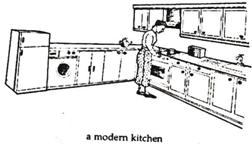
MAIN FEATURES OF A MODERN KITCHEN
- Preparing centre
- Cooking centre
- Storage centre
- Washing centre
THE TRADITIONAL KITCHEN
The traditional kitchen is the most common type of kitchen in Malawi.
TYPES OF TRADITIONAL KITCHENS
- The open-air kitchen
- An enclosed kitchen
THE OPEN-AIR KITCHEN
This type of kitchen is usually in the open outside the house.
It is common in the dry season mainly to boil water for domestic purposes and cook food. The following illustration on the next page shows an open-air kitchen.
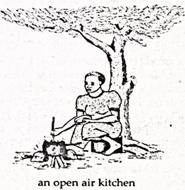
AN ENCLOSED KITCHEN
This kitchen is in the form of a hut and is located outside the main house. It is constructed of materials such as poles, bricks, reeds and mud.
The roof is made of poles and thatched with grass. In some cases, the kitchen does not have windows. As such, the main source of ventilation is the door.
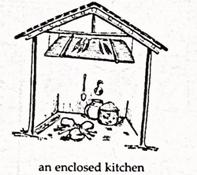
The three-stone fireplace is the one commonly used as the cooking centre.
Both open and enclosed kitchens have the kitchen centres located far away from each other. This arrangement is not good.
A lot of time and energy is spent walking between the centres. This makes the traditional kitchen not efficient.
The centres are:
- The storage centre
- The preparation centre
- The cooking centre
- The washing centre
COMPARISON OF A MODERN AND A TRADITIONAL KITCHEN
Modern kitchen |
Traditional kitchen |
|
|
STRENGTHS AND LIMITATIONS OF A TRADITIONAL KITCHEN
The strengths of a traditional kitchen are;
- easy to construct
- easy to maintain
LIMITATIONS OF TRADITIONAL KITCHEN
- a lot of smoke is produced
- the food cooked in a three-stone fireplace can have a smoky flavour if not cooked properly
- there is wastage of fuel energy
- space is limited
- the traditional kitchen does not have work surfaces and there is no running water.
WAYS OF IMPROVING THE TRADITIONAL KITCHEN
- making a kitchen with a window and a chimney
- fixing surfaces and shelves to an already existing kitchen
- making a drying rack outside the kitchen for drying pots and plates
- constructing a mud stove with more than one cooking place to save fuel and time
CONSTRUCTING A MUD CUPBOARD
The materials and equipment required for constructing a mud cupboard are:
- Poles
- Soil
- Bamboo
- Water
- Nails
- Panga knives
- Buckets
- Strings
- A piece of rope
- A hoe
CONSTRUCTING A SHELF
The materials and equipment required for constructing a shelf are
- Bamboo strips
- Reeds
- Grass
- Millet or maize stems
- Sticks
- Poles
- Pieces of string
CONSTRUCTING A DRYING RACK WITH A SOAK PIT
The materials and equipment required for constructing a drying rack are:
- Poles
- Bamboo strips
- Pieces of string
- A hoe
- Chilaya (a tool for digging hoes)
- Panga knives
- Nails
- A hammer
UNIT 7 IMPROVING THE QUALITY OF PRODUCTS
Some of the locally produced products in the community such as wood carvings, mats, clay pots, mortar and hoe handles may not be of high quality.
It is therefore important to improve their quality.
Quality guarantees that the products are of a high standard.
There are many ways of improving the quality of a product. These ways include:
- improving the smell
- improving the taste
- improving the appearance
- improving the colour
- improving the volume
- improving the shape
- packaging
- decorating
- labelling
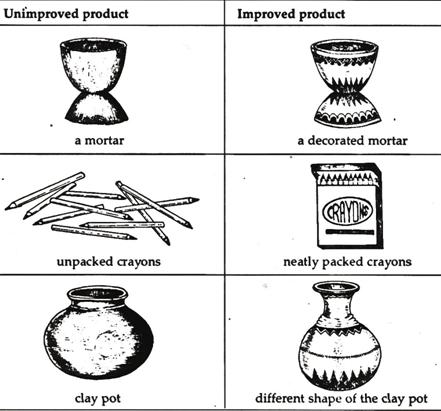
The following table shows some suggestions of how the quality of products can be improved:
THE IMPORTANCE OF IMPROVING THE QUALITY OF PRODUCTS
- Products of high quality can help to build confidence in the consumer.
- The producer is assured of high sales at a better price.
- Quality assurance ensures that the products are manufactured consistently and are attractive.
NEGATIVE EFFECTS OF IMPROVING THE QUALITY OF PRODUCTS
- the products may become expensive and slow to sell
- some materials used for improving the quality of the products may not be found locally and can be expensive
UNIT 8 FOOD PROCESSING
Food processing refers to the methods that are used to change raw ingredients into food products for human and animal consumption.
REASONS FOR PROCESSING FOOD
- improving flavour, texture and appearance
- preserving the food
- improving the quality of food
- preventing wastage
- improving the livelihood of people
WAYS OF PROCESSING FOOD
There are two main ways of processing food. These are primary and secondary processing.
PRIMARY PROCESSING
Primary processing involves raw ingredients for sale, consumption or making them ready for cooking.
Examples include:
- grinding grain into flour
- sorting and washing vegetables
- extracting oil from seeds and nuts
- soaking cassava
- fermenting cereals such as millet, sorghum and making for making chimera
- soaking mphale to make flour
- pounding cereals such as rice and maize
SECONDARY PROCESSING
Secondary processing involves turning basic processed foods into new products.
Examples include:
- making margarine from oil
- making bread, cakes and biscuits from flour
- making jam from fruits
- making juices from fruits
- making thobwa from chimera
- making thobwa, starch, nsima from cassava flour
- making chambiko/cheese from milk
- making peanut butter from groundnuts
ADVANTAGES OF FOOD PROCESSING
- improving the taste, flavour and appearance of food
- preserving the food
- improving the quality of food
DISADVANTAGES OF FOOD PROCESSING
- loss of nutrients during processing
- some of the methods used in processing food are not hygienic
- some methods used in processing can lead to wastage
- food processing can lead to increase in the cost of food
UNIT 9 REPRODUCTION IN HUMAN BEINGS
THE PROCESS OF CONCEPTION IN HUMAN BEINGS
Human life begins at the moment of conception.
During sexual intercourse, a man ejaculates millions of sperms contained in a liquid called semen. The sperms are deposited in the vagina.
From there, they swim up to the uterus through the cervix into the fallopian tubes to meet the egg (ovum).
The sperm unites with the egg.
This is called conception or fertilisation.
The union of the sperm and egg results in the formation of a single cell called a zygote.
Once the successful sperm has entered the egg, no other sperm can get in. Eventually, all the unsuccessful sperms die.
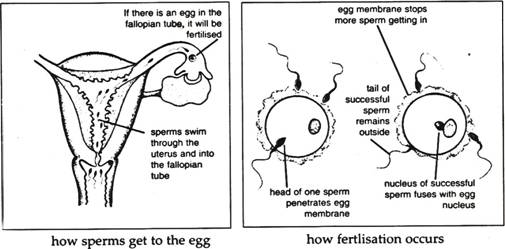
DEVELOPMENT OF THE EMBRYO
Once fertilisation has taken place, the zygote passes from the fallopian tube to the uterus. As it does so, it develops into an embryo.
It takes about five days for the embryo to reach the uterus to which it is attached.
. 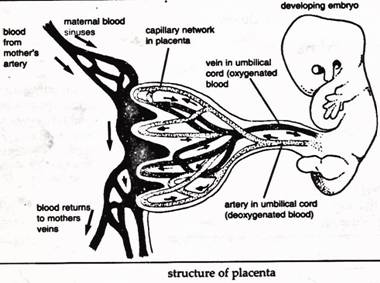
This is called implantation
A membrane known as the amnion encloses the embryo in a fluid-filled cavity.
The fluid protects the embryo, supports it and allows it to move freely during growth. During birth the fluid lubricates and reduces friction in the vagina.
During implantation the placenta develops in the walls of the uterus.
The embryo is attached to the placenta by a tube called the umbilical cord.
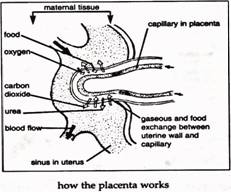
FUNCTIONS OF THE PLACENTA
- it allows dissolved food substances and oxygen to diffuse from the mother's blood into that of the embryo
- it allows waste products such as urea and carbon dioxide to diffuse from the blood capillaries of the embryo to the mother's blood stream
- it allows antibodies to diffuse from the mother's blood into the blood capillaries of the embryo. The antibodies protect the embryo against diseases.
THE DEVELOPMENT OF THE FOETUS
The embryo continues to grow and forms tissues and organs.
After eight weeks, when all the organs are formed, the embryo is called foetus. By the fifth month, the heart can be heard beating through a stethoscope.
By the end of the sixth month, the baby has grown eyelashes and eyebrows.
During the first six to seven months, the foetus moves freely in the uterus and its movements can be felt by the mother.
The placenta continues to grow as the foetus grows bigger.
About nine months from conception, the baby is ready to be born.
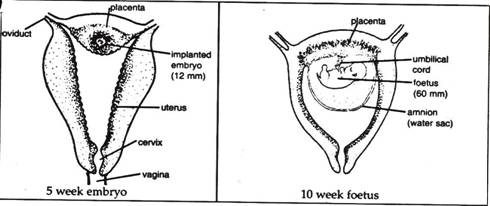
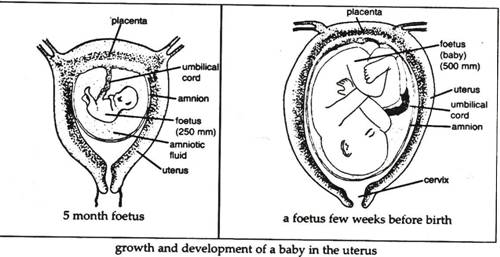
THE SIGNS AND SYMPTOMS OF PREGNANCY
- menstruation stops to occur
- morning sickness
- increase in body weight
- enlargement of breasts and abdomen
In some cases the following signs and symptoms of pregnancy can also occur
- vomiting
- nausea
- being choosy about food
- feeling dizziness
- swelling of legs
- craving for unusual food and other substances like soil and sour things
- change in appetite
- teeth problems due to loss of calcium to the baby
- changing moods
- changes in the pigmentation of the skin
- anaemia
- maternal morbidity
Some of the signs and symptoms will disappear in the early stages of pregnancy, but others will disappear soon after delivery.
While the above signs and symptoms are indicators of pregnancy, it is important to have a medical examination for confirmation.
THE NEEDS OF A PREGNANT WOMAN AND AN UNBORN BABY
DIETARY NEEDS
- a balanced diet
- plenty of clean and safe drinking water and other fluids but not alcoholic drinks
HEALTH NEEDS
- undergoing regular medical check-ups at antenatal clinics
- taking regular baths and wearing clean clothes
- not smoking or taking of drugs without prescription by a medical doctor
PSYCHOLOGICAL NEEDS
- love
- care
- understanding from all people around her
PHYSIOLOGICAL NEEDS
- proper attire such as loose clothes and flat shoes
- regular moderate physical exercises
CARE FOR THE BABY
Caring for the baby involves:
- following good feeding habits
- the provision of complementary feeding at the appropriate age of the baby
- weighing the baby to monitor growth and development at a clinic or health centre
- immunisation against diseases such as polio, tuberculosis (TB) and measles
- provision of vitamin A and deworming tablets
- diagnosis and treatment of infections
- regular baths and wearing of clean clothes
- adequate sleep
THE COMMON DISEASES OF CHILDREN AND THEIR EFFECTS COMMON DISEASES OF CHILDREN
- whooping cough
- tetanus
- TB
- malaria
- diphtheria
- polio
- measles
- diarrhoeal diseases such as dysentery
EFFECTS OF THE DISEASES IN CHILDREN
- paralysis and deformity of limbs in the case of polio
- deafness in the case of measles
- dehydration in the case of diarrhoeal diseases
- pneumonia
- anaemia
- death resulting from any of these diseases
PREVENTION OF THE COMMON DISEASES OF CHILDREN
- immunisation against polio, whooping cough, TB, tetanus, diphtheria and measles
- following general rules of hygiene against diarrhoeal diseases
- sleeping under a treated mosquito net to prevent malaria
THE IMPORTANCE OF UNDER-FIVE CLINICS
- routine check-ups on the health of children
- routine monitoring of the weight of children
- giving advice on feeding, vaccination and nutrition for both the mother and the baby
- administering BCG vaccine to prevent TB, DPT vaccine to prevent diphtheria, whooping cough and tetanus, and other vaccines to prevent polio and measles
- provision of vitamin A
- treatment of common infections
FAMILY PLANNING
Family planning is practicing some form of birth control to space out births and limit the size of the family.
SOME REASONS FOR FAMILY PLANNING
- it can improve the well-being of families because couples can have fewer children who can be provided with enough food, clothing and schooling
- women can protect themselves from unplanned pregnancies
- it helps to save the lives of children because parents can properly take care of them
- it can help nations to develop because the people's economic situation improves greatly in countries where women have fewer children
FAMILY PLANNING METHODS
- natural methods
- use of condom
- use of contraceptive pill
- Vasectomy
- Spermicides
- The diaphragm
- Intra-uterine device (IUD)
- Tubal ligation (TL)
- Norplant implants
NATURAL METHODS
The natural methods of family planning depend on knowing when ovulation occurs.
USE OF CONDOM
A male condom is worn on an erect penis before sexual intercourse.
or
A female condom is inserted in the vagina before sexual intercourse. This prevents sperm from reaching the egg.
USE OF CONTRACEPTIVE PILL
Contraceptive pills are taken each day between menstrual periods. The pills suppress ovulation and so prevent conception.
VASECTOMY
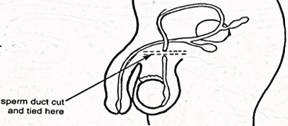
This involves a surgical operation in which the man’s sperm ducts are cut and the ends sealed or tied.
SPERMICIDES
Spermicides are chemicals in the form of a cream, gel or foam that are used to kill or immobilise sperms.
THE DIAPHRAGM
This is a rubber disc that can be placed in the vagina before sexual intercourse. It covers the cervix and so prevents sperms from entering the uterus.
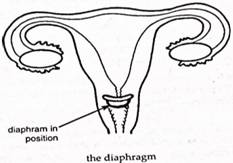
INTRA-UTERINE DEVICE (IUD)
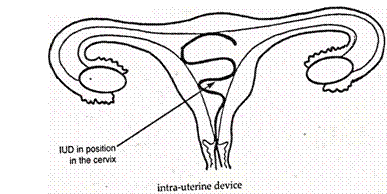 This is a small metal or plastic strip bent into a loop or coil that is inserted in the uterus where it prevents implantation of the embryo.
This is a small metal or plastic strip bent into a loop or coil that is inserted in the uterus where it prevents implantation of the embryo.
TUBAL LIGATION (TL)
This involves sterilising a woman by an operation in which the oviducts are cut and tied.
This operation does not affect the ovaries, sexual desire or menstruation, but sperms cannot reach the egg.
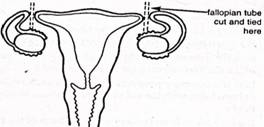
The eggs that are released break down in the upper part of the oviduct.
NORPLANT IMPLANTS
This is a set of six small plastic capsules that are placed under the skin of a woman’s upper arm.
UNIT 10 SOLUTIONS AND MIXTURES
MIXTURES
When two or more types of substances are put together, a mixture can be formed. Mixtures can be formed in a number of ways.
These include:
- mixing a liquid with another liquid
- mixing a solid with another solid
- mixing a solid and a liquid
- mixing a liquid and a gas
- mixing a gas and another gas
In some mixtures, the components can easily be seen like a mixture of maize flour and water. Such mixtures are called suspensions
In some mixtures, like salt and water, its components cannot be recognised. Salt disappears in water. The mixture appears as if it were one substance. Such mixtures are called solutions.
When sugar is mixed with water and stirred, it disappears in the water. The visible particles of sugar break down into invisible particles. These particles spread throughout the water producing a clear solution. This process is called dissolving.
A substance that dissolves in another substance is called a solute. A substance in which something dissolves is called a solvent.
Substances that dissolve in water are said to be soluble in water. Those that do not dissolve in water are said to be insoluble in water.
FACTORS AFFECTING THE RATE OF SOLUBILITY OF SUBSTANCES IN WATER
- size of particles
- temperature
- stirring
- nature of substance
SEPARATION OF MIXTURES
Components that form mixtures can be separated using different methods.
METHODS OF SEPARATING MIXTURES
- handpicking
- winnowing
- sieving
- decanting
- filtration
- evaporation
- distillation
- magnetism
HANDPICKING
Large components in a mixture can be separated by picking.
For example beans can easily be handpicked from a mixture of beans and sand.
WINNOWING
This method is used to separate solid mixtures.
During winnowing the lighter solids are carried away by sand. The heavier ones remain in the winnower.
SIEVING
Solid mixtures can be separated using this method.
Smaller particles pass through the sieve while the bigger ones remain behind. Solid particles can also be separated from a liquid using this method.
For example tea leaves from tea.
DECANTING
When a liquid forms a clear boundary with another liquid one liquid can be poured off leaving the other liquid behind.
A mixture of water and paraffin or suspensions can be separated using this method.
FILTRATION
Filtration is a method of separating a solid substance from a liquid or a gas using a filter. The liquid or gas passes through the filter while the solid ones remain behind.
The substance that passes through a filter is called a filtrate.
The substance that does not pass through a filter is called a residue.
EVAPORATION
A solution is heated gently to evaporate the liquid part and leave behind the solid part in the container.
For example a solution of salt and water can be separated using this method.
DISTILLATION
This is used to separate liquid mixtures with components of different boiling points.
The liquid that boils first evaporates and its gas is passed through a delivery tube via a condenser where it is cooled and changed into a liquid again.
This liquid is then collected in the container as a distillate, for example kachaso.
MAGNETISM
Magnetism can be used to separate magnetic materials from non-magnetic ones.
The magnet attracts magnetic materials only from the mixture leaving the non-magnetic ones behind.
For example iron particles cab be removed from sand in this way.
UNIT 11 METHODS OF COOKING
Methods of cooking can be categorized into dry and moist heat methods. Dry methods include frying, baking and roasting.
Moist methods include boiling, steaming and stewing.
BAKING METHOD
This is a method of cooking food using dry heat in an oven or in a pot.
When baking using a pot, hot charcoal is placed on top and underneath or hot sand is placed beneath and hot charcoal on top.
Examples of the food that can be cooked using baking method include scones, cakes, chigumu/chikondamoyo, chimimina, biscuits, pudding, fish and root vegetables.
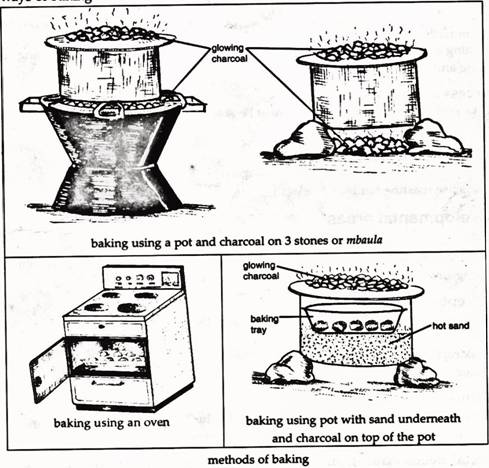
ADVANTAGES OF BAKING FOOD
- food does not break up if cooked well
- no soluble nutrients are lost
- the food looks attractive
- flavour is improved
DISADVANTAGES OF BAKING FOOD
- uses a lot of fuel
- most baking ingredients are expensive
- needs careful attention
- not suitable for cooking food for the sick
ROASTING METHOD
Roasting is cooking food with a little oil or fat in an oven or saucepan or without oil or fat over glowing charcoal fire.
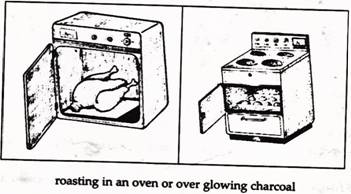
Examples of food that can be roasted include meat, fish, green maize, potatoes and cassava.
ADVANTAGES OF ROASTING
- the food looks attractive
- a cheap method of cooking food
- only few soluble nutrients are lost
- the flavour of the food is improved
DISADVANTAGES OF ROASTING FOOD
- incorrect roasting can harden the inside proteins
- roasting causes food to lose much of its moisture
- not suitable for cooking food with a high percentage of water like root vegetables
- does not make food tender
- the method demands more attention
- the food shrinks during roasting
- over-roasting burns or spoils the food
SIMILARITIES BETWEEN BAKING AND ROASTING FOOD
- they are both dry methods of cooking food
- cooking can be done inside an oven or in a saucepan over a fire
- in both methods cooked food is attractive
- the flavour of the food is improved
DIFFERENCES BETWEEN BAKING AND ROASTING FOOD
- oil in baking is used for greasing baking tins so that the food does not stick to the tin whereas oil in roasting is used to aid stewing
- ingredients in baking are more expensive than in roasting
UNIT 12 TECHNOLOGIES FOR CONSERVING THE ENVIRONMENT
MEANING OF ENVIRONMENT
The term 'environment' refers to the total surrounding of living things. It includes land, soil, water, air, vegetation, animals and buildings.
IMPORTANCE OF ENVIRONMENT
The environment is vital for the survival of living things.
All living things depend on the environment for basic necessities such as food, shelter, air, warmth and water.
For living things to survive, they need a sustainable environment.
ACTIVITIES THAT CAN LEAD TO THE DESTRUCTION OF THE ENVIRONMENT
- deforestation
- setting bushfires
- overgrazing
- poor land husbandry practices
- poor waste disposal
- excessive use of inorganic fertilisers, herbicides and pesticides
- emissions of harmful gases
- poaching
- charcoal production
- use of inefficient energy stoves
- discharge of untreated sewage into water bodies
EFFECTS OF DESTROYING THE ENVIRONMENT
- desertification
- erratic rains leading to droughts and floods
- global warming
- adverse change in weather and seasons
- outbreak of diseases such as cancer and cholera
- low agricultural output leading to famine
- soil erosion
- scarcity of water
- decrease of animal population
- siltation
- loss of tourism
TECHNOLOGIES FOR CONSERVING THE ENVIRONMENT
- solar driers
- solar cookers
- biogas
- fuel saving stoves
- compositing
- solar panels (photovoltaics)
- solar heaters
- A-frame
- paper recycling
- briquettes
- dam
MAKING A SOLAR HEATER/COOKER
Materials needed for making a solar hear or cooker are:
- Two cardboard boxes, one slightly bigger than the other
- One cardboard sheet for the lid. This must be large enough to cover the top of the finished heater
- One roll of aluminium foil
- Black paint or charcoal paste
- 1 cup of glue
- A sheet of glass or transparent plastic paper
- A knife
UNIT 13 ELECTRICITY AND ELECTRIC CIRCUITS
SOURCES OF ELECTRICITY
There are many sources of electricity. These are primary and secondary sources.
Primary sources produce electricity directly, that is, by connecting a source to a load. Secondary sources produce electricity through an intermediary such as a generator.
Some of the sources of electricity are:
- wind power
- geo-thermal power
- hydro-power
- chemical energy
- thermocouple which is a junction of two different metals
- solar energy
USES OF ELECTRICITY
- heating
- ironing
- cooking
- lighting
- cooling
- cleaning
- drying
- communication
- entertainment
- mixing things
- propelling machines
- air conditioning
- washing
Devices that use electricity must be part of a complete circuit.
The symbols are used to represent parts of the electric circuits such as cells, bulbs, switches, wires or connectors and fuses.
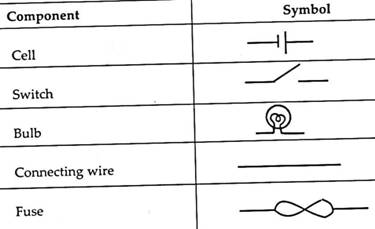
The symbol for a cell has one long line representing the positive terminal and the short one for the negative terminal.

A cell
SERIES AND PARALLEL CIRCUITS
A series circuit is constructed by connecting components such that they lie along one conducting path.
If an electric circuit has more than one conducting path, it is called a parallel circuit.

A series circuit

a parallel circuit
A parallel circuit is better than a series circuit because in a parallel circuit:
- the components can be controlled separately
- each component uses the total voltage from the source
HOW BULBS GIVE LIGHT
A bulb gives light when, for example, it is connected to a cell.
The electric current that flows in the electric circuit causes the bulb to give light.
The electric current in the tungsten wire in the bulb meets resistance which results in the production of heat.
The tungsten wire glows and gives off light because of the heat.
WAYS OF GENERATING ELECTRICITY USING LOCALLY AVAILABLE RESOURCES
Electricity can be generated by using locally available resources.
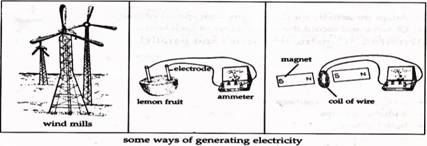
UNIT 14 FAMILY SIZE, INCOME AND FOOD SUPPLY
FAMILY SIZE
Family size refers to the number of people in a family. Some families are generally big while others are small.
INCOME
This is the amount of money one gets regularly as payment for work or from trading, sale of farm produce or other forms of livelihood.
FOOD SUPPLY
This is the amount of food available for consumption.
Food can be made available to a family by producing their own or buying. This can ensure food security at the household level.
RELATIONSHIP AMONG FAMILY SIZE, INCOME AND FOOD SUPPLY
Family size determines the amount of food to be available to family members for consumption.
The amount of food available to a family depends on the amount of money available for buying food or how much food the family can produce.
UNIT 15 LAUNDERING CLOTHES AND BED LINEN
TYPES OF FABRICS
Fabrics from which clothes and bed linen are made are classified into two main groups. These are natural and synthetic fibres.
NATURAL FIBRES
These are made from plants, animals and minerals.
For example:
- plant fibres - cotton and linen
- animal fibres - wool, silk and leather
- mineral fibres - fibreglass, aluminium and asbestos
SYNTHETIC FIBRES
These are fibres that are made by people.
Examples include polyester, nylon, rayon and acetate. These are made from chemicals.
LAUNDERING CLOTHES AND BED LINEN
When laundering clothes and bed linen, the following are required: water, soap, bleaches, starch and stain removals.
Laundry equipment that can be used include pails, basins, bathtubs, sinks, pegs, line on which clothes can be dried, pressing iron, ironing table or ironing board, mats, ironing stands, angers, ironing blankets and sheets.
The main processes in laundry are sorting, mending, soaking, washing, drying, pressing, airing and storing.
It is important to sort out articles according to colour, degree of dirt, types and uses of fabric.
UNIT 16 HIV AND AIDS
AIDS is a killer as well as a contagious disease.
AIDS stands for Acquired Immune Deficiency Syndrome. The disease is caused by a virus called HIV.
HIV stands for Human Immunodeficiency Virus.
The virus destroys the immune system of the body making it prone to different infections. The word human means that the disease affects people only.
HIV TRANSMISSION
HIV can be transmitted in the following ways:
- unprotected sexual intercourse with an infected person
- infected pregnant mother passing the virus to the child during pregnancy, birth or breastfeeding
- through blood transfusion when the donor is infected
- transfer of the virus through the blood of an infected person to an uninfected person through sharing of skin cutting objects such as razor blades and needles
COMMON INFECTIONS ASSOCIATED WITH HIV AND AIDS
- TB
- meningitis
- cancer
- skin infections
HIV AND AIDS PREVENTION
HIV and AIDS can be prevented in the following ways:
- abstinence from sex
- being faithful to one life-long uninfected sexual partner
- using condoms correctly and consistently during sexual intercourse
- avoiding having more than one sexual partner
- avoiding certain behaviours such as taking intoxicating drugs and substances
- avoiding sharing skin cutting objects such as razor blades and needles
- infected females should avoid getting pregnant or should seek medication so that the virus is not transmitted to the unborn child
- avoiding cultural practices that can lead to the transmission of HIV such as chokolo and kulowa kufa
HOW TO TAKE CARE OF PEOPLE LIVING WITH HIV AND AIDS
A person with HIV and AIDS should have a balanced diet that can help one to remain strong and healthy.
The following should be avoided:
- processed foods
- foods containing preservatives, artificial flavours or artificial colourants
- canned foods
- junk food
- alcoholic drinks
- smoking
People living with HIV and AIDS should be given food such as the following:
- meat
- dairy products
- fish
- seafood
- cereals
- food containing fats and oils
- vegetables, garlic and onions
REFERENCES
Malawi Institute of Education (2009), Science & Technology Teachers` Guide for standard 8, Domasi Malawi Institute of Education (2009), Science & Technology Learners Book for standard 8, Domasi
UNIT 1 SOLAR SYSTEM
UNIT 2 THE SHAPE AND MOVEMENT OF THE EARTH
UNIT 3 THE WEST AFRICAN SLAVE TRADE
UNIT 4 THE PARTITION OF AFRICA
UNIT 5 GENDER EQUALITY IN SOCIETY
UNIT 6 CULTURE
UNIT 7 GREEK CIVILISATION
UNIT 8 MINERAL RESOURCES OF THE WORLD
UNIT 9 ROMAN CIVILISATION
UNIT 10 HUMAN RIGHTS
UNIT 11 TRADE AND HIRE PURCHASE
UNIT 12 INSURANCE
UNIT 13 BUDGETING
UNIT 14 THE MALAWI REVENUE AUTHORITY
UNIT 15 THE CONSTITUTION OF MALAWI
UNIT 16 NYASALAND AS A BRITISH COLONY
UNIT 17 THE INDEPENDENT MALAWI
UNIT 18 THE LIBERATION OF AFRICA
UNIT 19 WORLD CLIMATES AND NATURAL VEGETATION
UNIT 20 ENVIRONMENTAL CONSERVATION AND MANAGEMENT
UNIT 21 SOCIAL ECONOMIC INSTITUTIONS
UNIT 22 INTERNATIONAL AND REGIONAL ORGANISATIONS
UNIT 23 THE COMMONWEALTH
UNIT 24 POLLUTION
UNIT 25 THE FAMILY AS A SOCIAL INSTITUTION AND RIGHTS OF FAMILY MEMBERS
UNIT 26 MORAL VALUES
REFERENCES
UNIT 1 THE SOLAR SYSTEM
The solar system refers to the sun and the planets.
The planets are: Mercury, Venus, Mars, Pluto, Earth, Jupiter, Uranus, Neptune and Saturn. The nine planets move around the sun and obtain their energy from the sun.
The planets are at different distances from the sun.
The distance at which each planet from the sun determines how many days or months it takes to go around the sun.
Planets are scattered all around the sun. They are found at different distances from the sun. Some of the planets go around the sun in a matter of days while others take several years.
THE CHARACTERISTICS OF THE PLANETS
- They obtain their heat energy from the sun
- They are around
- They do not produce light of their own
- Some have natural satellites which are also called moons
- They are round
- They go round the sun
Some planets are bigger or smaller than the earth:
- Mercury, Venus, and Pluto are smaller than the earth in terms of radius
- Mercury, Venus and Pluto are lighter than the earth.
- Mercury and Venus are closer to the sun than the earth
- Mercury and Venus go round the sun faster than the earth.
- The earth has life on it while the other planets do not have any living things on them
IDENTIFYING PLANETS
Largest planets
- Jupiter
- Saturn
- Uranus
- Neptune
Smallest planets
- Mercury
- Venus
- Earth
- Mars
Mercury
- Mercury is the smallest planet of the solar system
Jupiter
- Jupiter is the largest planet of the solar system.
Saturn
- Saturn is the second largest planet
UNIT 2 THE SHAPE AND MOVEMENT OF THE EARTH
The earth is spherical in shape.
It is not perfectly round but it is a little flat on the poles. There are so many proofs that shows that the earth is round.
Some of these are:
- The eclipse of the moon
- Photographs of the earth taken from the sky (aerial photography)
- Ship’s visibility on the water surface
- The earth’s curved horizon
- Moving in a straight line around the world (circumnavigation)
- The appearance of sunrise and sunset
- The sky seems to touch the ground
THE EARTH‘S MOVEMENT
The earth moves mainly in two ways:
- It moves round and round on its axis. This is called rotation
- It moves along its orbit round the sun. This is called revolution
ROTATION
Rotation is the movement of the earth on its axis 24 hours every day and night. The earth rotates on its axis once in 24 hours.
The earth spines (rotates) around on its axis from west to east.
One complete rotation of the earth on its axis takes 24 hours.
Although the earth moves, we do not notice it because of its size and because atmosphere rotates with the earth.
As the earth is rotating half of the earth is facing the sun. That half of the earth is facing the day.
The half of the earth facing away with from the sun is in darkness and so it is night. Within the 24 hours the earth’s surface experiences both day and night.
At the equator, half of the 24 hour period is day and half is night.
REVOLUTION
Revolution is the movement of the earth around the sun for 365 1/4 days every year. The earth travels or revolves around the sun once every 365 1/4 days or one year.
The path the earth goes through to travel around the sun is called orbit. As the earth is revolving around the sun, different seasons are formed.
Therefore seasons are caused by the revolution of the earth round the sun once every 365 1/4 days in an ordinary year and 366 days in a leap year.
EFFECTS OF ROTATION AND REVOLUTION OF THE EARTH
Rotation
Rotation is very important because it results in day and night.
If the earth did not rotate one half of the earth would be in darkness all the time while the other half would be exposed to the sun all the time.
Revolution
Revolution is very important because it causes changes in seasons. There is a hot season when the sun is closer to the earth.
When the sun is far away from the earth, people experience a cool season.
UNIT 3 THE WEST AFRICAN SLAVE TRADE
CAUSES OF SLAVE TRADE IN WEST AFRICA
- British settlers in America who wanted labourers to work in their cotton and tobacco plantations
- Spaniards who wanted labourers to work as miners in their gold and silver mines: and also farmers to work in their cotton and sugar plantations in South and Central America
- The British and the Spanish wanted cheap labour
WAYS OF OBTAINING SLAVES
- Through chiefs who waged wars against one another and the losers were exchanged for foreign goods such as gin, rolls of cotton and gun.
- Through chiefs who sold criminals and those accused of being witches and wizards
- Through foreigners who could attack a village and took the captives away.
THE TRIANGLE TRADE
The slave trade in West Africa soon developed into what was known as the triangle trade.
Britain, West Africa and West Indies (now called the Caribbeans) were the trading partners which were greatly involved in the triangle trade.
It was called triangle trade because trade routes formed a triangular shape.
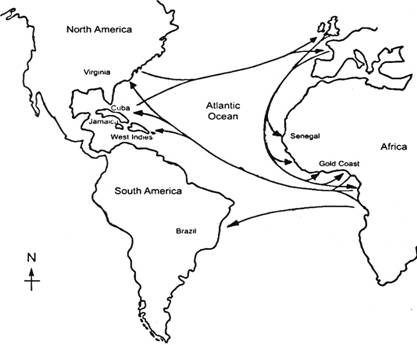
The ships left England for West Africa loaded with foreign goods such as cloth, guns and gin. In West Africa, these goods were exchanged for slaves.
The ships left West Africa for America carrying slaves.
In America slaves were exchanged for raw materials such as sugar and cotton. Thereafter, the ships returned to England carrying raw materials.
Thus completing the triangle.
THE EFFECTS OF SLAVE TRADE IN WEST AFRICA
- Villages were destroyed
- People were carried away and some were killed
- Guns and gunpowder were introduced in Africa
- Some African chieftainships were destroyed
- Many areas in Africa became depopulated
- Many slaves died on their way to America due to ill-treatment
- Africans lost their Identity in the foreign land and were treated as an inferior race.
THE ABOLITION OF THE SLAVE TRADE
In Britain many Christians felt that the slave trade was evil.
Consequently, a movement against slave trade started in England in the 18th century.
People like John Wesley, Thomas Clarkson, William Wilberforce and Granville Sharpe spoke strongly against the slave trade at public meetings, in parliament and in churches.
These people were called abolitionists because they forced government to stop slave trade.
Their influence led to the abolition of the slave trade in Europe, Africa and America.
For example:
- Britain passed a law forbidding slave trade throughout the British Empire in 1807
- Slavery was declared illegal in Britain in 1833
- France, Spain and Portugal passed laws abolishing slavery in their colonies between 1848 and 1888.
- Abraham Lincoln, the president of United States of America, declared all slaves free in his country in 1863
- The slave trade ended completely in United States of America in 1865
- The abolition of slavery in America marked the end of the slave trade in West Africa.
UNIT 4 THE PARTITION OF AFRICA
Africa did not have countries as we know them today. It was made up of kingdoms and empires.
In the late 19th century and early 20th century, Africa was partitioned (divided) by the European nations.
The partition was not peaceful as Europeans scrambled for land.
That is why the ‘Partition of Africa’ is sometimes referred to as the ‘Scramble for Africa’.
CAUSES OF PARTITION OF AFRICA
Need for raw material for the industries
Need for new markets for manufactured goods
To spread Christianity
Improvement in medical knowledge
Prestige
Exploration of Africa
REGULATIONS FOR THE PARTITION OF AFRICA
- A country had to occupy and develop the claimed land. If not developed, the claimed land could be lost to other countries.
- Quarrelling countries over areas had to settle disputes by agreeing on the matter themselves.
- All international trading centres were set free for all traders from different countries.
- Countries had to end slavery and slave trade in their colonies.
The following countries partitioned Africa:
- Germany
South West Africa (Namibia), Togoland (Togo) Cameroon and Germany East Africa (Tanzania)
- France
Morocco, Algeria , Mauritius, French West Africa (Senegal), Mauritania, Mali, Niger, Upper Volta (Burkina Faso), Guinea, Ivory Coast, Benin, Chad, Gabon, Tunisia, Madagascar, French Somaliland and Djibouti.
- Portugal
Angola, Mozambique, Portuguese Guinea (Guinea Bissau).
- Italy
Somaliland and Libya
- Belgium
Belgium Congo (Democratic Republic of Congo)
- Britain
Southern Rhodesia (Zimbabwe), Northern Rhodesia (Zambia), Nyasaland (Malawi), South Africa, Bechuanaland (Botswana), Swaziland, Uganda, Kenya, Nigeria, Sierra Leone, Basutoland(Lesotho), British Somaliland, Gold Coast(Ghana)
- Spain
Rio de Oro (Western Sahara)
Ethiopia and Liberia were independent, therefore, no country colonised them.
THE EFFECTS OF PARTITION OF AFRICA
- Forced labours was imposed in certain areas where Africans were treated like slaves
- In some territories, Africans lost fertile land to the European plantations
- Colonisation sped up the spread of Christianity.
UNIT 5 GENDER EQUALITY IN SOCIETY
Roles and responsibilities of men and women in societies differ from culture to culture. This is because each society has changed ways of doing things.
SEX
This refers to biologically determined differences between males and females.
This differences are:
- Universal
- Obvious
- Few and generally permanent and they cannot be changed Sex is characterised by certain features for males and females.
Some of these features are: boys or men have the ability to impregnate, while girls and women can breastfeed babies.
SEX ROLES
These are biologically determined roles based on the sex.
For example:
- Males impregnate
- Females bear children
- Females breastfeed children
GENDER
Gender refers to the culturally defined aspects of being male and female.
They could be relationships, status and privileges assigned to women, men, boys and girls in a given culture or location.
It is learned through the process of socialisation. Gender is dynamic and varies from culture and culture.
GENDER ROLES
These are activities and tasks performed by males or females as a result of socio-cultural expectations. For example, in Chikwawa it is the role of a man to cut grass for thatching huts, while in the central region this is done by women.
Gender roles change. For instance, in Malawi in the past, only males were employed as soldiers in the Army, but now there are female soldiers in the Malawi Defence Force.
GENDER EQUITY
It means being fair, socially just impartial through fair distribution of benefits and resources.
GENDER EQUALITY
It means having the same status, rights and responsibilities for women and men.
It is based on the Idea that no individual should be less privileged in opportunities or human rights.
This involves the identification and removal of underlying causes of discrimination to give everyone a chance.
GENDER INEQUALITY
This refers to the unequal distribution of roles, responsibilities and opportunities between males and females in society.
GENDER STEREOTYPE
This refers to the beliefs, attitudes and perceptions of males and females which are generally accepted as true.
IMPACT OF GENDER INEQUALITY ON SCHOOL AND SOCIETY
- Males and females may not develop skills in dealing with situations and be able to compete.
- Not all males and females may contribute effectively to development
- Boys and girls may not be motivated to go to school
- Boys and girls may repeat classes more often due to poor performance
- Boys and girls may not have confidence in themselves
- Boys and girls may not depend on themselves and have career ambitions that are focused
- Males and females may not gain knowledge and skills to make rational decisions
FACTORS THAT PROMOTE GENDER BALANCE
- Teachers ensuring equal treatment to both girls and boys.
- Equal encouragement to both boys and girls to work hard.
- Teacher using methods which are gender sensitive
- Giving equal leadership roles to both boys and girls
- Equal support in academic work to both boys and girls
- Teacher creating an environment that is gender friendly
- Giving leadership positions equally to both men and women in religious institutions
- Featuring both males and females positively in newspapers, films and television
- Sensitising people on gender.
- Parents assigning chores equally to boys and girls
THE EFFECTS OF GENDER STEREOTYPING ON DEVELOPMENT
- Discrimination occurs at work place
- Knowledgeable people may not be given the right jobs
- Jobs may not be done thoroughly due to lack of expertise.
- A lot of resources may be under-utilised or wasted
- It becomes difficult for the people to share ideas.
- It reduces initiatives, creativity and innovations.
- It demotivates high performers.
UNIT 6 CULTURE
Culture is a way of life of a given group of people. Culture varies with tribes.
Culture assists people to interact and compete with one another.
CROSS-CULTURAL EXPRESSIONS IN DIFFERENT MEDIUMS
- Political organisation
- Language
- Initiation ceremonies
- Marriage system
- Traditional songs and dances
- Arts and craft
- Folklores
FORCES THAT INFLUENCE CULTURAL CHANGE
- Religion
- Travel
- Intermarriages
- Trade
- Colonization
These are certain organisations which promote the preservation of culture.
Organisation |
How culture is promoted and preserved |
Museum |
Keeping artefacts which are used or explained to young |
Health centres |
Promotion of positive cultural practises e.g. family planning |
School |
Some traditional topics are included in the school curricular |
Family |
Informal education for family members on culture |
Political |
Use of traditional dances during rallies |
Religious |
Giving guidance and counselling on moral values |
UNIT 7 GREEK CIVILISATION
GREEK CIVILISATION
The Greek Civilisation started along the Aegean and Mediterranean Seas in Greece. Greece is a mountainous country with swift rivers.
The civilisation started around 5BC.
The Greeks lived in City States.
The most famous city states were Athens and Sparta.
The other cities were Thebes, Syracuse, Miletus and Corinth.
FACTOR THAT INFLUENCED THE GROWTH OF GRACE CIVILISATION
- Trade – Athens was a trading city state.
- Security – Sparta was a military city state
- Language – All the city states spoke the same language.
- Religion – Greeks shared a common religion.
- Games – Greeks met every four years for competition in various games near Mount Olympus.
- Love of arts – They had love for arts.
- Willingness to learn – Greeks were very open to new ideas and were ready to learn.
REASONS FOR THE DECLINE OF THE GREEK CIVILISATION
- The city states began to work independently and this weakened their unity
- The war between Sparta and Athens
- Foreign invasion by Macedonians and Persians
- Mass production of sculptures led to poor quality of products
CONTRIBUTIONS OF THE GREEK CIVILISATION TO THE MODERN WORLD
- Alphabet – the alphabet we use today was derived from Greeks
- System of government – the democracy we know today evolved from the Greeks
- Science – the Greeks were great scientists and made important discoveries in Astronomy and Mathematics
- Games – the Olympic games which are held every four years originated from the Greeks
- Architecture – most of today’s arts and architecture is a reflection of the Greeks’ creativity
UNIT 8 MINERAL RESOURCES OF THE WORLD
There are many different kinds of mineral resources in the world.
Some of these minerals are coal, petroleum, gold, tin, copper, diamond and aluminium.
MAJOR MINERAL RESOURCES
Mineral |
Uses |
World producers |
Copper |
manufacturing of radios, television sets, refrigerators, cookers, kettles and pans. |
|
|
roofing, bearings, valves, pumps, mountings and ornaments. |
|
Iron |
wires for making magnets. |
|
Gold |
|
|
Diamonds |
|
|
Aluminium |
|
NB: Malawi has bauxite on Lichenya plateau on mount Mulanje but it is not mined due to inadequate electricity and environmental |
Coal |
|
|
|
|
NB: smaller coal fields are Hwange and in Malawi at Mchenga, Ngana, Thangazi in |
Oil or petroleum |
|
|
Uranium |
|
Malawi is mining some at Kayerekera in Karonga but at a small scale |
THE IMPORTANCE OF MINERALS
- They are a source of foreign exchange if exported
- They are a source of employment if exploited
- They provide raw materials to industries
SUSTAINABLE WAYS OF USING MINERALS AND THEIR PRODUCTS
- Recycling
- Re-using mineral products e.g. broken car parts
- Controlling extraction
- Using alternative sources of energy e.g. diesel from maize, ethanol from sugarcane, biogas from wastes and solar energy
UNIT 9 ROMAN CIVILISATION
Rome was founded in 753BC by Romulus hence the name Rome was named him. The roman civilisation grew along the west coast of the Italian Peninsula.
It is located in present day peninsula of Italy.
This peninsula extended into the Mediterranean Sea.
FACTORS THAT INFLUENCED THE GROWTH OF THE ROMAN CIVILISATION
- Trade
- Strong government
- Conquest through wars
- Geographical position
FACTORS THAT LED TO THE DECLINE OF THE ROMAN EMPIRE
- The vastness of the Roman Empire made it difficult to defend and control it.
- Division of Rome into the Western and the Eastern Empire made it difficult to protect the city and other parts of the empire.
- Decline in trade
- Rampant corruption in authority
- Invasions by a number of European tribes such as the Huns, the Vandals, the Ostrogoths, Visigoths and the Franks
THE CONTRIBUTIONS OF THE ROMAN CIVILISATION TO THE MODERN WORLD
- Buildings
- Roads and bridges
- Engineering
- Government
- Arts
- Law
UNIT 10 HUMAN RIGHTS
TYPES OF HUMAN RIGHTS
Human rights are classified into three types.
These are:
- civil and political rights
- socio-economic and cultural rights
- environmental and development rights
Civil and political rights
These are called liberty oriented rights and they enable one to:
- think and have access to information
- act and choose what to do
- join in political life of their society
These rights include:
- Right to life
- Right not to be tortured
- Right to liberty and security of a person
- Right to privacy
- Right to marry and found a family
- Right to a nationality and change of one’s nationality
- Freedom of expression
- Right to assembly and association
Socio-economic and cultural rights
These are security oriented rights.
These rights enable an individual to participate in the social, economic and cultural activities of a community.
They concern how people live and work together to access basic needs such as food, shelter, health care and cultural practices.
Example of social rights:
- Right to privacy
- Right to education
- Right to health care
Example of economic rights:
- Right to choose one’s work including self employment
- Right to form and join union and business association
Environmental and developmental rights
These rights entitle people to live in a self and health environment. Environmental rights include the following:
- Right to clean water
- Right to access water.
Developmental rights include:
- Right to political, economic and cultural advancement.
RESPONSIBILITIES WHEN EXERCISING ONE’S RIGHT
- Respecting oneself
- Respecting elders
- Obeying laws
- Participating in development activities
- Respecting government’s and other people’s property
- Taking care of the environment for the present and future use
THE RIGHTS OF SPECIAL GROUPS OF PEOPLE
- The rights of children
- Right of equal treatment before the law
- Right to be given a name, family name and to a nationality
- Right to know and be raised by their parents or guardians
- Right to education
- Right to be protected from economic exploitation or any punishment that may interfere with their physical or mental development
- The rights of women
- Right to full and equal protection by the law
- Right to be employed and get promoted
- Right to acquire and maintain custody of children
- Right to be treated with respect and dignity
- Right not be discriminated against because of gender or marital status
- Right to fair distribution of property acquired jointly with a husband
- The rights of the girl child
- Right to equal access to quality education
- Right to equality
- Right to be protected from all forms of abuse and discrimination
THE FOLLOWING ARE SOME ABUSES EXPERIENCED BY A GIRL CHILD
- Used as a domestic worker with little or no pay
- Forced into early marriages
- Victim of child trafficking
- Sexual abuse
- The rights of detainees
- To be informed of the reason for detection
- To be detained under humane conditions
- To have adequate nutritional and medical treatment
- To confidentially consult a legal practitioner
- To be visited by spouses, relatives, counsellors
- To be released if such detention is unlawful
- The rights of people with disabilities
- Right to employment
- Right to education and training
- Right to special care
- Right to health
- Right to have a family
- Right to association
- The rights of workers or employees
- Right to good salary
- Right to good food
- Right to good working conditions
- Right to good housing
- Right to transport to and from work
THE IMPORTANCE OF OBSERVING HUMAN RIGHTS
Human rights and freedoms can only be important if every person understands that each right and freedom goes with a responsibility.
Freedom does not mean the right to do whatever we want whether good or bad
The following are some of the responsibilities:
- Respecting of oneself
- Respecting elders
- Obeying laws
- Participating in development activities
- Respecting government’s and other peoples’ property
- Taking care of the environment for sustainability of natural resources
- Handling of waste disposal to ensure a clean and safe environment
BENEFITS THAT PEOPLE HAVE WHEN THEY OBSERVE HUMAN RIGHTS
- Every citizen lives peacefully
- People are able co-exit
- The community develops socially and economically
- It guarantees the continuity of respect for human dignity and equality of all people
- provides basis for justice and fairness
- It promotes democracy in a society
HUMAN RIGHTS ABUSES
- Rape
- Violence against women and children
- Religious intolerance
- Child abuse
- Detention without trial
- Denying one to attend school
- Turn music to full volume in class, homes or living quarters
- Dismissing workers without genuine reasons
- Denying education, health and right to association for people with disabilities
EFFECTS OF HUMAN RIGHTS ABUSE
- Rise in criminal activities
- An increase in conflicts in societies
- Women’s and children’s lives are threatened
- Development in the country is negatively affected
- Democracy is threatened
UNIT 11 TRADE AND HIRE PURCHASE
TRADE
The meaning of the term “trade”
Trade is buying and selling of goods and services.
In the past trade was through exchange of goods for goods. This was known as barter.
Modern trade is through the exchange of goods and services using money.
TYPES OF TRADE
There are two types of trade namely:
- Internal trade
- External trade.
Internal trade
This is the exchange of goods and services for money or other goods and services within a country. For example, ADMARC buys agricultural products from farmers and sells the products to industries. The manufacturing industries sell their products to people in Malawi.
This is internal trade or domestic trade.
External trade
This type of trade takes place between and among countries. It is also known as international or foreign trade.
Trade between two countries is known as bilateral trade. Trade among countries is known as multilateral trade.
IMPORTANCE OF TRADE
- It allows a steady supply of goods and services at all levels.
- It helps a country to improve its national income through customs duty and exports
- It creates employment
- It promotes relations between and among countries
FACTORS THAT AFFECT TRADE
- Resources
- Levels of income
- Transport network
- Development of tertiary industry
- Political climate
- Relationship with other countries
- Membership to international bodies
Resources
The nature of trade will depend on the type of resources available in a particular area.
For example, an area that specialises in the production of a particular commodity will trade with another area that does not have that product.
Levels of income
Trade exists when people have the buying power.
People may have the demand for a product but may not access the product if they do not have money.
For instance, Malawi may need certain resources such as petroleum, but it cannot access the product if it has low levels of income.
Transport network
Trade will be efficient if a country has good transport network.
This will help to facilitate the movement of goods to places where they are required.
Development of tertiary industry
Banking insurance and advertising services help to promote trade by providing credit services to manufacturing industries and other business enterprises.
Political climate
Trade will flourish in a country where the political climate is stable.
For example, trade within a country which is war-torn as well as with other countries becomes difficult.
Relationship with other countries
Trade will exist in a country where there is good bilateral relationships.
Membership to international bodies
Trade may be influenced by membership to international bodies such as SADC and COMESA where one of the objectives is to create improved trade between and among states.
Malawi is a member of both regional bodies.
HIRE PURCHASE
Meaning of the term “hire purchase”
Hire purchase is system of buying items by means of instalments.
It is a common way of paying for major items such as car, Furniture and computers
Hire purchase happens where a buyer cannot afford to pay the price asked for an item in a lump sum, but can afford to pay a deposit and the balance by instalments.
THE ADVANTAGES OF HIRE PURCHASE
- It allows consumers to spread the cost of expensive items over an extended period of time
- It allows the buyer to enjoy possession of goods before full payment.
- People are able to acquire a variety of assets such as vehicles, machinery, electronic equipment and many others which they could not have afforded by cash.
- The seller is able to stay in business by selling more expensive items than if people were to pay cash
THE DISADVANTAGES OF HIRE PURCHASE.
- The buyer gets things at higher price because of the interest
- The buyer becomes the rightful owner of items after a long time
- The buyer continues to pay for items even when it has been destroyed or stolen
- The buyer may run into debts due to poor planning
- The seller fails to get a full amount of money for an item immediately
- The seller may face many problems from untrustworthy buyers
UNIT 12 INSURANCE
Life has some misfortunes such as loss of property or life due to unforeseen circumstances.
In order to protect themselves from such risks, individuals or institutions take insurance policies.
INSURANCE
Insurance is a system where an individual or institution gets safeguarded against risks. The person or institution pays monthly premiums to an insurance company.
This allows the individual or institution to be compensated in the event of the insured risk.
TYPES OF INSURANCE POLICIES
- Life insurance policy
- Life endowment insurance policy
- Medical insurance policy
- Property insurance policy
Life insurance policy
This policy is a contract between an owner and a life insurance company.
The policy promises the payment of a stated amount of money in the event of death of the insured person.
Endowment life insurance policy
This is a means of saving money.
Policy holders may use endowment policies to finance education of their children.
Medical insurance policy
A person pays an amount of money to cover the cost of medical treatment
Property insurance policy
Property insurance policy provides direct compensation to a policy holder whose possessions are damaged, destroyed or lost as a result of risks specified in the policy.
Examples of property can be vehicles, shops and household things.
THE IMPORTANCE OF INSURANCE
- It offers security against the effects of unforeseen risks (it helps people to quickly recover from damage and losses)
- It is a form of financial investment.
- It reduces uncertainty over the distribution of deceased property since the policy holder already specifies the distribution whilst alive
Insurance companies sell their policies directly or through a broker. A broker is a person who buys and sells goods or assets for others.
An agent is a company which is in business with companies, institutions or individuals who may require insurance advice.
Premium is an amount paid for a contract of insurance.
UNIT 13 BUDGETING
A budget is a plan of expenditure over a period of time.
For instance, one can make a budget for a week, a month or a year.
TYPES OF BUDGET
- Personal or family budget
- Government or state budget
- Company or industrial budget
- Institutional budget
Personal or family budget
This type of budget is made by an individual or all family members.
Government or state budget
This type of budget is made by government or state.
Company or industrial budget
This budget is made by companies or industries
Institutional budget
This budget is made by institutions
FACTORS TO BE CONSIDERED WHEN BUDGETING
- Time
- Income
- Population
- Prevailing costs
IMPORTANCE OF BUDGETING
- It gives a clear picture of how much money would be spent
- It allows an individual not to overspend the financial resources
- It gives a chance to an individual to look for additional financial resources from other people or lending institutions
- Money is used on planned items only
- If facilitates social and economic development of a country.
UNIT 14 THE MALAWI REVENUE AUTHORITY
Every country has an institution that is responsible for managing government revenue.
In Malawi the institution that is responsible for managing government revenue is called Malawi Revenue Authority (MRA).
Malawi Revenue Authority is responsible for assessment, collection and accounting for tax revenue.
THE ROLE OF THE MALAWI REVENUE AUTHORITY
- Providing improved tax payer services
- Advising government on matters of tax policy
HOW THE GOVERNMENT RAISED ITS REVENUE
- Through income tax
- Through surtax
- Through customs duty
- Through excise duty
- Through loans
- Through donations
- Through tourism
Income tax
This type of tax is collected directly on all forms of incomes such as salaries, wages, rents, business profits and interests
Surtax
This type of tax is imposed on goods already taxed
Customs duty
This tax is collected from imported goods.
Excise duty
This tax is imposed on goods manufactured within the country considered as luxuries such as cigarettes and liquor.
Loans
Government may also borrow money from within or outside the country to assist it in carrying out its planned activities.
Donations
The government may raise its revenue through receiving money from foreign countries. The country may use the donation for developmental activities, relief services and payments for debts.
Tourism
The government has beautiful centres or places in the country that attract tourism. These centres include national parks, game reserves, Lake Malawi, hot springs and Mulanje Mountain.
When tourists visit these places, they bring in foreign currency that support the government budget.
USES OF TAXES COLLECTED BY THE MALAWI REVENUE AUTHORITY
- Providing improved health services
- Providing improved national security
CHALLENGES FACED BY THE MALAWI REVENUE AUTHORITY
- tax evasion smuggling
- tax evasion default
SOLUTIONS TO THE CHALLENGES FACED BY THE MALAWI REVENUE AUTHORITY
- carrying out advocacy campaigns
- making tax affordable
Carrying out advocacy campaigns
Advocacy means to speak publicly in support of an idea or intervention. In the case of MRA, if advocacy campaigns on the importance of paying taxes are conducted intensively, more people would understand the importance of paying taxes.
UNIT 15 THE CONSTITUTION OF THE REPUBLIC OF MALAWI
The term constitution refers to the supreme law of the land.
It contains the highest laws of the country which give powers to institutions as well as individuals to exercise authority.
For example, the constitution of the Republic of Malawi contains:
- a list of very important guidelines which the people felt were necessary for the nation
- a list of the national aims and goals
- the peoples’ rights or entitlements as citizens of the country
- information about how institutions should operate
- information about how misunderstandings of the constitutions can be addressed
COMMON FEATURES TO ALL TYPES OF CONSTITUTIONS
- highest law – it is supreme to all other laws in the country
- authority – it gives power to government institutions and people, and no one can operate outside it
- legal protection – the constitution is protected by the courts
- Rights – it contains a set of entitlements which every individual must have.
- Establishment of government structures – it determines the establishment of government institutions.
- It defines citizenship.
FUNCTIONS OF THE CONSTITUTION
- The constitution outlines government’s commitment to promote human rights
- The constitution describes the composition, personnel and codes of conduct of parliament
- The constitution establishes security institutions such as the police and the army
- The constitution serves as a guide for law makes
- The constitution assists various organs of the state to run in a legal and orderly manner
- The constitution directs the citizens to authorise and control the exercise of all legal, political authority in the country
- The constitution provides remedy to those who are affected if powers are not exercised properly
- The constitution introduces a protected system of checks and balances to ensure that no branch of the government will overshadow the other.
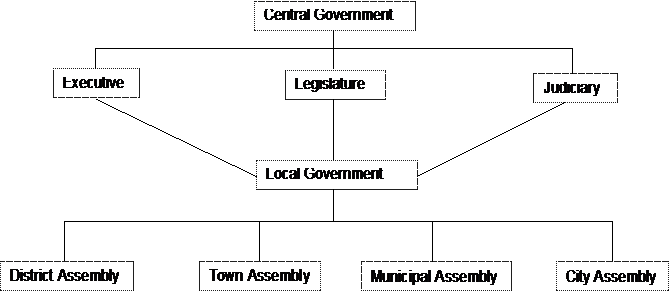
THE STRUCTURE OF THE GOVERNMENT OF MALAWI
- The central Government
This is the level that looks into the overall running of government
It comprises the following branches:
- Executive
- Legislature
- Judiciary
Executive
This is made up of the president and cabinet ministers.
Its responsibility is to initiate and facilitate the implementation of development plans for the nation.
Legislature
This comprises members of parliament whose main function is to make laws
Judiciary
This is made up of courts and comprises the judges and magistrates whose function is to interpret laws and judge cases.
- The local government
This is level that looks into the running of districts, towns, municipalities and cities. The four areas are run through local assemblies.
The following is the composition of the local assemblies (members):
- Ward councillors
- Traditional Authorities
- Members of Parliament
- Five appointed members
- Elected chairperson
Ward councillors are elected to represent their areas called wards. These can vote during assembly meeting.
Traditional authorities (TAs) and sub TAs. These are chiefs of high positions in the area and are not allowed to vote in assembly meetings.
Members of Parliament (MPs). These are elected to represent people in a constituency and are not allowed to vote
Five members are appointed to represent the interests of special groups of people.
Each assembly has an elected chairperson from among councillors. However, the chairperson for a city and municipality is called a mayor.
THE NATIONAL SYMBOLS
- The national flag
- The national anthem
- The national coat of arms
- The public seal
- The national flag
The national flag has three colours; black, red and green.
Black symbolises the colour of people of Malawi.
Red represents the blood which was shed by those who died during the struggle for freedom and independence.
Green represents the vegetation of Malawi.
IMPORTANCE OF NATIONAL FLAG
- It signifies self-rule of the state of Malawi.
- It helps to identify institutions that belong to government. For example, government schools, hospitals and offices.
- It demonstrates citizens’ love and patriotism to the nation
- The national anthem
This is a song in praise of the Lord for the abundant resources provided to the nation and to ask the Almighty God to continue blessing the nation with all its necessities.
The song is sung as a prayer in important national functions and people are supposed to stand up when singing it.
- The national coat of arms of Malawi
This symbol is used on a number of government owned property such as the Constitution of Malawi, passports, driving licences, government documents, police and army uniforms.
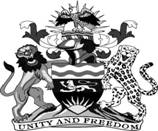
The national coat of arms of Malawi
- The public seal
This is an official stamp which is used on very important government documents such as passports, to confirm that it has been approved by the government.
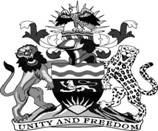
The public seal
UNIT 16 NYASALAND AS A BRITISH COLONY
THE COLONIAL PERIOD OF NYASALAND
One of the results of the partition of Africa was the establishment of colonies by various European nations.
A colony is a country under another country. Malawi was a British colony.
FACTORS THAT LED NYASALAND TO BECOME A PROTECTORATE
- British missionaries in Nyasaland
- The scramble for Africa by European countries
British missionaries like the UMCA, Livingstonia and Blantyre, who had already established themselves around the Lake Nyasa (Lake Malawi) region did not want to be under the Portuguese. The missionaries, therefore, asked the British government to take control of the area and end the slave trade. The British government agreed to the missionaries’ demand and declared a protectorate over Nyasaland on 14th May 1891. Sir Harry Hamilton Johnston was appointed commissioner and Consul General.
The scramble for Africa by European countries led to the partition of Africa. Britain, therefore, was interested to take over Nyasaland as its territory.
HOW NYASALAND WAS ADMINISTERED AS A COLONY: 1891 – 1964
Nyasaland was a British protectorate from 1891 – 1964.
From 1953 – 1963 Nyasaland was part of the federation of Rhodesia and Nyasaland.
It was administered in the following ways:
- Zomba was established as the administrative capital of Nyasaland with Sir Harry Johnston as the first commissioner and Consul General.
WHAT JOHNSTON’S ADMINISTRATION DID FROM 1891 – 1894
- It set up four districts over the new protectorate for effective rule.
These were: North Nyasa (present Karonga and Chitipa), West Nyasa (Rumphi, Mzimba and Nkhatabay), South Nyasa (Central Region including Mangochi) and Lower Shire (the Southern Region excluding Mangochi)
- It established defence posts at Fort Hill (Chitipa), Fort Manning (Mchinji), Fort Johnston (Mangochi) and Fort Maguire (Makanjira) in Mangochi.
This was to prevent occupation of Nyasaland by the Germans in Tanganyika, the British South Africa Company in Zambia and the Portuguese in Mozambique.
- It established Port Herald (Nsanje) as a major port for steamers sailing from Chinde on the Indian Ocean through the Zambezi and Shire Rivers.
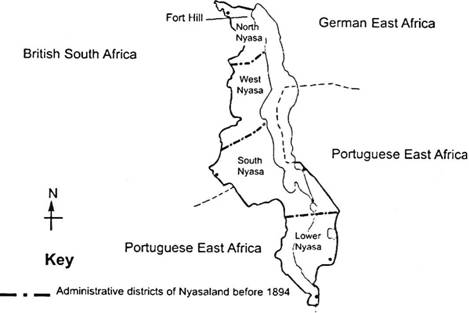
Map of Nyasaland showing district boundaries before 1894
From 1894 – 1963, the administration was improved as follows:
- Sir Alfred Sharpe was appointed by the British Government as the first Governor of Nyasaland in 1907.
- Nyasaland was later split into smaller administrative districts called BOMAs. This meant British Overseas Management Administration.
Each BOMA was headed by a District Commissioner (DC).
The BOMA had a DCs office, a police station, a prison, a public works department (PWD) for construction and maintenance of roads and buildings, an education office, an agriculture office, a hospital and other departments.
- The districts were grouped into three provinces; the North Province, the Central Province and the Southern Province, with Mzuzu, Lilongwe, and Blantyre as provincial headquarters respectively.
Each province was headed by a Provincial Commissioner (PC).
The structure of government was as follows:

 :
:
- Tax to be paid by every man was introduced. The money was used to build roads, schools, health facilities and other projects
- A Legislative Council (Legico) was established in Zomba. The Legico, similar to parliament, was set up to make laws of the country.
- Traditional chiefs were recognised as part of the administration. Their roles were to collect taxes and settle local disputes.
ADVANTAGES OF NYASALAND AS A BRITISH COLONY
- The slave trade was abolished because Yao and Arab slave traders were defeated.
- Trade in goods replaced the slave trade.
- Western type of education was introduced by the British missionaries.
- Cash crops such as tea, coffee and tobacco were established in the Shire Highlands.
DISADVANTAGES OF NYASALAND AS A BRITISH COLONY
- Some of the African customs and practices were lost because they were condemned by missionaries.
- Some European settlers took land from Africans for their estates especially in the Shire Highlands
- Those who stayed on European land had to work for them as tenants without pay. This system became known as Thangata.
- Africans could not mix freely with whites.
- Tax was introduced. Those who failed to pay tax had to work as labourers to get the money for the tax.
- Tribes were divided because of creation of new countries.
UNIT 17 THE INDEPENDENT MALAWI
Independence means governing or ruling oneself and being free from another country’s rule. Nyasaland, therefore, fought for independence to free herself from British rule.
THE FIGHT FOR INDEPENDENCE OF MALAWI
The following events contributed to Malawi’s achievements of self- government, followed by independence and republican status:
- The formation of Nyasaland African Congress (NAC)
- Growth of the Nyasaland African Congress 1949 – 1960 under Dr Hastings Kamuzu Banda’s leadership.
- Formation of the Malawi Congress Party (MCP).
FORMATION OF THE NYASALAND AFRICAN CONGRESS (NAC)
In 1943, coloured people in Nyasaland began asking for separate schools, from those of the Africans. They hated being classified as Africans or Natives.
Africans, therefore, decided to form the Nyasaland African Congress (NAC) in 1944. Levi Mumba was the first chairman.
Other key people were James Sangala, Charles Mlanga, Isa Lawrence, Ellerton Mposa and Lewis Bandawe.
The objectives of the Congress were:
- To have African representation in the Legislative Council (Legico), now called Parliament.
- To ask government to provide better education for Africans rather than missionary education which was too religious. They also asked for secondary school education.
- To ask government to take over missionary hospitals which asked poor Africans to pay for the costs.
- To ask government to assist Malawian soldiers returning from the World War II and families of those who died in the war.
- To fight against discrimination and insults from Europeans.
However, the Congress became very weak because of:
- Weak leadership
- Tribalism
- Misuse of Congress money by the treasurer and chairperson like H. Tung’ande and Charles Matinga
- The death of powerful people like Levi Mumba and Issa Lawrence in Congress
GROWTH OF THE NYASALAND AFRICAN CONGRESS (1949 – 1960) UNDER DR H KAMUZU BANDA’S LEADERSHIP
A weak Congress soon became strong because of the following factors:
- In 1953, the British Government imposed the Federation of Rhodesia and Nyasaland. Salisbury (Now Harare) was made the federal capital. Most development took place in southern Rhodesia (Zimbabwe). Nyasas, therefore, became more united to fight for independence.
- Congress was now led by young and highly educated people like Kanyama Chiume, Henry Masauko Chipembere, Orton Chingoli Chirwa and Dunduzu Chisiza.
- Nyasaland would not get self-government White insults and discrimination which were very common in Rhodesia (Zimbabwe) and South Africa would be more felt in Nyasaland.
They did not want the federation because they were afraid that:
They, therefore, began demanding for a vote for Africans’ self-government.
They decided to call for Dr Hastings Kamuzu Banda, a medical doctor, to lead them.
Dr Banda had already been supporting congress by providing funds, advice and encouragement.
- In 1957, Ghana became the first independent black African state with Kwame Nkrumah as a first prime minister. This encouraged educated people of Nyasaland and Dr Banda to fight for independence.
- The colonial government imposed agriculture rules in which Africans were to dig bunds to control soil erosion. The aim was to produce more food which was needed in Britain after the end of Second World War. Africans were forced to do it. Failure to do it meant paying fines or imprisonment. Congress was looked at as an answer to the issue.
- Dr Banda returned to Malawi on 6th July 1958 after staying in America, Britain and Ghana for over 30 years. He took over leadership of the Congress and it became much organised.
The following are some of the activities that Dr Banda did:
- He toured the country and appealed to the people to break what he called the ‘stupid federation’ and obtain self-government rule.
- He attacked agricultural laws which were very unpopular among villagers and traditional leaders.
- He addressed public rallies with shouts of ‘freedom’, ‘ufulu’, ‘mtendere’.
- He raised money for the party by issuing membership cards.
- He organised a very powerful Women’s League and Youth League.
- He raised money for the party by issuing membership cards.
Because of very active Nyasaland African Congress under Dr Banda, disturbances and riots started all over Nyasaland.
- The governor, Sir Robert Armitage, declared a ‘state of emergency’ in March 1959. Under this state of emergency, Congress was banned. Public meetings were not allowed and the police were given powers to arrest and detain people without trial.
- Dr H Banda was detained in Gweru, Zimbabwe, and many political leaders were also arrested and put in detention in Southern Rhodesia and at Kanjedza in Limbe.
- Some Africans were also killed, especially at Nkhatabay. That is why 3rd March is observed as a Martyrs’ Day public holiday to remember those who died for freedom and independence.
FORMATION OF THE MALAWI CONGRESS PARTY (MCP)
While Dr Banda was in detention, Orton Chirwa founded the Malawi Congress Party, (MCP) to replace the banned Nyasaland African Congress.
Orton Chirwa handed over the leadership of the MCP to Dr Banda when he was released on 1st April, 1960.
The MCP was founded on the principles of the four corner stones of Unity, Obedience, Loyalty and Discipline.
The MCP intensified its campaign for independence.
- On 5th August 1961, the first multi-party elections were held in Nyasaland. Four political parties took part in the elections. The MCP, Christian Liberation Party, United Federal Party and Christian Democratic Party. The MCP won all parliamentary seats. Nyasaland became a self-governing state.
- 28 elected members entered the Legislative Council with high African representation for the first time.
- The governor, appointed by the Queen, was still the head of the new government.
- The Federation of Rhodesia and Nyasaland came to an end in 1963.
INDEPENDENCE 6 JULY 1964
Malawi became an independent state called Malawi on 6th July 1964.
- Dr Banda became the first Prime Minister. He came up with a cabinet composed of Henry Chipembere, Orton Chirwa, Kanyama Chiume, Harry Bwanausi, Willie Chokani and Rose Chibambo. He formed government.
- Sir Glyn Jones became Governor General as formal head of state. He represented the Queen of Britain.
- A constitution was made. It had a ‘Bill of rights’ to protect fundamental rights and freedoms of individuals. Public Services Commission, Judicial Service Commission and Police Service Commission were established.
- Other parties were allowed to operate.
REPUBLIC 6 JULY 1966
- Malawi became a republic on 6th July, 1966.
- Offices of Governor General and Prime Minister were abolished; the head of state and head of government became known as president.
- Dr Banda became the first President of Malawi.
- Malawi became a one party state under the MCP.
- Human rights were removed from constitution
- The authority of chiefs was recognised.
SOCIO-ECONOMIC DEVELOPMENT UNDER THE MCP 1964 – 1994
The MCP was in power from 1964 – 1994.
During the MCP, under leadership of Dr Banda Malawi developed a lot:
- Education improved considerably with opening of primary and secondary schools and teacher training colleges. The University of Malawi opened in 1965.
- Health services were improved with the building of hospitals, dispensaries and a College of Medicine
- Agriculture development took place to the extent that later on Malawi became self-sufficient in food. Agricultural development programmes and schemes were started for production of tobacco, maize, rice, beans and groundnuts. Malawi Young Pioneers training bases were opened where young men and women were trained in farming and other skills.
- Transport and communications were developed with the construction of tarred roads, railway lines and an international airport.
- Industrial development took place in Blantyre, Lilongwe, Liwonde, Nchalo, Dwangwa; hydro- electric power stations were opened up at Nkula and Tedzani water falls on the River Shire.
- Cultural preservation was enhanced by encouraging traditional dances, usually done in traditional dress or party colours.
- The capital of Malawi was moved from Zomba to Lilongwe in 1975 with the construction of a beautiful capital city.
CHANGE FROM ONE-PARTY SYSTEM OF GOVERNMENT TO MULTIPARTY SYSTEM
Malawi under the one party system of government
In spite of many socio-economic developments, the MCP became unpopular for the following reasons:
- The president, Dr Banda, became a dictator and was made life president in 1971. Nobody questioned or disobeyed him.
- Human rights were not observed such as freedom of expression and freedom of speech.
- Anyone opposing government was detained without trial, killed or disappeared without a trace.
- The Malawi Young Pioneers and the Youth League forced people to buy MCP cards, attend MCP meetings and give money or chickens during MCP meetings.
- A number of Malawians ran away to Tanzania and Zambia in fear of government persecution. They were called rebels and many of them died there. Yatuta Chisiza, Orton Chirwa, Kanyama Chiume, Henry Chipembere, Augustine Bwanausi, Willie Chokani and Rose Chibambo all ran away.
- People were forced to line up along the road to clap hands and sing in praise of Ngwazi.
- Some top senior civil servants and university lecturers were arrested without trail and dismissed from their work.
HOW MALAWI CHANGED FROM ONE PARTY SYSTEM TO MULTIPARTY SYSTEM OF GOVERNMENT
Because of the above experiences, many people turned against the MCP and wanted change.
The following events helped to change Malawi to Malawi to a multiparty system of government:
- In 1992, the Roman Catholic bishops in Malawi issued a pastoral letter to its church members. The pastoral letter was read in all catholic churches. It highlighted the injustices experienced in Malawi under the MCP. That marked the beginning of political change in Malawi.
- In support of the bishops’ sentiments, Thom Chakufwa Chihana who was in Zambia came to Malawi and led a pressure group called Alliance for Democracy (AFORD) to challenge the MCP. He called for multi-party democracy and a free Malawi. He was arrested on arrival. He had a lot of support from within and outside countries and organisations
- The United Democratic Front (UDF) was another pressure group led by Bakili Muluzi which also called for multi-party democracy and observation of human rights.
- A referendum was conducted on 14th June, 1993. Malawians had to vote as to whether they wanted to stick to the one party system of government or re-introduce multiparty system of government.
- It was at this time that pressure groups became political parties.
- In 23rd May 1994, the first presidential and parliamentary multi-party elections were held. The UDF won the elections and Bakili Muluzi became the first president under the re-introduced multiparty system of government. Dr Banda accepted the elections results even before counting of the votes was over. He congratulated Muluzi and wished him well.
- A new constitution was produced in 1995 and the Bill of rights was re-introduced as well as holding of regular and free elections. The judiciary was made more independent, and emphasis was made on observance of the constitution.
THE ADVANTAGES OF MULTIPARTY SYSTEM OF GOVERNMENT
- Opposition parties are able to check on abuse of power by ruling party.
- There is freedom of speech and freedom of expression.
- Citizens are able to join parties of their own choice and people are not forced to belong to and support any party.
- Voters are able to vote out an unpopular party that is in government and vote in another party.
- Other people’s views are heard.
- Human rights are observed.
- More than one party takes part in elections to form a new government.
- Voters are able to choose a candidate of their own choice to represent them in parliament.
- Dictatorship is avoided because of criticism from other parties
- There is transparency and accountability.
THE DISADVANTAGES OF MULTIPARTY SYSTEM OF GOVERNMENT
- The country may split into many groups of people who may quarrel or fight against each other because of different interests and ideologies
- Parties might disagree on important issues debated in parliament. This might slow down development.
- Parties may be based on ethnic or tribal lines which will not be for the interest of the nation.
- It takes time for the different parties represented in parliament to make decisions because of many political arguments.
UNIT 18 THE LIBERATION OF AFRICA
Liberation is a term that is used to describe national struggles that Africans staged to put pressure on colonial governments to grant freedom and independence to the people.
LIBERATION STRATEGIES USED IN AFRICA
- Negotiations
- Passive resistance
- Guerrilla wars
Negotiations
Negotiations are peaceful means of trying to sort out issues.
For example, the African National Congress (ANC) in South Africa and the Kenya National Union (KANU) in Kenya led peaceful campaigns against the whites between 1953 and 1955.
Passive resistance
Passive resistance demanded non-cooperation with the colonial government and involved peaceful demonstrations, strikes and defiance.
For example, passive resistance was used by the African National Congress (ANC) in reaction to apartheid in 1949 and it was led by Albert Luthuli.
The Nyasaland African Congress (NAC) under the leadership of Dr Hastings Banda used passive resistance in 1958 in reaction to the Federation of Rhodesia and Nyasaland.
Guerrilla wars
These were violent strategies that Africans used. They were in form of armed struggles.
The guerrillas operated from hiding places mainly from the bush and fought for freedom and independence.
For example, guerrilla wars were used by:
- Zimbabwe African National Union (ZANU) led by Robert Mugabe and Zimbabwe African People Union (ZAPU) led by Joshua Nkomo in Zimbabwe in the 1970s.
- Mozambique Liberation Front (FRELIMO) under the leadership of Eduardo Mondlane and later Samora Machel in Mozambique between 1962 and 1975.
- Movement for the Liberation of Angola (MPLA) between 1966 and 1975 under the leadership of Agonstino Neto.
The Africans resorted to the use of these guerrilla wars because the whites did not want to give up power to them.
Some of the most brutal wars in Africa were experienced in Portuguese colonies because the Portuguese were the weakest of the colonial powers.
It was the Portuguese, therefore, who were most threatened by African liberation armies.
THE CONTRIBUTIONS OF PROMINENT AFRICAN LEADERS
- MWALIMU JULIUS NYERERE
Julius Nyerere led Tanzanian nationalists in forming the Tanganyika African National Union (TANU)
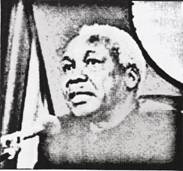
Mwalimu Julius Nyerere
THE ACHIEVEMENTS OF NYERERE
- He led his country to independence in 1961
- He initiated changes and progress in all aspects of the national life
- He set up regional, district and village development committees to ensure that people participate fully in the planning and execution of development programmes
- DR KWAME NKRUMAH
The architect of Ghana’s independence was Dr Kwame Nkrumah.
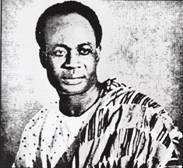
Dr Kwame Nkrumah
THE ACHIEVEMENTS OF DR NKRUMAH
- Led his country to independence in March 1957
- He developed the agriculture industry in the country
- He developed the education, transportation and communication sectors
- DR HASTINGS KAMUZU BANDA
In 1958 Dr Hastings Kamuzu Banda returned from England where he was studying to take the leadership of the Nyasaland African Congress founded in 1944.
The Nyasaland African Congress was banned and its leaders were imprisoned including Banda.
The banned Nyasaland African Congress was quickly reformed as the Malawi Congress party with Dr Banda as its leader.

Dr Hastings Kamuzu Banda
ACHIEVEMENTS OF DR HASTINGS KAMUZU BANDA
- He broke the federation
- He led Malawi to independence in 1964
- He developed the education, health and agriculture sectors
- KENNETH KAUNDA
Kenneth Kaunda, an outspoken critic of federation and the racism of colonial rule since the 1950’s became the president of United National Independence Party (UNIP) on his release from prison in 1960.
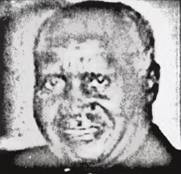
Dr Kenneth Kaunda
ACHIEVEMENTS OF DR KENNETH KAUNDA
- He led Zambia to independence in 1964
- He diversified economic base for Zambia to include agricultural production as well as industrial production and not just copper mining
- He developed the education sector
- He made progress in the field of health services
- He increased the employment of Zambian nationals
- JOMO KENYATTA
Kenya became independent on 12th December 1963 under the prime ministership of Jomo Kenyatta.
One year later, the country became a republic with Kenyatta as president and Oginga Odinga as vice president.
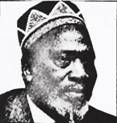
Jomo Kenyatta
ACHIEVEMENTS OF JOMO KENYATTA
- He brought unity and harmony to Kenya
- He developed programmes of education
- He developed the agriculture sector
- He expanded and developed the tourism sector
- NELSON MANDELA
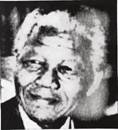 Mandela was born at Umtata in the Transkei in 1918.
Mandela was born at Umtata in the Transkei in 1918.
Nelson Mandela He graduated as a lawyer at Fort Hare University College.
In June 1961, Nelson Mandela formed what was known as Unkhonto we Sizwe (The Spear of the Nation).
Unkhonto we Sizwe’s objective was to disrupt the life of the country by sabotage of Government installation.
In 1963, Nelson Mandela was arrested and sentenced to life imprisonment on Robin Island. He was released from prison in 1990 after spending 27 years in prison.
Nelson Mandela became the first black president of South Africa on 10th May 1994.
THE ACHIEVEMENTS OF NELSON MANDELA
- He became the first black president of South Africa in 1994
- He managed to bring freedom for blacks in South Africa with the end of apartheid
- SAMORA MACHEL
Mozambicans managed to unify their liberation movements in 1962 with the formation of Fente de Liberacao de Mocambique (FRELIMO).
Eduardo Mondlane and his deputy Samora Machel led FRELIMO’s struggle in Mozambique with an official declaration of war in September 1964.
However, Mondlane died in a bomb blast in February 1969.
Samora Machel took up the leadership of the liberation movement and led FRELIMO to victory and Mozambique to independence in 1975.
THE ACHIEVEMENTS OF SAMORA MACHEL
- He led Mozambique to independence
- He led the people in the task of social economic and cultural liberation
- He led the people in the creation of new structures geared to the development needs of the country
- He reorganised agriculture into producer co-operative to avoid economic exploitation of the peasants by any privileged group
- He placed emphasis on education
UNIT 19 WORLD CLIMATE AND NATURAL VEGETATION
MAJOR TYPES OF WORLD CLIMATE
Climates of the world are divided into different types depending on their characteristics.
LOCATION AND CHARACTERISTICS OF EACH TYPE OF CLIMATE
- Equatorial climate or Tropical rainforest
It is found between 00 and 70 north or south of the equator in these areas:
- Amazon basic
- Congo river basin
- East coast of central America
- East coast of Madagascar
- Malaysia and Indonesia
CHARACTERISTICS OF EQUATORIAL CLIMATE/TROPICAL RAINFOREST
- High temperatures of about 260C
- Equal length of day and night
- Has very small differences of temperature 30C to 50C between the hottest and coldest months
- Rainfall is heavy over 1500mm throughout the year
- Humidity is always high
- Tropical monsoon climate
It is found in places where strong seasonal winds called monsoon blow.
These include:
- Coastal areas of Southwest India
- Sri Lanka
- Bangladesh
- Burma
- South East Africa
CHARACTERISTICS OF TROPICAL MONSOON CLIMATE
- Reversal of winds seasonally
- Temperatures vary from 320C in hot season to about 100C in the cool season
- Three seasons are experienced
- Variable rainfall
- Tropical Savannah climate (Tropical Continental climate) It is found between 50C to 150C north or south of the equator.
The areas include:
- East and central Africa
- South America
- Parts of the Deccan plateau in India
- Parts of Australia
CHARACTERISTICS OF TROPICAL SAVANNAH CLIMATE
- Summers are hot around 320C
- Winters are cool around 210C
- Highest temperatures occur just before the rains begin
- Heavy rains occur in summer
- Alternating wet and dry season
- Tropical desert climate (Hot Desert climate)
It lies between 150C north and 300C north and 150C south and 300C south of the equator.
The areas include:
- Coastal Chile and Peru
- Southern Argentina
- Southwest Africa
- North Africa
- Arabia
- Iran
- Pakistan
- Parts of California
- Parts of Mexico
CHARACTERISTICS OF TROPICAL DESERT CLIMATE
- Little or no rainfall
- Temperatures vary from 290C in hot season to 100C in cold season
- Low humidity
- Large differences between day and night temperatures
- Mediterranean climate
It is located between 300 north and 450 north and 300 south and 450 south of the equator.
The areas include:
- Central California
- Parts of Chile
- Mediterranean coastal areas
- Parts of Iran
- Parts of South Africa
- Parts of Australia
CHARACTERISTICS OF MEDITERRANEAN CLIMATE
- Hot dry summers, mild wet winters
- High percentage of sunshine
- Heavy frost during winter
- Tundra climate It is found in areas like:
- Arctic Ocean border lands of North America
- Greenland and Eurasia
- Antarctic peninsulas
- Some Polar Islands
CHARACTERISTICS OF TUNDRA CLIMATE
- Has no summers
- At least 9 months average below freezing point
- Low evaporation
- Rainfall (precipitation) is usually below 250mm
- Tropical rainforest
- Heavy and thick forests
- Evergreen vegetation
- Vegetation of various types and heights
- Savannah vegetation or Tropical grassland
- Areas with tropical savannah climate
- Parts of Africa
- Parts of South America
- Parts of Australia
- Grass is usually tall and covers large areas
- Trees are scattered
- Savannah region is a rich agricultural area
- It has many types of wildlife
- Desert vegetation
- Bare surface with scattered vegetation
- Little vegetation which has thick stems and waxy leaves while others have thorns
- Vegetation with short life span
- Sandy and stony earth surface
- Sparse population
- Little agriculture is done in Oasis
- Mediterranean vegetation
- Vegetation which is shiny and waxy to conserve water during the dry season
- Vegetation which has long tap roots to get moisture from deep layers of soil
- Biophysical component
- Economic component
- Political component
- Social component
- Biophysical component This is the main component.
- Economic component
- Political component
- Social component
- Careless cutting down of trees
- Practising shifting cultivation
- Large scale bushfires
- Prolonged drought
- Reduction of cultivatable land
- Scarcity of unavailability of water for humans and animals due to little or no rain
- Extreme temperatures (the temperatures are either very hot or very cold)
- Establishing conservation areas such as forest reserves national parks and game reserves
- Protecting rare and endangered species
- Planting more trees
- Proper disposal of wastes
- Reducing the use of machineries that emit carbon dioxide
- Using environmental friendly crop husbandry practices
- Avoiding smoking in public
- Avoiding pollution of water bodies
- Catching game from where they are facing extinction or are over-populated and relocating them elsewhere
- National Bank of Malawi
- NBS
- Standard Bank
- First Discount House (FDH)
- New Finance Bank
- First Capital Bank
- Money bureaus
- Malawi Union of Savings and Credit Cooperatives (MUSCO)
- Foundation for International Community Assistance (FINCA)
- National Association of Business Women (NABW)
- Savings and Credit Cooperatives (SACCOs)
- European Union (EU) helps developing counties with different development activities such as education.
- Germany Technical Cooperation (GTZ) helps developing in areas of health and education
- Japanese International Cooperation Agency (JICA) helps developing countries with educational activities
- Canadian International Development Agency (CIDA) helps developing countries in areas of education and community services
- Swedish International Agency (SIDA) helps developing countries in areas of health and education
- Department for International Development (DFID) helps developing countries in areas of health, education, agriculture and food security
- To keep people money
- To lend money to people
- To provide funds for construction of schools
- To supervise construction work
- To provide funds for various things in
- To provide funds for construction of
- To provide funds for purchase of
- To provide funds for construction work, provision of teaching and learning materials and hospital
- To help countries to balance their economies
- To provide funds for development in
- To keep people’s money and give it back later with a profit
- To lend people money for generating
- Grants (non-refundable)
- Focus on national development activities only not individuals
- Democracy
- Grants (non-refundable)
- Development in health and education
- Grants (non-refundable)
- Development in education and fisheries
- Development in education and health
- Grants (non-refundable)
- Development in health
- Grants (non-refundable)
- Loans refundable
- Development in education, health and food security
- Loans refundable
- Prudent management of funds
- Social economic policies
- Development in all sectors
- Lending money to Malawians to promote income generation
- Profit making
- Keeping people’s money and refunding with profits
- Lending out money at a profit
- UNITED NATIONS ORGANISATIONS (UNO)
- To promote and maintain international peace and security through peaceful conflict resolutions and operations using military and police personnel
- To provide humanitarian aid to poor countries and those countries that are at war or facing natural disasters
- To promote respect for human rights and freedoms
- To promote friendly relations among nations
- The General Assembly which is similar to parliament
- The Security Council
- The Economic and Social Council
- The International Court of Justice
- The Secretariat
- United Nations Development Programme (UNDP)
- United Nations Education, Scientific and Cultural Organisation (UNESCO)
- United Nations High Commission for Refugees (UNHCR)
- Food and Agriculture Organisation (FAO)
- The World Bank
- United Nations Children Fund (UNICEF)
- World Health Organisations (WHO)
- THE AFRICAN UNION (AU)
- To promote unity and solidarity between African member states
- To promote international cooperation between members to achieve a better life
- To promote human rights
- To defend the territorial boundaries and independence of African states
- To eliminate all forms of colonialism in Africa
- THE EUROPEAN UNION (EU)
- To encourage trade
- To promote economic prosperity
- To create more jobs among member states
- To spread prosperity to other countries through trade
- To provide funds and skilled personnel to poorer countries for their development
- To promote democracy within and outside the European Union
- ECONOMIC COMMUNITY OF WEST AFRICAN STATES (ECOWAS) ECOWAS was formed in the 1970s.
- To develop a common market among member states by removing trade barriers
- To bring about free movement of people
- To promote development and cooperation in agriculture, fisheries, industry, energy, transport and communications
- THE ORGANISATION OF PETROLEUM EXPORTING COUNTRIES (OPEC) OPEC was formed in 1960.
- To control oil production so that producing countries are able to receive better prices
- To have a say on prices for the oil produced
- It has helped to settle international disputes by sending soldiers and the police for peace keeping in countries experiencing wars or those quarrelling over boundaries
- It has helped to provide humanitarian aid to people during wars, floods, earthquakes, droughts, famines and cyclones.
- It has helped to promote education, science, culture and human rights through organisations such as UNESCO, UNICEF, UNDP and Amnesty International
- It has helped to resolve conflicts and wars
- It has helped Africans in South Africa to achieve independence
- It has promoted peace and cooperation among African countries
- It has promoted regular sporting activities
- It has encouraged trade among member countries through abolition of custom duties
- It has given freedom of movement for all persons within member states
- It has allowed citizens of member states to live and work anywhere in the EU
- It has come up with the EU single currency called the ‘Euro’
- It has improved the living standards of the people of Europe
- It has established a European Parliament to represent the people of Europe
- It has agreed to deal with crime and terrorism issues jointly that might affect member states
- It has become the world’s biggest trading power to poor countries especially Africa and the Caribbean
- It has been assisting poor countries with funds for their development
- It has assisted to control the production of oil at world level
- It has assisted to control oil prices at the international level
- To create a better understanding between people of diverse nations
- To provide a forum for heads of states to meet and discuss problems affecting the commonwealth
- To encourage cooperation on matters of trade, defence, education and technology
- To reduce the widening gap in the standards of living between the rich and poor people of the world
- Arranging meetings and conferences
- Disseminating information about the commonwealth
- Coordinating commonwealth affairs
- Providing various technical services
- Cooperation in trade and development
- Cooperation in sporting activities
- Cooperation in cultural activities
- Cooperation in education and science
- Cooperation in socio-economic and politics
- Independence of countries formerly under the British Empire
- Facilitating establishment of democratic government
- Increase in trade
- Increase in technical assistance to developing member countries
- Air pollution
- Water pollution
- Soil pollution
- Noise pollution
- Human sickness
- Death of animals, wild animals, fish and other aquatic animals
- Skin irritation
- Skin rashes
- Hearing loss
- Coughs
- Bronchitis
- Infertile soils
- Reduced amount of sunshine received by plants for their growth
- Rubbish heaps become breeding ground for rats and coaches which are vectors of germs and diseases
- Ugly surroundings
- Polluted water sources
- Accumulation of gases
- Destruction of ozone layer
- Scarcity of rain drought
- Melting of ice or glaciers in the polar regions
- Increase in mosquitoes in hot areas
- Increase in flooding in some parts of the world
- Increased cases of skin cancer
- A husband and wife with or without children
- A single parent with children or adopted sons or daughters
- Nuclear family
- Extended family
- Single-parent family
- For bearing of children for continuation of human race
- For providing love
- For providing security
- For providing affection to children
- For providing quality food
- For providing shelter
- For providing clothes
- For providing education
- For preparing children to become the useful members of the society
- Parents afford to provide good education to their children
- They afford good and quality food, shelter, clothing and other basic needs
- The family lives a healthy and happy life
- Children are provided with love and care
- Food security is maintained
- Land is properly utilised
- Parents have enough time to attend to other activities for family advancement
- Living standards improve in the family
- Less socialisation with members of other families
- Children have problems due to the death of both parents
- Minimal support to and from other relatives
- High socio-economic development if human resources in the family are properly utilised
- There is interdependence among family members
- Food security is assured if family human resources are well utilised
- Low development if resources are not properly used
- There is minimal love, care and attention between members due to large number of members who need attention
- Dependency on an individual of high status
- Quarrels may arise due to jealousy and misunderstandings
- Parents are unable to provide basic necessities to the children due to other extended family responsibilities
- Helps one to develop a sense of responsibility and assertiveness
- Poor health due to stress and anxiety
- Children miss parental care, love and attention of one parent
- Development may be low if the single parent is inactive
- Failure of the single parent to control wayward children
- Right to life
- Right to own property
- Right to protection
- Right to worship
- Right to adequate standard of living
- Right to work
- Freedom from torture
- Equal protection by law
- Freedom of expression
- Right to marry
- Right to education
- Taking care of family property
- Taking care of sick members of the family
- Resolving conflicts peacefully
- Taking care of your own security
- Taking care of the environment for sustainable development
- The elderly and aged
- The sick
- The physically challenged
- Orphans
- Prisoners
- The youth and children
- Providing them with food
- Providing them with security
- Providing them with medicine
- Providing them with shelter
- Providing them with education
- Providing them with income generating skills
- Providing them with care, love and affection
- The Good Samaritan
- Community Based Organisations (CBOs)
- Malawi Council for the Handicapped (MACOHA)
- Churches (religious groups)
- Individual families
- World Vision International
VEGETATION OF THE WORLD AND ITS CHARACTERISTICS
The type of vegetation an area has is determined by the type of climate it experiences.
In Malawi there is a lot of vegetation during the rainy season while during the dry season the vegetation dries up.
Areas that receive heavy rainfall have more vegetation than areas that receive little rainfall.
TYPES OF VEGETATION
This vegetation is found in areas along the equator.
CHARACTERISTICS OF TROPICAL RAINFOREST
It is the type of vegetation that is mainly composed of grass, with scattered trees. It is found in many parts of the world.
This vegetation is found in areas such as:
CHARACTERISTICS OF SAVANNAH VEGETATION
This vegetation is found both to the north and south of the equator. All countries with desert climate have desert vegetation.
CHARACTERISTICS OF DESERT VEGETATION
This vegetation is found in areas that experience Mediterranean climate. It is found in South Africa and countries along the Mediterranean region.
CHARACTERISTICS OF MEDITERRANEAN VEGETATION
UNIT 20 ENVIRONMENTAL CONSERVATION AND MANAGEMENT
THE COMPONENTS OF THE ENVIRONMENT
All the other components depend on biophysical component
This component indicates how living things such as animals and plants interact with each other with the resources around them.
It is the life support system because it has things like trees, soil, water and other resources.
This involves how people use natural and other resources in the environment.
It also deals with how people access resources such as money, resources and employment.
This component indicates that people have the power to make policies, rules and decisions on the resources in the environment.
This involves cultural practices that shape the way they interact with each other and the biophysical component of the environment.
All these components depend on each other and they do not work as individuals.
ENVIRONMENTAL CONSERVATION AND MANAGEMENT
Environmental conservation and management is the protection and proper use of natural or artificial resources and their surroundings for future use.
The resources include forests, soil and water.
FACTORS THAT CAUSE DESERTIFICATION AS ONE WAY OF MISMANAGING THE ENVIRONMENT
THE EFFECTS OF DESERTIFICATION
CONSERVATION AND MANAGEMENT OF THE ENVIRONMENT
Environment can be conserved and managed by:
UNIT 21 SOCIO-ECONOMIC INSTITUTIONS
Socio-economic institutions are those organisations which have been established to carry out some economic activities within the society.
SOCIO-ECONOMIC INSTITUTIONS IN MALAWI, AFRICA AND THE WORLD
There are different types of socio-economic institutions established in many parts of the world. Some of these institutions have been established to keep and lend money to people.
Such institutions include the banks and other financial institutions.
Examples of banks in Malawi are:
Examples of other financial institutions in Malawi are:
There are also banks, forex bureaus and institutions which operate in different countries at continental or world level.
For example, in Africa there is the African Development Bank which provides loans to African countries for development purposes.
At world level, there is the World Bank which provides loans for development purposes in different sectors like agriculture, transport, education and health.
Other countries have socio-economic institutions which provide grants to developing countries to assist them with specific development activities.
For example;
HOW MALAWI BENEFITS FROM SOCIAL AND ECONOMIC INSTITUTIONS
In Malawi these social and economic institutions provide various forms of assistance as shown in the table below:
Socio-economic institution |
Benefits to Malawi from the institution |
Banks and forex bureaus |
They pay tax to government and exchange currency |
EU |
Provides grants for various developmental activities |
GTZ (GIZ) |
Provides grants for developmental activities |
JICA |
Provides grants for education and fisheries activities |
CIDA |
Provides grants for education and health |
SIDA |
Provides grants for health and education |
DFID |
Provides grants for education and health |
World Bank |
Provides loans for development |
AIMS AND FUNCTIONS OF SOCIAL AND ECONOMIC INSTITUTIONS
Socio-economic |
Aims |
functions |
Banks in a country |
To help people keep their money and borrow money |
|
EU |
To help developing countries with various development activities |
|
GTZ (GIZ) |
To help developing countries with various development |
health and education. For example materials and medicines |
JICA |
To help developing countries with various development |
school blocks, dams and purchase of equipment |
CIDA |
To help developing countries with various development |
materials for schools and medicines for hospitals |
DFID |
To help developing countries with various development activities |
requirements |
World Bank |
|
education and health |
MUSCO/SACCO/FINCA |
|
income |
COUNTRIES OPERATING SOCIO-ECONOMIC INSTITUTIONS
Socio-economic |
Countries operating |
Conditions for the institution |
EU development fund |
European countries |
|
GTZ (GIZ) |
Germany |
|
JICA |
Japan |
|
CIDA |
Canada |
|
SIDA |
Sweden |
|
DFID |
Britain |
|
World Bank |
United States of America (USA) |
|
FINCA |
Malawi |
|
MUSCO/SACCO/FINCA |
Malawi |
UNIT 22 INTERNATIONAL AND REGIONAL ORGANISATIONS REGIONAL AND INTERNATIONAL ORGANISATIONS
World cooperation is promoted and maintained by some of the following organisations:
The United Nations Organisations was formed in 1945 at the end of World War 2 to promote world peace.
Its headquarters is in New York, USA.
AIMS OF UNITED NATIONS ORGANISATIONS
THE ORGANS OF THE UNITED NATIONS ORGANISATIONS
SOME MAJOR UNITED NATIONS ORGANISATIONS AGENCIES THAT WORK IN MALAWI
The African Union was previously called the Organisation of African Unity (OAU) which was formed in 1963.
Its headquarters is in Addis Ababa, Ethiopia.
AIMS OF AFRICAN UNION
The European Union was previously called the European Community or European Economic Community (EEC) which was formed in 1957.
It was renamed the European Union in 1993 because the members became more united in their aims and activities.
THE AIMS OF THE EUROPEAN UNION
THE AIMS OF ECOWAS
Its headquarters is in Vienna, Austria.
AIMS OF OPEC
THE CONTRIBUTIONS OF THE REGIONAL AND INTERNATIONAL ORGANISATIONS THE UNITED NATIONS ORGANISATIONS
THE AFRICAN UNION
THE EUROPEAN UNION
ECONOMIC COMMUNITY OF WEST AFRICAN STATES
ECOWAS has not achieved much because the region is divided between those countries that were colonised by Britain (English-speaking) and those that were colonised by France (French-speaking).
Many of them prefer to trade directly with either Britain or France.
However, ECOWAS soldiers assisted in peace keeping operations during the civil wars in Liberia and Sierra Leone.
ORGANISATION OF PETROLEUM EXPORTING COUNTRIES
UNIT 23 THE COMMONWEALTH
ORIGIN OF THE COMMONWEALTH
The commonwealth was established in 1931 at Westminster, London by Britain and some of the early countries to gain independence from it.
The countries included Canada, New Zealand, Australia and South Africa.
It was originally an association of Great Britain and independent countries that were formerly under British Empire.
The association now includes independent countries that were formerly under other European colonising states
AIMS OF THE COMMONWEALTH
MEMBERS OF THE COMMONWEALTH
By 2008 there were 53 independent members of the common wealth including Malawi.
THE SECRETARIAT
This is the administrative headquarters of the commonwealth and is based in London, Britain.
The Secretariat is headed by a Secretary General who is elected by Heads of Government for no more than two four year terms.
The first Secretary General of Commonwealth was Arnold Smith of Canada from 1965 to 1975. The Second Secretary General was Sir Shridath Ramphal of Guyana from 1975 to 1990.
The third Secretary General was Chief Emeka Anyaok from 1990 to 2000.
The fourth Secretary General was Sir Donald Mckinnon of New Zealand from 2000 to 2008. The fifth Secretary General was Kamalesh Sharma from India from 2008 to 2012.
Kamalesh Sharma was re-elected on 1st April 2012 onwards.
RESPONSIBILITIES OF THE COMMONWEALTH SECRETARIAT
THE COUNCIL OF MINISTERS
This is a meeting of ministerial representatives from member countries.
It takes place every two years to prepare agenda for a meeting of the heads of government
THE COMMONWEALTH HEADS OF GOVERNMENT MEETING (CHOGM)
This is an assembly of the heads of governments of the Commonwealth.
THE COMMOWEALTH DEVELOPMENT COOPERATION (CDC)
This is an organisation which assists the economic development of member countries.
Its board members are appointed by the British Minister for the Department for International Development.
ACTIVITIES OF THE COMMONWEALTH
ACHIEVEMENTS OF THE COMMONWEALTH
UNIT 24 POLLUTION
Pollution is when a harmful substance affects the environment and causes harmful effects on the health, survival or activities of other living things.
TYPES OF POLLUTION
THE EFFECTS OF POLLUTION
GLOBAL WARMING
Global warming is the increase in temperature across the world.
FACTORS THAT CONTRIBUTE TO GLOBAL WARMING/CAUSES OF GLOBAL WARMING
EFFECTS OF GLOBAL WARMING
UNIT 25 THE FAMILY AS A SOCIAL INSTITUTION
A family is a group of people who are related either through blood, marriage or adoption.
Anyone of the following relationships may form a family:
TYPES OF FAMILIES
NUCLEAR FAMILY
This comprises a husband a wife, with or without children
The nuclear type of family is very common in Western countries. EXTENDED FAMILY
This is the type of family in which the nuclear family includes relatives in blood and marriage such as uncles, aunts, nephews, nieces, cousins and in-laws.
This type of family is common in African communities.
SINGLE-PARENT FAMILY
This is a type of family with a single parent, with one or more children.
This family is created because of death of a marriage partner, divorce or individual choices. This type of a family is found in all societies.
IMPORTANCE OF A FAMILY
ADVANTAGES AND DISADVANTAGES OF EACH TYPE OF FAMILY
ADVANTAGES OF NUCLEAR FAMILY
DISADVANTAGES OF NUCLEAR FAMILY
ADVANTAGES OF EXTENDED FAMILY
DISADVANTAGES OF EXTENDED FAMILY
ADVANTAGES OF SINGLE-PARENT FAMILY
DISADVANTAGES OF SINGLE-PARENT FAMILY
RIGHTS OF FAMILY MEMBERS
RESPONSIBILITIES OF FAMILY MEMBERS
UNIT 26 MORAL VALUES
PEOPLE WHO NEED CARE
WAYS OF ASSISTING NEEDY PEOPLE IN THE COMMUNITY
SOME INDIVIDUALS AND ORGANISATIONS THAT HELP THE NEEDY
REFERENCE
MIE (2008) Social Studies Learner’s Book for Standard 8, Domasi; MIE. Internet
Notes will be here
UNIT 1 BASIC FACTS ABOUT HIV AND AIDS
UNIT 2 GENDER AND HIV AND AIDS
UNIT 3 SEXUALITY
UNIT 4 HOME BASED CARE AND SUPPORT
UNIT 5 DRUG AND SUBSTANCE USE AND ABUSE
UNIT 6 INTERPERSONAL RELATIONSHIPS
UNIT 7 EFFECTIVE COMMUNICATION CONCERNING HIV AND AIDS MESSAGES
UNIT 8 PEER GUIDANCE AND COUNSELLING
UNIT 9 STRESS AND ANXIETY
UNIT 10 PEACEFUL CONFLICT RESOLUTION
UNIT 11 DECISION MAKING AND PROBLEM SOLVING
UNIT 12 SELF ESTEEM AND ASSERTIVENESS
UNIT 13 SEXUAL HARASSMENT AND ABUSE
UNIT 14 ENTREPRENEURSHIP AND HIV AND AIDS
UNIT 15 ANTI-RETROVIRALS (ARVs)
UNIT 16 ORPHANS AND VULNERABLE CHILDREN
GLOSSARY
REFERENCES
UNIT 1 BASIC FACTS ABOUT HIV AND AIDS
HIV is a virus that causes AIDS.
AIDS was first identified in Malawi in 1985.
HIV stands for Human Immunodeficiency Virus.
The virus is named like that because it is found in humans. AIDS stands for Acquired Immune Deficiency Syndrome.
Acquired refers to the fact that one gets the virus from someone else.
Immune refers to the body's defence system which fights diseases or infections. Deficiency indicates a weakness in the system.
Syndrome means collection of signs and symptoms of illnesses.
AIDS is a term used to indicate the most serious stage of HIV infection.
This is when one's immunity becomes so low that one is susceptible to various kinds of opprtunistic infections.
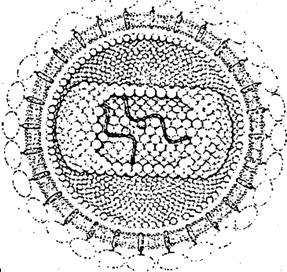
The picture below shows how the HIV looks like under a microscope.
TRANSMISSION OF HIV
- sexual intercourse
- infected blood and organs
- mother-to-child transmission (MTCT) or parent-to-child transmission (ptct)
PREVENTION OF HIV TRANSMISSION
- receiving screened blood
- abstaining from sexual intercourse
- being faithful to one uninfected partner
- correct and consistent use of condoms
RISKY BEHAVIOURS THAT CAN LEAD TO THE SPREAD OF HIV
- having multiple sexual partners
- having unprotected sexual intercourse
- having STIs
- using unsterilised skin piercing instruments
- receiving infected blood
- abusing drug and alcohol
- assuming that their partner is HIV negative by appearance
VULNERABLE GROUPS TO HIV INFECTION
- mobile persons
- prostitutes
- street children and orphans
- poor or unemployed people
- adolescents
- communities which practice traditions which promote HIV transmission
The vulnerable groups are groups of people which are likely to be exposed to HIV infections due to their behaviour
MOTHER-TO-CHILD TRANSMISSION (MTCT) OR PARENT-TO-CHILD TRANSMISSION (PTCT)
HIV can be transmitted to a baby during pregnancy, delivery and breastfeeding.
The risk of transmitting the virus to the baby is greater if:
- the mother acquired infection during pregnancy
- the mother is in advanced stage of AIDS
- when the baby is in contact with infected blood during delivery
- the delivery is premature
- the baby is breastfed more than six months
- beastfeeding is mixed with other liquids or solids
PREVENTION OF MOTHER-TO-CHILD TRANSMISSION
- preventing babies from getting HIV from their infected mothers
- preventing women and girls of reproductive age from becoming infected with HIV
- preventing pregnancies among HIV positive women
- preventing HIV transmission during pregnancy, delivery and breastfeeding
- placing HIV positive pregnant women on anti-retroviral drugs and the drug being given to the new born babies
- using caesarean operation
- giving mothers information on feeding
THE IMPORTANCE OF PREVENTING MOTHER-TO-CHILD TRANSMISSION (PMTCT) AS A FIGHT AGAINST HIV AND AIDS
It is important to prevent mother-to-child transmission so that babies are born HIV free.
THE ROLE OF THE COMMUNITY IN THE PREVENTION OF MOTHER-TO-CHILD TRANSMISSION
- encouraging HIV positive pregnant women to go for guidance and counselling
- encouraging HIV positive pregnant women to take ARVs and not to breastfeed
- avoiding discriminating against people living with HIV and AIDS
- providing care and support to women, children and families infected and affected by HIV and AIDS
- encouraging both parents to go for HIV testing and counselling (HTC)
- conducting awareness campaigns on prevention of HIV and AIDS
UNIT 2 GENDER AND HIV AND AIDS
HOW STEREOTYPED EXPECTATIONS SHAPE THE LIVES OF WOMEN AND GIRLS IN TERMS OF HIV AND AIDS
Women are often described as being weak in body and mind, emotionally dependent, passive, uncompetitive, and that they lack confidence in themselves.
It is therefore said that they are not fit to assume leadership positions.
Because of the emphasis on the biological roles of women, they are supposed to be attractive, reproductive, pleasant as compared to men, who claim to be tough and competitive.
These stereotyped expectations that shape the lives of women, may be a justification in the minds of some men.
Such people take advantage of those expectations to harass, abuse and rape women. This may be one of the reasons why many women contract HIV.
WOMEN AND GIRLS EMPOWERMENT ON HIV AND AIDS ISSUES
Education empowers boys and girls, men and women to become aware of their rights and make decisions that improve their lives, families an communities.
It is an agent that can change the practices that might hinder social-cultural and economic development.
It also improves the health status of women and their families and it is also a vaccine to HIV. Through education, women and girls can be empowered on HIV and AIDS issues.
FACTORS THAT MAKE WOMEN AND GIRLS MORE VULNERABLE TO HIV INFECTION
- women are culturally not empowered to negotiate for safer sexual intercourse with men
- since women are perceived to be weak and passive they may be raped by men who claim to be tough
- since one of the women's roles in the household is said to be attending to the sick, they can easily contract HIV if they are not careful
- culturally women have low economic status, as a result, they may always depend upon men to provide them with resources in exchange for sex
WAYS OF DEALING WITH HIV AND AIDS IN RELATION TO GENDER
- educating both men and women on the negative effects of gender biases, inequality and imbalance
- educating both men and women on the importance of respecting human rights and dignity
- educating both men and women on the need to be assertive so that they can stand up for themselves without being aggressive
UNIT 3 SEXUALITY
FACTORS THAT INFLUENCE SEXUALITY
- parents
- religion
- migration
- environment
PHYSICAL AND PSYCHOLOGICAL CHANGES DURING ADOLESCENCE
As boys and girls are growing up, they experience changes in their bodies. These changes influence them emotionally and may cause anxiety.
The changes are influenced by the production of sex hormones.
The sex hormones are known as testosterone in boys and oestrogen in girls.
PHYSICAL AND PSYCHOLOGICAL CHANGES IN BOYS
Physical changes |
Psychological changes |
|
|
|
|
PHYSICAL AND PSYCHOLOGICAL CHANGES IN GIRLS
Physical changes |
Psychological changes |
|
|
HOW SEXUALITY AFFECTS ADOLESCENTS' BEHAVIOUR
- becoming more aware of their sexuality
- thinking continually whether or not they are sexually attractive
- thinking continually whether or not someone will love them
- thinking continually whether or not they will be able to have children
- experiencing sexual and social urges and develop special interest in members of the opposite sex
- becoming sensitive to their body height and weight
SOME EMOTIONAL CHANGES ADOLESCENTS MAY EXPERIENCE BETWEEN 8 AND 19 YEARS
Early adolescence (8 – 12 years in girls, 10 – 14 years in boys)
- start to associate with peers
- unstable in character
- strive for independence and self identity
- may be confused and get pre-occupied with own body
- may experiment sexual behaviour with members of same sex
- begin to think in abstract terms
Middle adolescence (13 – 16 years in girls, 14 – 17 years in boys)
- continue to develop self identity
- become idealistic and willing to help others
- interested in the members of opposite sex and possibly experiment sex
- experience intense emotions
- continue thinking in abstract terms
Late adolescence (16+ years in girls, 17+ years in boys)
- strive to be independent
- establish self image
- love more realistically and develop commitment
- more selective when associating with friends as peer group becomes less important
- develop a more consistent framework of values, morals and ethics
- define life goals
PROBLEMS ASSOCIATED WITH ADOLESCENTS' SEXUALITY
- engaging in risky behaviour such as pre-marital sexual intercourse
- associating with particular peers preferably of the same age and starting to take drugs because their peers may be doing the same
THE EFFECTS OF PROBLEMS ASSOCIATED WITH ADOLESCENTS' SEXUALITY
Problems |
Effects |
unwanted pregnancies |
early marriage abortion |
Abortion |
becomes sterile |
drug and substance abuse |
violence |
|
contracting STIs including HIV and AIDS |
HOW LIFE SKILLS CAN ASSIST ADOLESCENTS TO COPE WITH CHALLENGES ASSOCIATED WITH SEXUALITY
It is important that boys and girls are equiped and empowered with knowledge and skills to enable them cope with problems associated with sexuality.
Life skills are essential for moulding their character, attitudes, values and interests.
So that they develop a sound and healthy body in order to enjoy physical, mental and emotional health.
Therefore adolescents can deal with aspects of their sexualty more effectively if they are given sufficient and correct information and are properly guided and counselled on sexuality issues;
And are able to use some of the following life skills:
- decision making and problem solving
- self esteem
- self awareness
- stress and anxiety management
- assertiveness
- negotiation
- conflict resolution
- effective communication
- interpersonal relationships
- critical thinking
- empathy
THE IMPORTANCE OF ADOLESCENTS HAVING CORRECT INFORMATION ON SEXUALITY
It is important for adolescents to understand the changes that take place in their bodies to be aware of the social pressures that arise.
This will enable them cope with the changes taking place in their bodies and they will be able to make informed decisions
Thus, they will avoid contracting HIV or engaging in pre-marital sexual activities which may lead to unwanted pregnancies and other problems.
UNIT 4 HOME BASED CARE AND SUPPORT
DISCHARGE PLANNING AND REFERRAL PROCESSES
- Discharge planning
Discharge planning is a process of preparing people with chronic illnesses, their families and the community to take care of the sick when they are out of hospital.
As the discharge is being planned, the patient and the care providers may consider the following:
- how to take care of the patients in their homes
- how to counsel and give comfort
- how to give medicines
- what to do when the patient gets sick
- Referral processes
Referral process is when people with chronic illnesses are referred back to the hospitals or health centres in the event that their condition worsens.
They can also be referred to private clinics, traditional healers, traditional birth attendants, home based care providers, health workers,volunteer groups, charity as well as religious organisations.
HOW TO CARE FOR PEOPLE WITH CHRONIC ILLNESSES
- providing them with nutritious foods
- bathing them regularly
- washing and ironic their clothes
- seeking medical attention
- giving them moral and spiritual support
- loving and comforting them
SUPPORTING THOSE WHO CARE FOR THE CHRONICALLY ILL
Those who care for the chronically ill can be individuals or organisations.
These care providers have a big task of looking after the sick and vulnerable person. As a result, they may become stressed and anxious.
Therefore, they need support from the family, community and other institutions.
Support for the care providers can be given through the provision of emotional, material, moral and spiritual support.
UNIT 5 DRUG AND SUBSTANCE USE AND ABUSE
Drug is a substance used as medicine.
Such drugs may be panado, aspirin and any pain killer
Substance is any kind of matter such as coffee, drinks, tobacco, water and alcohol. Abuse means using something wrongly.
EFFECTS OF ABUSING DRUGS AND SUBSTANCES
- loss of interest in school resulting in school dropout
- stealing
- prostitution
- poor judgement
- mental disorders
- practising unprotected sex
- poor health
- committing suicide
- social problems
- temporal feelings of excitement or highness
- promiscuity
THE IMPORTANCE OF COUNSELLING THOSE ADDITED TO DRUGS AND SUBSTANCES
- bringing rehabilitation to those who are deep into the problem
- allowing them achieve their goals in school life
- helping them live normal and useful lives in their families and community
- providing support and advice to those with the problem
WAYS THAT CAN ASSIST DRUG AND SUBSTANCE ABUSERS TO STOP THEIR HABITS
- seeking medical help
- approaching counsellors with your problem and be honest about it
- finding another hobby to replace drug and substance abuse
- getting support from friends and family members
- avoiding people that are abusing drugs and substances
WHY SOME PEOPLE FIND IT DIFFICULT TO STOP ABUSING DRUGS AND SUBSTANCES
- some of them claim that they are happy when using drugs and substances and do not want to stop
- some deny having such a problem
- some become addicted to these drugs and substances
- others do not want to lose friends who happen to have the same habit
- they would like to show off to others that they are important
UNIT 6 INTERPERSONAL RELATIONSHIPS
Interpersonal relationship is when people interact with one another in different ways.
TYPES OF INTERPERSONAL RELATIONSHIPS
- Relationships within the family
- Relationships among peers
- Relationships among juniors and seniors
- Relationships between and among males and females
- Kinship
- Ethnic
- Cultural ties
FACTORS THAT MAY ENHANCE RELATIONSHIPS
- love
- empathy
- economic status
- respect
- effective communication
- politeness
- tolerance
- care
- gender sensitivity
- observation of human rights
- honesty
- cooperation
FACTORS THAT DESTROY RELATIONSHIPS
- envy
- dishonesty
- gossip
- jealousy
- poverty
- violence
- sexual harassment
- poor communication
- rudeness
- disrespect
- unfulfilled promises
- gender inequality
- theft
- lies
- property grabbing
- change of status
- witchcraft
- abuse of human rights
ROLES AND RESPONSIBILITIES IN A RELATIONSHIP
- sharing resources
- advising and counselling one another
- showing compassion
- encouraging one another
A role is the function that one has or is expected to perform whilst a responsibility refers to a duty to take care of somebody or something so that you are accountable or answerable.
UNIT 7 EFFECTIVE COMMUNICATION CONCERNING HIV AND AIDS MESSAGES
Effective communication is the sending and receiving of information from one point to another in a clear manner.
FACTORS THAT MAY ENHANCE EFFECTIVE COMMUNICATION CONCERNING HIV AND AIDS MESSAGES
- empathy
- effective channel of communication
- tolerance
- adherence to human rights
- respect for others
- interpersonal relationships
- patience
FACTORS THAT MAY DESTROY EFFECTIVE COMMUNICATION CONCERNING HIV AND AIDS MESSAGES
- religion
- cultural factors
- education attainment
- age generation gap between people
- stress and anxiety
THE IMPORTANCE OF EFFECTIVE COMMUNICATION CONCERNING HIV AND AIDS MESSAGES
- promoting perception, beliefs and attitudes that can assist one from indulging in risky behaviours that might lead to contracting HIV
- dispelling myths and misconceptions on various issues which are found among people
- increasing knowledge and promoting positive behaviour in relation to STIs.
LIFE SKILLS THAT CAN BE USED IN EFFECTIVE COMMUNICATION
- creative thinking
- listening
- negotiation
- decision making
- self esteem
- empathy
- assertiveness
UNIT 8 PEER GUIDANCE AND COUNSELLING
Peer counselling is what happens when a friend of the same age, class, school or group listens and helps another friend on how to solve problems.
The peer counsellor's role is not to solve problems for their friends but helping them find solutions to their own problems.
It is up to the person who is being counselled to choose the right way of solving his or her problems.
IMPORTANCE OF PEER GUIDANCE AND COUNSELLING
- the learners can learn to communicate effectively with friends of the same age and interest
- the learners appreciate some experiences of talking to each other
- the learners understand other people's feelings since they may have been in a similar situation as that of the friend who would be a client at that particular time
- the learners understand one another effectively and as a result can guide each other on different areas including study skills
FACTORS TO CONSIDER WHEN ORGANISING PEER GUIDANCE AND COUNSELLING GROUPS
- choosing members of the groups
- number of people per group
- how often a group should meet
- venue for the meeting
DEVELOPING PLANS FOR PEER GUIDANCE AND COUNSELLING CLUBS
There are several points to be considered when developing plans. Some of these are:
- creating trust in the members of the groups
- helping members to establish their own goals
- identifying members with different talents such as leadership
- creating norms for groups
- creating monitoring and evaluation procedures
UNIT 9 STRESS AND ANXIETY
THE IMPORTANCE OF MANAGING STRESS AND ANXIETY
- it enables one to avoid contracting HIV and live a happy life
- it enables one to avoid risky behaviours
- it enables one to have interest in life
- it enables one to have interest in learning
- it enables one to avoid dropping out of school
- it enables one to avoid poverty
THE EFFECTS OF STRESS AND ANXIETY
- mental disturbance
- mental confusion
- heart failure
- high blood pressure
- ulcers
- violence
- depression
- theft
HOW TO MANAGE STRESS AND ANXIETY
- seeking guidance and counselling
- seeking medical help
- engaging in physical exercises
- eating appropriate food
- having plenty of rest
- having a positive attitude to the problems
UNIT 10 PEACEFUL CONFLICT RESOLUTION
IMPORTANCE OF RESOLVING CONFLICTS PEACEFULLY
- promoting peace and unity
- promoting cooperation and development
- creating good relationships among people
- promoting human dignity
- preventing violence thereby protecting property and life
WAYS OF RESOLVING CONFLICTS PEACEFULLY
- Negotiation
Negotiation is a process where people who are involved in conflicts come together and talk to each other about the conflict.
- Mediation
Mediation is a process where two persons who are in conflict involve a third person to help them come up with the solution to the problem. This person is called a mediator.
The mediator does not decide on the case. He or she simply helps in arriving at a solution.
- Arbitration
Arbitration a process similar to mediation, however, the third person that is involved is called an arbitrator. The arbitrator acts like a judge as he or she gives the final judgement as to who is right and who is wrong.
EFFECTS OF NOT RESOLVING CONFLICTS PEACEFULLY
- atmosphere of mistrust, suspicion and hatred is created
- violation of human rights
- loss of life
- may lead to famine
- destruction of property
- insecurity
UNIT 11 DECISION MAKING AND PROBLEM SOLVING
People react and deal with problems differently.
When faced with a problem, the following steps could be tried to solve the problem:
- identifying the problem
- defining the problem
- explaining possible solutions and outcomes
- examining consequences of the choices
THE CONSEQUENCES OF MAKING RUSHED DECISIONS WHEN SOLVING PROBLEMS
- the problem might grow bigger instead of getting smaller
- it might lead to regrets if decisions made prove to be poor
- it might result in people fighting
- the problem may keep resurfacing
SITUATIONS DEPICTING WELL THOUGHT OUT DECISIONS WHEN RESOLVING CONFLICTS
- people solving their problems and reaching a peaceful compromise
- all the concerned parties feeling satisfied with the decisions
- the problem may not resurface
UNIT 12 SELF ESTEEM AND ASSERTIVENESS
Self esteem is an awareness of good in oneself. Self esteem can be low or high.
THE IMPORTANCE OF HAVING HIGH SELF ESTEEM
- one does things with a lot of interest and is eager
- one thinks positively and always hopes for the better
- one has ambition which can help him or her achieve his or her goals in life
- one cooperates with others when doing team work
- one has a humble attitude of mind without wishing to appear boastful
- one has respect for self and others
- one is kind to others
- one takes responsibilities for his or her actions
Assertiveness means knowing what you want, why and being able to take the necessary steps to achieve what you want.
THE IMPORTANCE OF ASSERTIVENESS
- one is goal oriented
- one is honest with oneself and others
- one is able to speak for oneself
- one is able to take responsibility for feelings and needs
- one is able to maintain his or her identity
- one is able to defend oneself and avoid social and health problems
- one is able to promote honest relationships
- one is self-confidenct
- one is capable of enhancing his or her self esteem
FACTORS THAT DESTROY SELF ESTEEM AND ASSERTIVENESS
- poor upbringing
- negative comments
- lack of positive role models
- lack of sense of connection and relationships to others
- lack of sense of one's own uniqueness and value
- lack of confidence
- having the belief that you cannot achieve anything
WAYS OF REBUILDING SELF ESTEEM
- discovering one's strengths and weaknesses
- developing positive thinking
- understanding oneself
- examining and analysing one's thoughts and actions
- defining one's priorities
- positive comments
- establishing gender identity
- having a positive attitude towards problems or challenges
UNIT 13 SEXUAL HARASSMENT AND ABUSE
SEXUAL HARASSMENT
Sexual harassment is an act of a sexual nature upon or with a child or any other person without his or her consent.
Sexual harassment happens when someone feels uncomfortable about comments, looks and touch from another person.
The harassed person may be forced into a sexual behaviour that might be visual, verbal or physical. SEXUAL ABUSE
Sexual abuse takes various forms such as
- an adult having sexual intercourse with a child
- forced marriage
- early marriage
- touching a child's private parts
- making a child touch someone else's private parts
- showing a child pornographic pictures, videos or films
- making a child naked for the sexual excitement of the abuser
- having sex in the presence of a child
- making a child or girl earn money by having sex with someone else
- having sex with many different people
CAUSES OF SEXUAL HARASSMENT AND ABUSE
- low socio-economic status of women and girls
- male aggressiveness to females
- break-up of families
- peer pressure
- cultural pressure
- dressing in a way that would make others desire them sexually
- drinking alcohol and taking drugs
- traditional dances which are suggestive and seductive in nature
- orphanhood
- beliefs about how to get cured of HIV and AIDS
DANGERS OF SEXUAL HARASSMENT AND ABUSE
- unplanned pregnancies
- contracting sexually transmitted infections
- destruction of one's self esteem
- dropping out of school
- the abused may become confused and angry towards the abuser
WAYS OF PREVENTING SEXUAL HARASSMENT AND ABUSE
- empowering boys and girls with life skills that can help them protect themselves
- schools should have rules that help prevent the act
- children should be advised to go and come back from school in groups
- learners should avoid being alone in isolated places
- children should be advised to report to their parents, guardians, police or community leaders any cases of sexual harassment
- learners should dress properly
- learners should be warned of sexual abusers
- learners should avoid drug and alcohol abuse
RESPONSIBLE PEOPLE OR ORGANISATIONS TO WHOM CHILDREN CAN REPORT CASES OF SEXUAL HARASSMENT AND SEXUAL ABUSE
- parents
- uncles
- aunts
- guardians
- community leaders
- teachers
- church elders
- education officials
- victim support unit of the police
- social welfare
- health centres
UNIT 14 ENTREPRENEURSHIP AND HIV AND AIDS
Entrepreneurship is business through which one can generate income for meeting various needs.
It includes activities such as tailoring, chicken rearing, wood and rock carving, mat making, fishing, traditional painting artwork, pot making and weaving.
It is a form of informal employment
IMPORTANCE OF ENTREPRENEURSHIP
- it enables one to generate income
- it helps one to improve one's quality of life
- it can prevent one from engaging in risky behaviours
- it keeps the person occupied
APPROPRIATE ENTREPRENEURSHIP SKILLS
- planning
- budgeting
- marketing
- communication
- negotiation
- assertiveness
- problem solving
- decision making
- creative thinking
APPROPRIATE SKILLS IN FINANCIAL MANAGEMENT IN ENTREPRENEURSHIP
- development of personal and family financial management plan (budget)
- keeping track of the expenditure made in a week or month and establishing expenditure pattern
- reducing buying items that continue to drain finances (liabilities), but buying resources that generate extra resources (assets)
- having a personal or family saving plan
- getting into financial management school and learning how to manage finances
THE EFFECTS OF GENDER ROLES IN ENTREPRENEURSHIP
In Malawi, men and women tend to perform different gender roles.
These roles have an effect on the type of entrepreneurship activities that men and women engage in.
For example, women tend to engage in small scale businesses while men tend to engage in large scale businesses
Because of this gender role difference, women tend to be given less money from lending institutions unlike men who are given large amounts of money.
However, both men and women need to do business activities without any discrimination.
UNIT 15 ANTI-RETROVIRALS (ARVs)
Meaning of anti-retrovirals (ARVs)
Anti-retrovirals are drugs that work by stopping the replication of the virus that causes AIDS. These drugs reduce the amount of virus in the blood because they make the virus inactive. Therefore, it does not multiply.
This slows down the damage to one's immune system.
HOW ARVs WORK
ARVs work by preventing HIV from making copies of or multiplying itself.
People living with HIV take different types of ARVs that work in different ways depending on what their doctors think will help them the most.
All ARVs interfere with key steps in the viral life cycle and stop the virus from reproducing. If HIV cannot reproduce, the amount of HIV in a person's body goes down.
The immune system then has a chance to become stronger again.
If one's immune system is functioning properly, his or her body is less likely to become sick. It is important to follow the doctor's instructions when one is on ARV treatment.
SIDE EFFECTS OF ARVs
- diarrhoea
- tiredness
- prolonged headaches
- loss of appetite
- vomiting
ROLE OF FOOD DURING ARV TREATMENT
- strengthening the body's ability to fight diseases
- reducing opportunistic infections
- slowing progression of HIV and AIDS
- complementing ARVs actions
- improving the effectiveness of medication
- managing side effects of the drug
INSTITUTIONS WHERE TO ACCESS ARVs
- district hospitals
- health centres
- mission hospitals
- private hospitals
UNIT 16 ORPHANS AND VULNERABLE CHILDREN
An orphan is a child under the age of 18 years who has lost both parents. There are many orphans in Malawi as a result of HIV and AIDS pandemic. These orphans are found in villages, streets, towns and cities.
Vulnerable children are children who are weak, not well protected, easily attacked and have nobody to take care of them.
They lack basic needs such as food, clothes and shelter.
As a result, people of ill-will take advantage of the situation in which children are and begin to abuse them.
NEEDS OF ORPHANS AND VULNERABLE CHILDREN
- food
- clothes
- beddings
- shelter
- money
- love
- respect
- moral and spiritual support
- education
- guidance and counselling
WAYS OF ASSISTING ORPHANS AND VULNERABLE CHILDREN
- providing them with material resources
- supporting families and organisations which protect and care for orphans and vulnerable children
- mobilising communities and well-wishers to take leading roles in protecting and caring for orphans and vulnerable children
- loving and respecting them
- training them in vocational occupation for self-reliance
- sensitising them on the dangers of involving themselves in risky behaviours
- providing them with spiritual and moral support
- supporting child-headed families with various resources
- encouranging them to acquire education
GLOSSARY
Caesarean section: delivering a child through operation
Delivery: a process of giving birth
Stigma :being rejected, ridiculed or laughed at by the community or friends Susceptible – easily get affected
Promiscuous : having many sexual partners
Empower :giving power to someone
Gender equality : treating both males and females equally
Gender equity: the principle of fair treatment
Gender inequality : treatment that favours one sex over another
Sexuality : total expression of who one is as a human being - male or female
Adolescence : a period between ages of ten and eighteen years
Adolescent : a boy or a girl who is between ten and eighteen years
Chronic illness : long illness
Unprotected sex : sexual intercourse where a condom is not used
Compassionate :loving and caring
Eventually : whatever may come
Sustain: maintain
Disseminating : passing on information
Counselling: a helping relationship between a client and a counsellor where the client is helped to make an informed decision
guidance : the act of assisting one to understand, accept and use their abilities, aptitudes and interests in relation to their aspirations
Anxiety : the state of feeling nervous or worried that something is going to happen
Stress : pressure or worry caused by the problems in one's life
Peaceful conflict resolution: bringing a disagreement or argument to an end using non-violent means Problem solving : ability to understand and deal with something tat is difficult
Decision making : making up one's mind; making choices
Financial management: ability to use, save and account for financial resources
Anti-retrovirals: drugs which act against retroviruses such as HIV
Mutate : change
Vulnerable children: children who are weak, not well protected and easily attacked
REFERENCES
MIE (2008) Life Skills Teacher’s Guide for Standard 8, Domasi; MIE. MIE (2008) Life Skills Learner’s Book fo